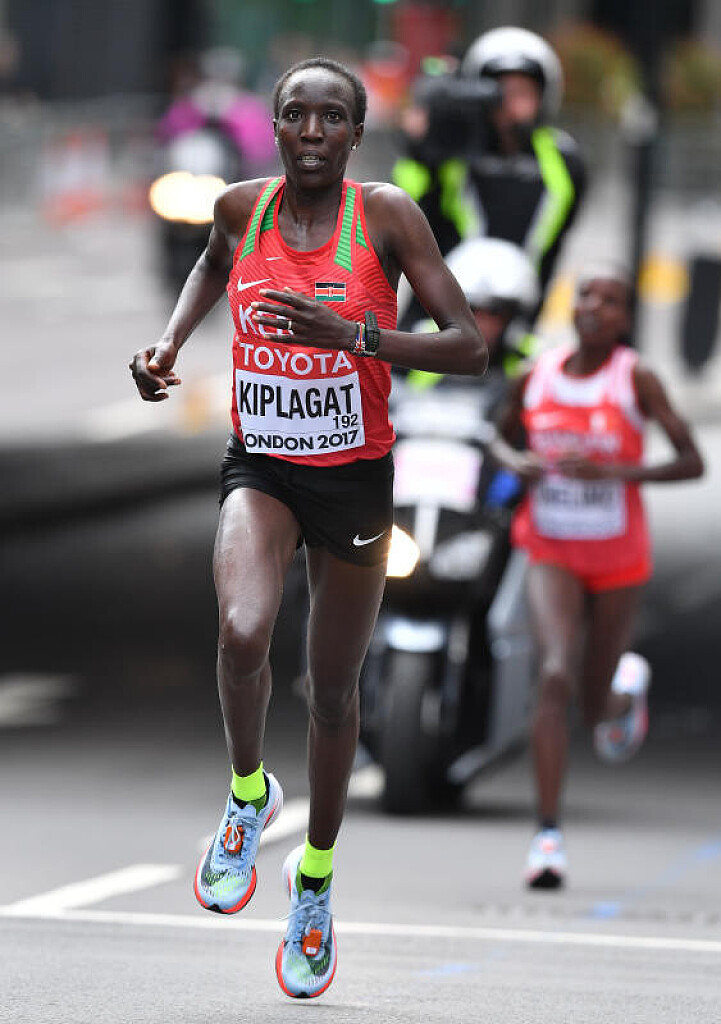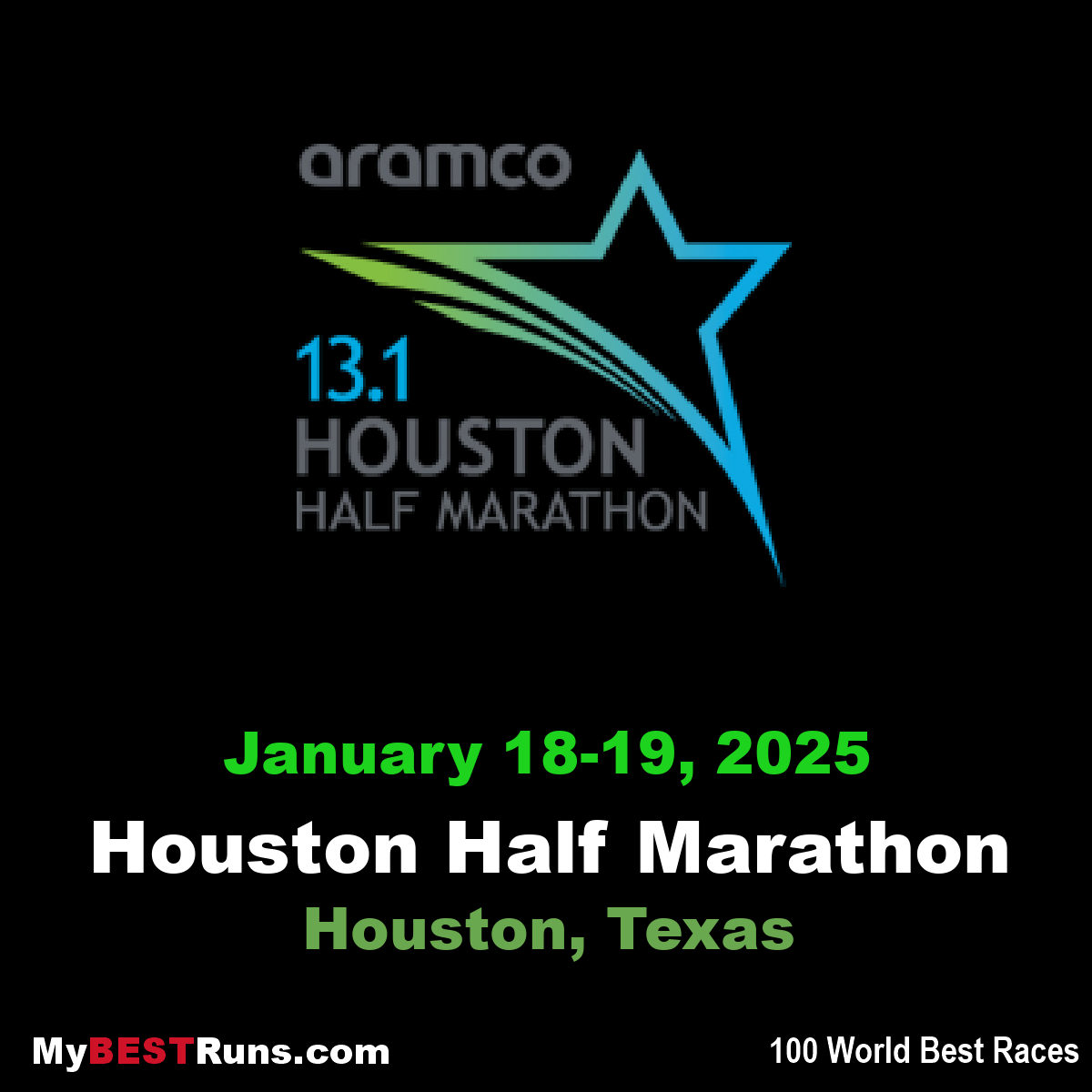Running News Daily
Running News Daily is edited by Bob Anderson. Send your news items to bob@mybestruns.com Advertising opportunities available. Train the Kenyan Way at KATA Kenya and Portugal owned and operated by Bob Anderson. Be sure to catch our movie A Long Run the movie KATA Running Camps and KATA Potato Farms - 31 now open in Kenya! https://kata.ke/
Index to Daily Posts · Sign Up For Updates · Run The World Feed
91-year-old Italian woman Emma Maria Mazzenga speeds to age-group 200m world record
Emma Maria Mazzenga of Italy is etching her name in track and field history at the age of 91. Competing in the W90+ category at a Masters event in Veneto, Italy last weekend, she clocked an incredible 54.47 seconds for 200m indoors, shattering the world record by five seconds.
Mazzenga maintained an impressive speed of 13 km/hr for the 200m distance. Achieving such a feat is astounding, considering most would be content just to reach the age of 91, let alone set a new age group world record with a pace of 4:30/km. What adds to the awe of Mazzenga’s accomplishment is her incredible comeback. According to Vogue Italy, she started training just a month before her Jan 14 race, following a sternum fracture.
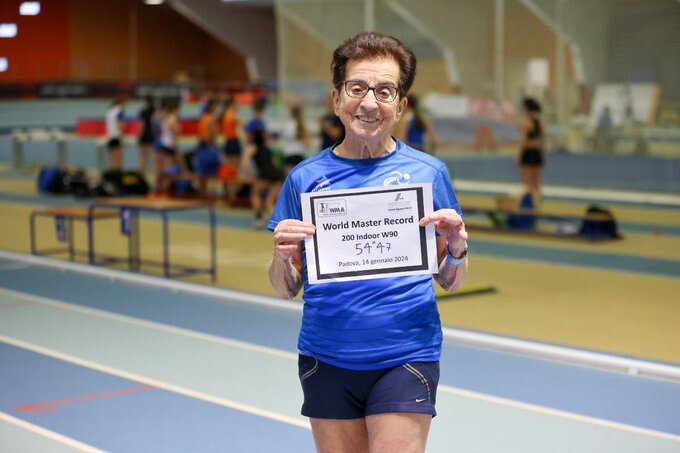
The former 200m indoor record for the W90+ category stood for 13 years and belonged to Canadian masters legend Olga Kotelko. Kotelko, who passed away in 2014 at the age of 95, held over 30 world records and won more than 750 gold medals in the masters competitions.
Mazzenga, a retired chemistry professor from northern Italy, only started competing masters races at the age of 53. Now, at 90, she continues to defy norms and set records. A video of her record-breaking run has gone viral on TikTok and Instagram.

Mazzenga told Vogue Italy that her secret to success is elegantly simple: she never stops. Each morning, Mazzenga takes a walk with her friend, interspersed with biking between her walks and runs. “The emotion that a race gives me, the adrenaline I get every training session, it brings energy to my days,” Mazzenga shared with Vogue Italy.
Despite setting a world record, Mazzenga remains humble and confident that she can achieve even faster times at her upcoming races at the Italian Masters Championships in Ancona, Italy, and the European championships in Torun, Poland, scheduled for March.
(01/20/2024) ⚡AMPby Marley Dickinson
How An Old Drinking Fountain Revived New York’s Marathoning and Pasta Club
The group is all about logging slow miles and consuming carbs—in that order.
In New York’s Central Park, at West Drive and 92nd Street, is a nondescript drinking fountain made of black granite. Blink as you run past, and you’d miss it, but this particular fountain, inscribed in 1991 with an ivy garland and the words “72 Street Marathoning and Pasta Club” around its rim, has recently gained interest from a new generation of runners and inspired them to take up the mantle of distance running and carb loading.

Amanda Smith stumbled upon the fountain in 2020, during the early days of the COVID-19 pandemic, and was inspired by the inscription. “As a foodie who loves to run, nothing more closely aligns with my lifestyle than that!” she wrote on Reddit. Smith snatched up the Marathoning and Pasta Club handle on Instagram posthaste, knowing she wanted to do something with it in the future—three years later, her dream has come to fruition.
A few weeks ago, Smith gauged interest for an all-new run club devoted to sharing easy miles followed by “family style” meals afterwards. People loved the idea. The group got together for their first outing on Thursday night: Five runners showed up for a loop of Central Park, chatting and getting to know each other, before tucking into orders of rigatoni carbone on the Upper West Side.
“It was really nice to just have a conversation, and everyone’s kind of sharing the role that running plays in their lives,” Smith told Runner’s World.
The original Marathoning and Pasta Club traces its history back to the 1970s, when its members, in addition to their love of running and spaghetti, were dedicated stewards of Central Park, often planting trees and cleaning and restoring water fountains. One of the seven original members is Jonathan Mendes, a World War II Marine who in 2016, at 96 years old, was believed to be the oldest unofficial finisher of the New York City Marathon, completing the race in 11 hours and 23 minutes. Carl Landegger, 10 years Mendes’ junior, was another founding member, and was running marathons with his friend as recently as 2010.
Smith laughs that the initial club was comprised of serious runners who competed around the world, clocking impressive times. Her iteration of the Marathoning and Pasta Club is more of a nod to the originals. The new club is truly pace inclusive and spans all five New York City boroughs. Next week they’ll be meeting in Brooklyn’s Prospect Park before heading to Pasta Louise Cafe in Park Slope.
You don’t need to be a marathoner to join the club, and unlike many other groups, there’s no minimum pace required.
“I hope people feel comfortable to come because it isn’t about competitions,” Smith said. “You don't need to be training for anything. We had people last night who just like to run, and they’re not interested in running a marathon and that’s totally fine.”
Some nights, Smith says they may even skip the run and just bond over pasta. She sees a real need for clubs based around recovery-pace runs and community.
Fusilli and farfalle sound fun? You can stay up-to-date on the happenings of the Marathoning and Pasta Club on their Instagram page.
(01/20/2024) ⚡AMPby Runner’s World
47-Year-Old Marathoner to Run Fifth Olympic Trials
Dot McMahan qualified with a 2:35:20 at Grandma’s Marathon, averaging 5:56 per mile pace.
In the closing miles of the 2023 Grandma’s Marathon, last June in Duluth, Minnesota, Dot McMahan struggled to calculate how close she was to the Olympic Marathon Trials standard.
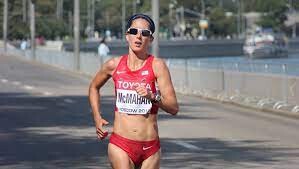
“I was just trying to run under 2:37, but you know, math, when you’re running a marathon, isn’t always so good,” she said.
McMahan was more than fine. In her 20th marathon, she ran 2:35:20, smashing the standard and qualifying for her fifth Olympic Marathon Trials.
Her coach, Kevin Hanson, of Hansons-Brooks Distance Project, was ecstatic. And so was her husband, Tim, and their 14-year-old daughter, El, who is also a runner. El told her mom when they FaceTimed after the race that she had run her fastest time since turning 40. “She knew all my stats,” McMahan said. “She was over the moon.”
McMahan, 47, and Des Linden, 40, are thought to be the only female athletes in the field running a fifth marathon trials. McMahan is the oldest women’s qualifier. On the men’s side, Fernando Cabada, 41, has qualified for five marathon trials and is entered in the race. Abdi Abdirahman, a five-time Olympian, is also 47, the oldest in the men’s field.
It was never a given that McMahan would make a fifth trials, especially after USA Track & Field announced in late 2021 the tougher entry standards for the 2024 race. For the 2020 race, held in Atlanta, women had to run 2:45 to make the Trials. This time around, they had to be 8 minutes faster.
“I was very supportive of the fact that they needed to make it quicker, for the women, at least,” she said. “It kind of loses its luster if we make it too easy. That said, I think it was a little harder than I [predicted], which was maybe 2:40, 2:39. So 2:37 was like, woah, okay, we’ve got a real goal here. I never assumed that was going to be a walk in the park.”
McMahan, who was eighth at the Trials in 2008 and ninth in 2012, knows she’s unlikely to finish that close to the front again, unless something unexpected happens in Orlando. While her teammates have moved to Orlando for the month to prepare for potential heat and humidity, McMahan is still training in Rochester Hills, Michigan, where she works as an assistant track coach at nearby Oakland University and has a pet sitting business. (She’s also an online coach with McKirdy Trained.)
And she wants to be home with her family. McMahan’s only warm weather preparations at the moment are the occasional treadmill run. “It’s in a space that we can enclose a little more and turn the heat up,” she said. But simulating humidity “gets a little tricky. You don’t want to grow a bunch of mold in your house.”
That’s typical of the practicality McMahan brings to her training. Her longevity, she says, is a function of doing most of the same hard work she’s always done. She’ll reach 105–110 miles per week at her peak training for a marathon, and she’ll double three or four days per week. She used to run 120.
“I’ve tapered back a little bit, but I’m still doing the majority of it,” she said of the Hansons-Brooks training. “That’s what it takes.” On January 14, McMahan ran the Houston Half Marathon as a tuneup and finished in 1:16:02, averaging 5:48 pace. She was very happy with the result.
Hanson said he and McMahan frequently joke that she’s old enough to be the mother to some of the athletes on the team who are fresh out of college. But he notes McMahan’s durability. She has avoided serious injuries. “That’s what becomes career-ending in your 40s,” he said. “In your late 40s, any injury that sets you back sometimes ends things, because it’s just to hard to get back into it.”
McMahan is practical about other matters, too.
For one, she refuses to dye her hair. “I do have a considerable amount of gray hair,” she said. “I’m not doing anything about it; I’m just going to let it come in.” Plus, she said, her husband has gray hair. They’d look silly together if she dyed her hair and he didn’t. “We’re aging,” she said. “It’s just life.”
She devotes about an hour to getting ready for her morning runs—warming up, doing mobility exercises, and “making sure things are firing.”
When her pace slows on afternoon recovery runs, she doesn’t dwell on it. On December 26, she did a hard 20-miler. The next day, she was tired, and she had 10 miles in the morning, and 4 miles in the afternoon on the schedule. She did those runs, but she ran them slowly—for her.
“I think in the past, I would have beat myself up mentally looking at my watch and being like, ‘You’re running 8-minute pace; this is so ridiculous,’” she said.
Now, she thinks: Are you happy? Are you healthy? Does anything hurt? This is what recovery pace is for you. “I listen to my body, and I don’t get upset thinking it should be a certain pace,” she said. “That’s my concession to age.”
(01/20/2024) ⚡AMPby Runner’s World
This historic track froze into a skating rink
The West Coast of the U.S. and Canada got hit with sub-zero temperatures over the weekend as a cold front swept through the Midwest. Northern California and Southern Oregon reported unusual seasonal lows around -5 and -10 C, resulting in extreme cold that even froze over Hayward Field at the University of Oregon, transforming one of the most well-known tracks in the world into a skating rink.
Instead of wearing spikes for their Monday morning workout, the Oregon Ducks track and field team was seen skating on the track, turning their usual practice into more of a speed-skating session.
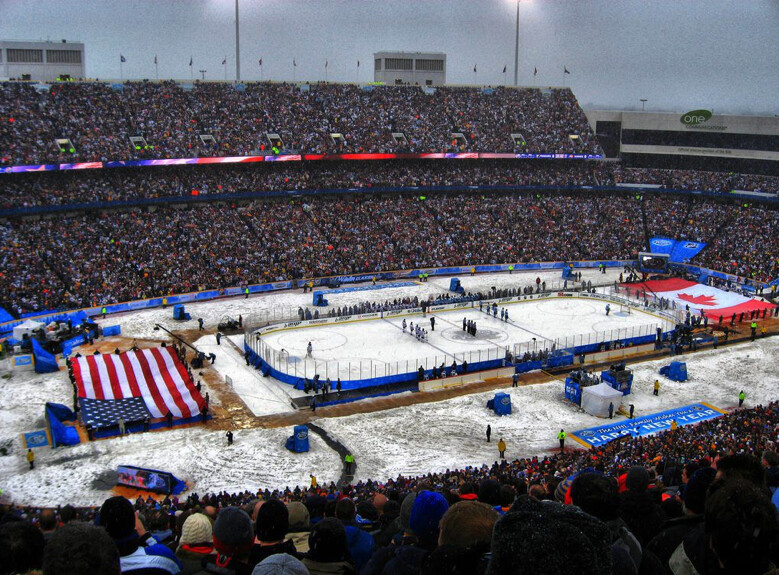

The video was posted to Oregon freshman Simeon Birnbaum’s Instagram story on Monday, where he was also seen sporting a Team Canada kit T-shirt. Although Birnbaum is from South Dakota, he has Canadian roots, having spent his early years in Alberta, where he learned to skate, according to Runnerspace. He transitioned from hockey to track in his early teenage years and is now a sub-four-minute miler with the University of Oregon track and field team under coach Jerry Schumacher.
The sight of people skating on Hayward Field has sparked a few ideas. First, envision an epic NHL Winter Classic game in that stadium. With a capacity of up to 25,000 fans and oval-shaped grandstands reminiscent of an NHL arena, the venue could provide an ideal setting and atmosphere for a game.
I know the recent Winter Classic between the Seattle Kraken and Las Vegas Golden Knights at MLB stadium T-Mobile Park in Seattle on Jan. 1 accommodated way more fans than Hayward, but let’s get NHL commissioner Gary Bettman on the phone to arrange a future Winter Classic matchup between the Seattle Kraken and L.A. Kings at Hayward.
The second idea involves Hayward Field hosting a long-track speed skating World Cup event in January or February. This cross-up between two of the most popular summer and winter Olympic events would be unreal. While I am no expert on speed skating, I would only think that having track-meet-style races could be highly entertaining, especially if wind or snow becomes a factor. Though the University of Oregon might not permit either event, it doesn’t hurt to start the buzz.
(01/20/2024) ⚡AMPby Running Magazine
Michael Bublé claims a near-death running experience in Manitoba
Canadian singing icon and proclaimed King of Christmas, Michael Bublé, claims he had a near-death running experience in Churchill, Man.On Jan. 15, Bublé appeared on The Kelly Clarkson Show, where former American Idol winner Kelly Clarkson asked the singer about a drunken late-night run gone wrong with Canadian actor Barry Pepper while shooting a movie in Canada’s tundra.Bublé said he had just finished filming the 2003 survival drama The Snow Walker and was celebrating with the cast. During the celebration, Pepper and Bublé decided to race down to the beach. But they didn’t realize what was waiting for them there.
“A guy that lived there just started swearing at us and just screaming, I mean, screaming bloody murder,” Bublé said. “We did not realize we were running to our certain death, because there were polar bears all down the beach.”“Sometimes I wonder how close I was to being like a little polar bear lunch,” he joked. “They are the most aggressive—God, but they are so cuddly.” Clarkson went on to reference the cute bears from Coca-Cola commercials.


As this story may not seem “Bublé-vable,” Churchill annually reports more than 300 polar bear incidents or encounters, so much so that they even built a polar bear holding facility (which they call the Polar Bear Jail), which captures and relocates troublesome or dangerous bears. Before it was built in 1983, polar bears that were considered dangerous were shot.Canada is home to two-thirds of the world’s polar bear population, and the Hudson Bay town of Churchill is a common feeding ground. The animals move toward the coast, and sometimes into town, from areas farther inland to hunt seals from the sea ice during the fall when temperatures drop.In 2014, Churchill’s Polar Bear Marathon had to alter the course because the bears got a little too close. Because of the danger from the cold and bears, each runner is assigned a support vehicle that carries food, extra clothing and a bear watcher equipped with a rifle, in case of an emergency.
(01/20/2024) ⚡AMPby Running Magazine
Run Before or After Workout to Maximize Gains
Strength training is an essential component of a well-rounded running training program, but for busy runners, it can be tricky to fit it into your program without jeopardizing your running workouts. Emma Vaillancourt, a registered physiotherapist and running coach in Thunder Bay, Ont., explains how to effectively incorporate strength training into your running routine to maximize gains and minimize burnout.
Should you strength train before or after running?

Vaillancourt explains that the order of strength training and running depends on your goals and where you’re at in your racing season. During the off-season, when running is less of a priority, you may choose to strength train first. In contrast, during the in-season, when your focus is on building running volume or intensity, running should usually come first.
If you plan to do strength training on days when you have intervals or speedwork, it’s generally better to do strength work after your run. This helps avoid fatigue and a possible negative impact on your workout. Vaillancourt also notes that running immediately before lifting can moderately impair lower-body strength gains. “If your goal is to improve strength, lift before the run,” she says. “If you aim to enhance endurance adaptations like aerobic capacity, the order doesn’t matter as much.”

Is it better to leave space sessions or can you do them back-to-back?
“It is recommended to allow at least three hours after high-intensity running before engaging in strength training,” says Vaillancourt. “During this recovery window, it’s important to refuel with a high-carb and protein meal to replenish your energy stores.”
Vaillancourt recommends at least 24 hours’ recovery after strength training before engaging in high-intensity running, but if you’re pairing strength training with easy runs, you can reduce the time between them.
Of course, most of us can’t plan our day around our strength training and running plans, so if scheduling becomes an issue, doing one activity right after the other is still beneficial. “Something is often better than nothing!” says Vaillancourt.
Alternatively, she suggests splitting your strength training into smaller blocks, focusing on shorter, more frequent sessions throughout your week. This approach causes less fatigue and can be more manageable for some runners. “The idea here would be to do 10 to 20 minutes of strength work (maybe two or three exercises) but more frequently in your week, compared to the traditional 30 to 60 minutes done two or three times per week,” she says.
How often should runners strength train?
The frequency of strength training depends on several factors, including your experience level, the point in the season, and the time you can commit to training in a week.
In the off-season and early season, Vaillancourt recommends strength training two to three times a week, focusing on higher volumes of training. “If you’re training for a single race, such as a half-marathon or marathon, you will likely want to drop down to one to two times per week as your mileage peaks,” she says. “As you get closer to your race and are entering your taper, you can drop to once a week for maintenance.”
Running before or after workouts has a drastic effect on training effectiveness. Running before a strength workout can compromise strength training gains or cause injury. On the other hand, doing a strength workout before running could cause running form to deteriorate, which can also lead to injury or compromise strength training gains.
Athletes only have so much time. Sometimes that means doing cardio workouts (like running) and strength workouts (like lifting weights or bodyweight workouts) on the same day. Find out if it’s better to run before or after workouts and how to maximize same-day training benefits.
The Interference Effect
Running Before or After Workouts Depends on Workout Goals
Run Before or After Workout as a Strength-Focused Athlete
Running Before or After Workout as a Runner
Running Before or After a Workout if the goal is to Lose Weight
Running Before or After a Workout if the Goal is to Improve Overall Fitness
THE INTERFERENCE EFFECT
The interference effect is a physiological phenomenon that states that cardio or endurance exercise (like running and cycling) interferes with the cellular adaptions elicited via strength training (namely, muscle size and overall strength). However, it also states that strength training does not appear to necessarily adversely affect endurance adaptations.
The keyword here is: necessarily. More on that later on.
RUNNING BEFORE OR AFTER WORKOUTS DEPENDS ON WORKOUT GOALS
Athletes engaging in concurrent strength training and running need to prioritize goals. This should happen on an individual workout basis as well as overall athletic goals. For example, someone looking to build muscle mass and overall strength must concede that cardio training will–to some extent–inhibit strength gains. On the other hand, a runner is unlikely to be a very successful bodybuilder.
Athletes considering strength training and cardio training need to decide which is more important for their athletic development: muscle mass or endurance. This is not to say that strength-based athletes should stop all cardio. Likewise, endurance athletes like runners should do some strength training.
The careful blending of strength and endurance training is what is known as concurrent training. Strength training–such as with weights or bodyweight–is an important component of endurance performance. Sports like running and cycling do not stress all the necessary muscles in the body. For example, simply running or cycling can leave one with hip, lower back pain and upper body issues due to underdeveloped muscles.
In short, most athletes should do a bit of strength training and a bit of cardio. The ideal blend of each will depend on the athlete’s goals: muscle mass or endurance.
RUN BEFORE OR AFTER WORKOUT AS A STRENGTH-FOCUSED ATHLETE
Athletes whose primary goal is to build muscle and overall strength should try to avoid doing cardio and strength training on the same day. If this cannot be avoided, strength-focused athletes should do their cardio workouts after strength training. This will help minimize the interference effect (i.e., the body will prioritize strength adaptations over endurance adaptations).
How long should cardio workouts take place after strength workouts? The longer the better. At least six to nine hours is ideal. Spacing strength and cardio workouts as far apart as possible will help maximize strength adaptations. Again, if pure strength is the primary goal, strongly consider doing cardio and strength workouts on entirely different days. Don’t do a hard strength workout and a hard (e.g., HIIT) running workout on the same day.
ALTERNATING LOWER-BODY AND UPPER-BODY SAME DAY WORKOUTS
Cardio exercises like running and cycling are lower-body dominant. Performing upper-body workouts on the same day as running will have no meaningful effect on the strength workout. However, performing lower-body strength workouts shortly after a running workout will likely lead to diminished strength gains.
It follows that doing lower-body strength workouts should then only take place on non-running days.
Alternating workouts with upper-body strength days during running days and lower-body strength workouts on non-running days will help minimize or even eliminate the interference effect. The only caveat to this is if the athlete can handle the higher training load. This means having an optimized nutrition plan (here’s the 9 best foods for runners and the 9 best foods to build muscle), resting and being sensitive to their body’s injury or overtraining signals.
RUNNING BEFORE OR AFTER WORKOUT AS A RUNNER
Strength training could be a key component to unlocking running performance. It may be the only way advanced runners can even achieve further progress. Beginner runners benefit from strength training by working muscles that help promote running economy and efficiency, which will ward off injury and promote total body fitness.
If running (or any endurance activity, such as cycling) is a primary goal, do cardio after strength training. However, if the cardio session will be shorter and low intensity (like a simple endurance run of 30-90 minutes), doing high-repetition, low-weight or bodyweight strength training AFTER running can help build muscular endurance and improve running stamina.
Muscular endurance is different than absolute strength. Whereas pure strength is about how much force one can produce quickly (e.g., during a squat), muscular endurance is about training muscles to resist fatigue over long periods of time. One can easily see how muscular endurance is beneficial to runners: running longer distances like half-marathons, marathons and even ultramarathons. Muscular endurance will allow runners to retain their running form longer, which means not only maintaining running economy for longer but also decreasing the risk of running-related injuries.
Sound worth it? Here’s how to do it:
Do an easy run. Try to avoid running hills. Don’t do intervals. Just do a basic endurance-paced run anywhere from 20 to 90 minutes. It should feel almost boring.
After the run and while the body is still warmed up, do a strength training session that focuses on high repetitions and low (if any) weight. Repetition ranges should be 20 to 30 per set. Cool down with light jogging.
Combining running and strength training back to back is a serious session. Make sure to fuel properly before, during and after (like with a hot cocoa recovery drink). Don’t finish the workout starving. The recovery demands from this type of training are huge–but so are the benefits. Don’t do these big sessions every day–twice a week is plenty and should likely be followed by a full recovery day or an easy run (for advanced athletes).
RUNNING BEFORE OR AFTER A WORKOUT IF THE GOAL IS TO LOSE WEIGHT
It is often recommended to do strength training before running to empty carbohydrate stores. The idea is to force the body to get its energy primarily from fat rather than carbs during the run. However, the problem with this strategy is that it is very difficult to finish a long-distance run on empty carbohydrate stores. While it is true that a much higher percentage of fat is burned for energy, the calorie burn, on the other hand, is relatively low because of the low intensity or low duration of the workout.
On top of that, perceived exertion of the workout will be much greater when continuing to workout with depleted glycogen stores. This can cause athletes to prematurely quit the workout; therefore, reducing maximal calorie expenditure. Additionally, athletes who choose to work out this way will finish workouts extremely hungry. This can lead athletes to massively overeat after a very tough workout, which will likely result in weight gain and developing unhealthy nutrition habits.
If weight loss is a goal, a negative energy balance is key: If one burns more calories than they consume, they will lose weight. In the end, what matters is how many calories are burned in total through the workout. Spread your workouts out over several days. That way one can train at a high intensity and burn a lot of calories, and at the same time give the body the time it needs to recover properly before the next workout.
RUNNING BEFORE OR AFTER A WORKOUT IF THE GOAL IS TO IMPROVE OVERALL FITNESS
In this case, basically do cardio and strength training in whichever order. Still define a specific training goal for each session. Just be careful about doing too much and getting injured. Start slow, add a little bit of training each week, take a day off if aches and pains start to creep up. Once the gains stop coming, consider reexamining training structure to focus on more specific goals. Try this workout after a run for a great cardio and strength session.
This workout focuses on neglected leg muscles and glute strength (i.e., a firmer butt). It’ll also help improve posture. Learn and do the following movements: Curtsy lunge, kneel & stand, side lunges, single-leg deadlift and wall sits.
In general, avoid doing two workouts back-to-back. Spacing running and strength workouts far apart will allow the body sufficient time to adapt and recover before the next session. If running before or after a workout is the only option, follow the training schedule recommendations above to elicit maximal adaptations. If all of that is too complicated and the goal is to just get fit, do whatever is most convenient.
(01/19/2024) ⚡AMPby Morgan Cole
Albert Korir bubbling with excitement ahead of the 2024 Boston Marathon
Albert Korir has already began the build-up to the 2024 Boston Marathon as he seeks to improve on his fourth-place finish.
In the world of marathon running, the countdown has began for the 2024 Boston Marathon, and the excitement is palpable.
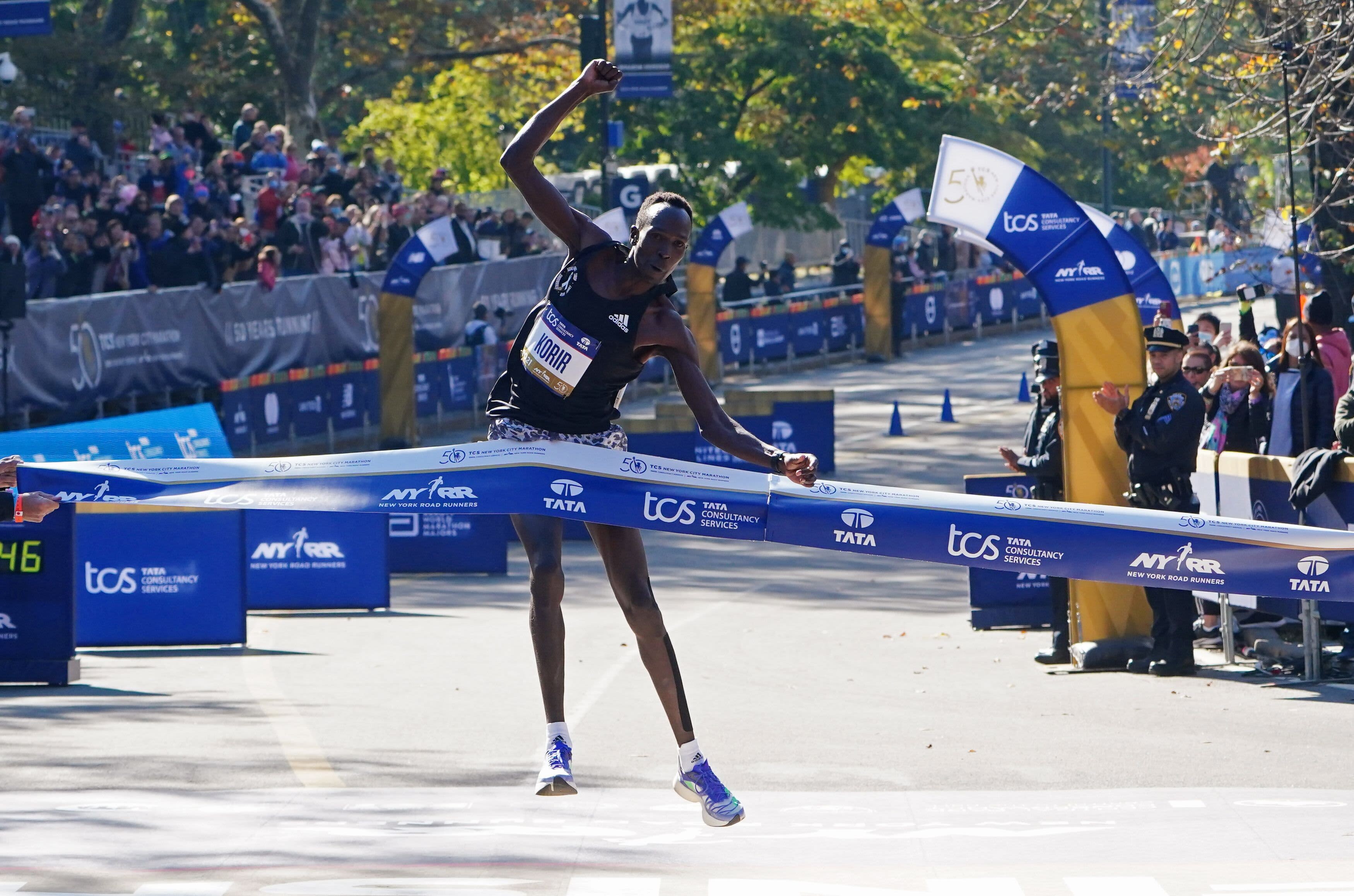
Albert Korir has been confirmed for the event and he is eagerly anticipating the challenge that lies ahead. Korir, a seasoned marathon runner, has set his sights on conquering the historic course once again, and his journey has already began.
For Korir, the Boston Marathon is not just a race; it's a passion, a relentless pursuit of excellence. As he laces up his running shoes and hits the roads for training, the anticipation is building.
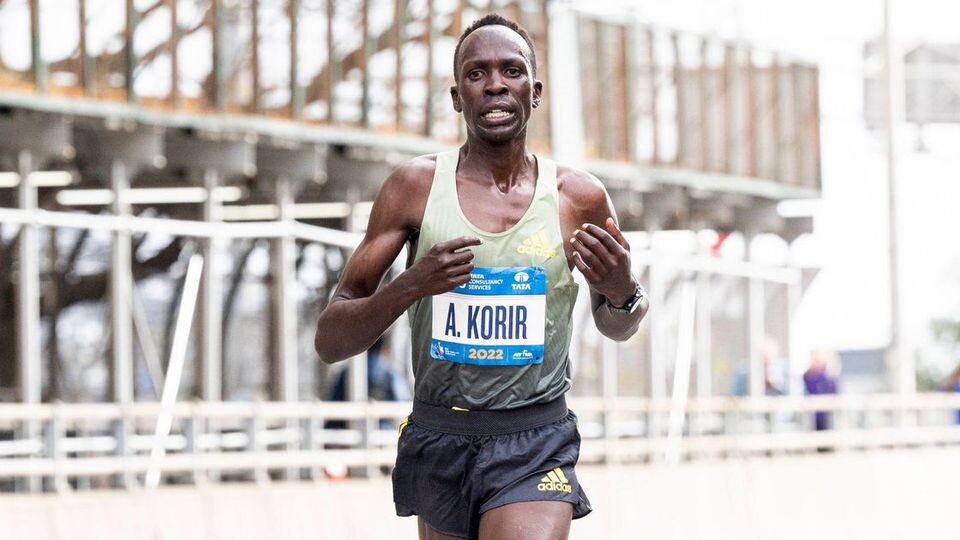
In a post on his Instagram page, Korir said: "The countdown has begun, the work has started. Preparing for another Boston Marathon, and I just can't wait.”
His words reflect the eagerness that echoes through the hearts of all dedicated marathoners. The journey to the starting line is as crucial as the race itself, and for Korir, every step in training is a step closer to realizing his marathon dreams.
Korir, having almost tasted success on this hallowed ground before, understands the significance of the challenge that awaits him.
He finished fourth at last year’s edition of the race and will be keen to go one place better this year. The 2021 New York City Marathon champion immerses himself in a meticulous preparation routine.
Long runs through scenic landscapes, interval training to build speed, and strength workouts to endure the course's demands – each element is a crucial piece of the puzzle. His dedication to the sport and the Boston Marathon, in particular, is evident in every stride he takes.
As the world eagerly awaits the 2024 Boston Marathon, Korir stands at the intersection of anticipation and preparation. The countdown continues, and with each passing day, his commitment to the journey becomes more apparent.
(01/19/2024) ⚡AMPby Abigael Wuafula
Boston Marathon
Among the nation’s oldest athletic clubs, the B.A.A. was established in 1887, and, in 1896, more than half of the U.S. Olympic Team at the first modern games was composed of B.A.A. club members. The Olympic Games provided the inspiration for the first Boston Marathon, which culminated the B.A.A. Games on April 19, 1897. John J. McDermott emerged from a...
more...Four Olympic Medalists Set to Toe the Line in the Women's 60m at the 116th Millrose Games
With just over three weeks to go until the running of the 116th Millrose Games, the excitement for this spectacular event has never been greater. One of the deepest races of the afternoon will be the Women’s 60 Meter Dash, which features no fewer than four Olympic medalists, in addition to an NCAA champion, last year’s runner-up, and more.
The 116th Millrose Games will take place at the Nike Track & Field Center at The Armory on Sunday, February 11th.
The stellar field is as follows:
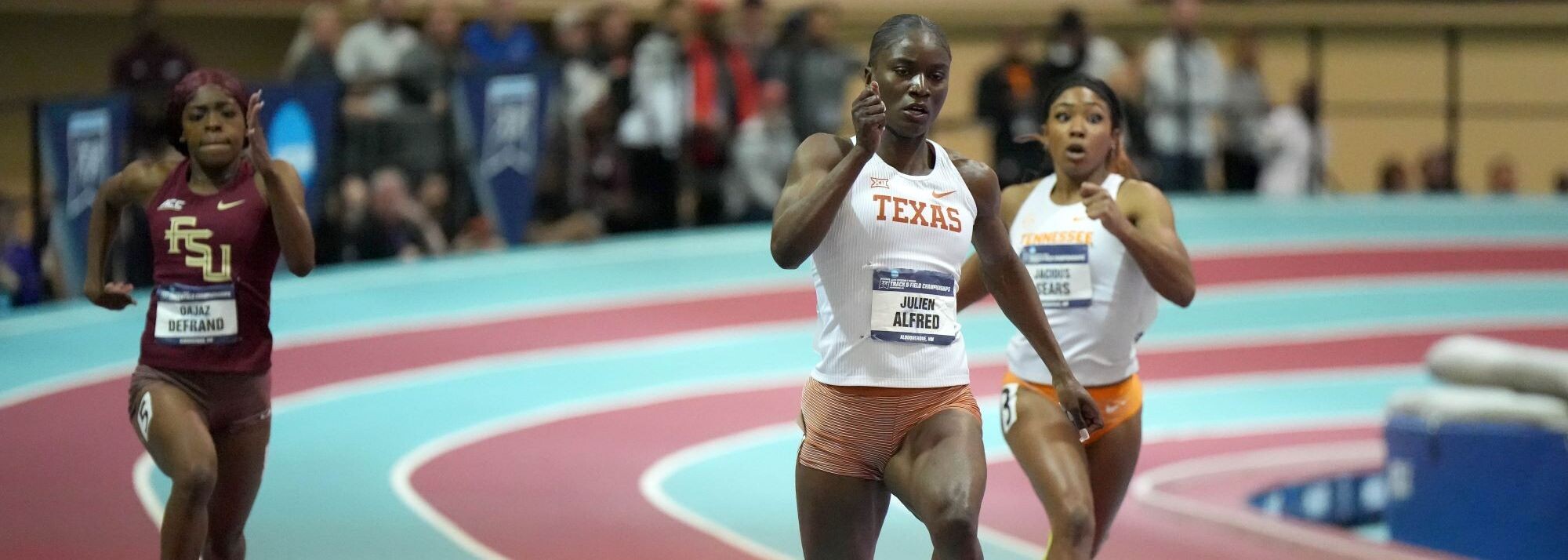
-Dina Asher-Smith is the 2019 World Champion in the 200m. She is a two-time Olympic bronze medalist, and her 2019 gold is one of five World Championship medals that she owns. Asher-Smith holds the British records in the 60m, 100m, and 200m.
“The Millrose Games is one of the most prestigious and historic indoor competitions in the USA, and I am looking forward to racing there for the first time,” said Asher-Smith. “I am really enjoying my new training set up in Austin, and I’m looking forward to a big year in 2024.”
-Julien Alfred was a seven-time NCAA champion at the University of Texas. Her 60m best is not only the NCAA record, it also equals the North American record. In her first season as a professional, Alfred finished fifth in the 100m at the 2023 World Championships, representing St. Lucia.

-English Gardner is an Olympic gold medalist on the 4x100m relay in 2016. A local favorite from New Jersey, she is the tenth-fastest woman in history in the 100m, and she won this race at the Millrose Games in 2019.
-Briana Williams won Olympic gold on the 4x100m relay for Jamaica in 2021, and she is a two-time World Junior Champion.
-Shashalee Forbes is an Olympic silver medalist on the 4x100m relay, and she won the 200m Jamaican championship in 2017.
-Tamari Davis placed second in this race at last year’s Millrose Games, before winning a gold medal on the 4x100m relay at the World Championships.
-Marybeth Sant-Price is the 60m bronze medalist at the 2022 World Indoor Championships.
-Celera Barnes is an NACAC champion on the 4x100m relay.
Stay tuned over the coming weeks before the 116th Millrose Games, as the world-class start lists are finalized. Top athletes already confirmed to compete include Laura Muir, Elle Purrier-St. Pierre, Yared Nuguse, Alicia Monson, Grant Fisher, Danielle Williams, Josh Kerr, Yaroslava Mahuchikh, Christian Coleman, Keni Harrison, Andre De Grasse, Nia Ali, Chris Nilsen, and KC Lightfoot, with even more Olympians and World Championship medalists still to come.
As always, the Millrose Games will feature the absolute best athletes in the sport, including dozens of Olympians and world champions. The Millrose Games is a World Athletics Indoor Tour Gold meet. With highest-level competition at the youth, high school, collegiate, club, and professional levels, there is truly something for everyone at the Millrose Games.
(01/19/2024) ⚡AMPNYRR Millrose Games
The Pinnacle of Indoor Track & Field The NYRR Millrose Games, first held in 1908, remains the premier indoor track and field competition in the United States. The 2025 edition will once again bring the world’s top professional, collegiate, and high school athletes to New York City for a day of thrilling competition. Hosted at the New Balance Track &...
more...It is possible to run faster, 41-year-old Kenenisa Bekele insists
41-year-old marathoner Kenenisa Bekele believes he still has the mileage in his legs to run faster as he eyes victory at the Olympic Games.
Marathon legend Kenenisa Bekele has insisted that he is the greatest form of his life heading into the Olympic Games in Paris, France where he will lock horns with other great marathoners.
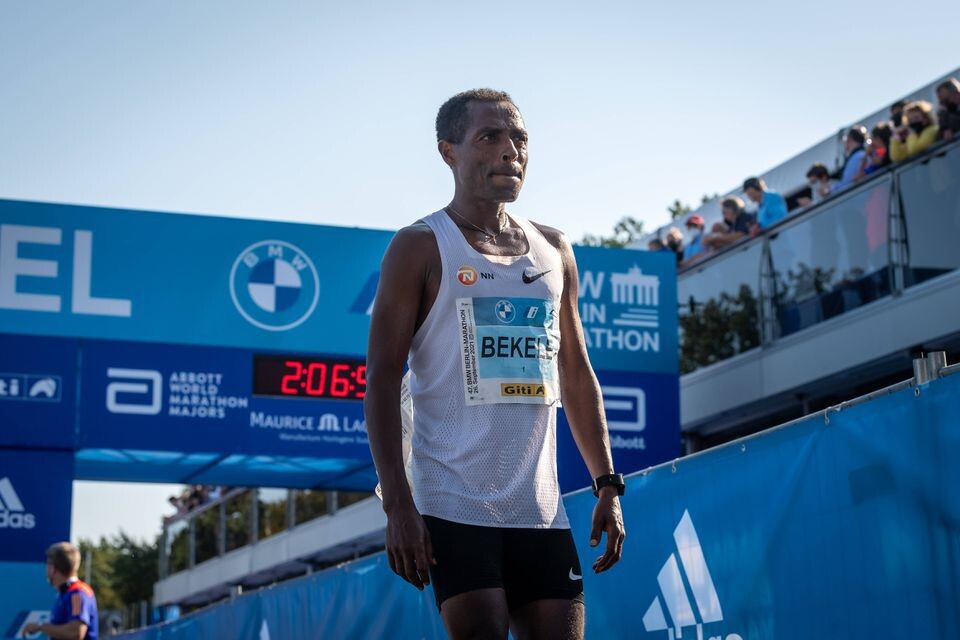
In an interview with Athletics Weekly, the Ethiopian insisted that his progression is going well and he is ready to run faster times. He has gathered a lot of experience so far and will definitely be looking forward to impress.
“When I look at my progression, I feel like I have good energy and power…I feel very strong unlike when I struggled around three or four years ago.
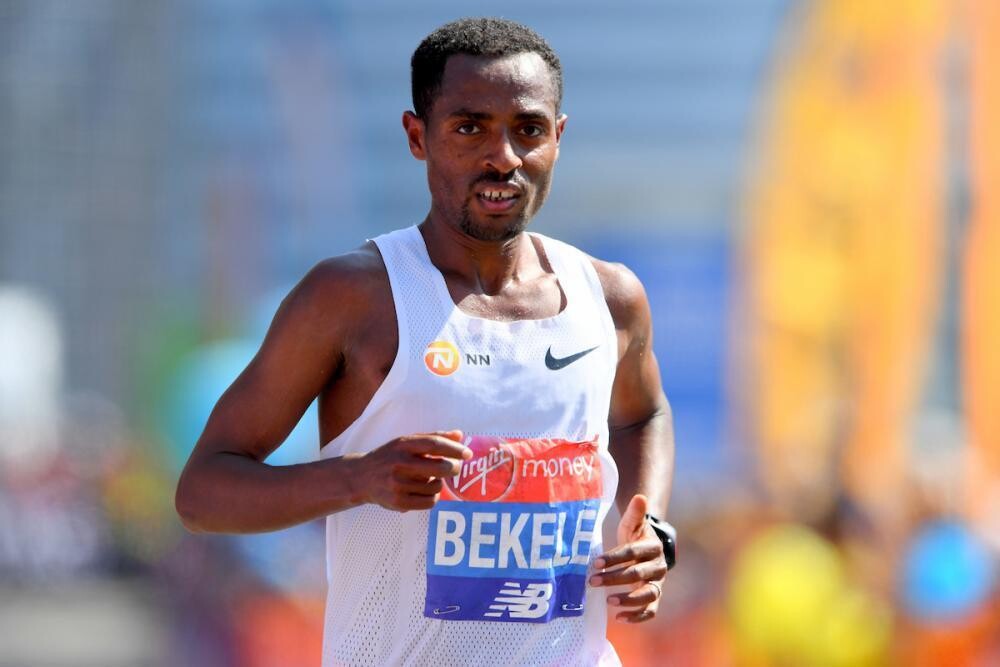
“It is possible to run faster with this age you know…it is quite a good age for a marathon so I think I will do something better in the future,” the 41-year-old said.
He added that marathon running requires an athlete to have the talent first and the capacity to run the distance and also experience.
“Experience by itself can’t change anything if you don’t have the capacity to cover the distance. If you compare that with age also the young generation is struggling to run faster times and follow the pace of the older and experienced runners.
"This could be influenced by their capacity and talents. That’s why in my mind, I know myself and during training, I compete against my teammates to gauge myself,” Bekele said.
The two-time Berlin Marathon also commented on his training, explaining that it has not been a walk in the pack for him.
“Marathon training is really challenging…I was out of the track due to an injury and every time I get an injury, my training changes.
“Training wise, at some point and I could not follow every training session. This is the greatest challenge I face in training for my training,” he said.
(01/19/2024) ⚡AMPby Abigael Wuafula
Kenenisa Bekele
Malindi Elmore set to race 2024 Boston Marathon
Two-time Olympian Malindi Elmore of Kelowna, B.C., is on the women’s elite list for the 128th Boston Marathon on April 15. Elmore is featured in a strong field with reigning champion Hellen Obiri and 2022 New York Marathon champion Sharon Lokedi; she will also be one of three Canadian women running in Boston.
This will be Elmore’s second time running the Boston Marathon. In 2022, she ran to an impressive 11th-place finish, posting a time of 2:27:58, which is the fastest-ever time in Boston by a Canadian woman. She left Boston wanting to return, saying, “It’s a blast to run the crowd-lined streets, where there is always someone cheering you on and shouting your name.”
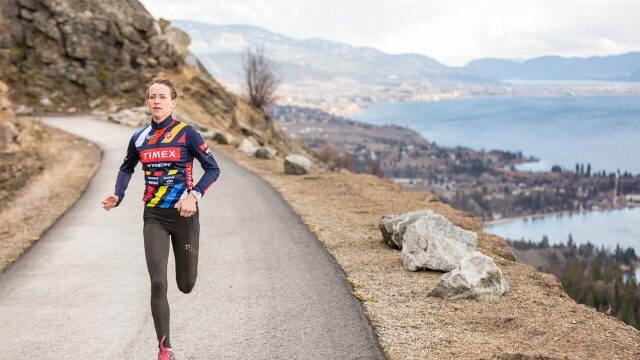
Elmore, who ran the second-fastest Canadian women’s marathon time at the 2023 Berlin Marathon, achieved the Olympic qualifying mark of 2:26:50. She is currently the only woman who has solidified her spot on Team Canada for the marathon in Paris. The 43-year-old told Canadian Running that she plans to use Boston as a prep race for the Olympic marathon in August.
“Racing Boston is part of the Paris 2024 plan,” says Elmore on her decision to race Boston. “The course in Paris is reported to be twice the elevation gain of Boston, so I want the opportunity to train and race on hills through the winter and hopefully be a hill beast by August!”
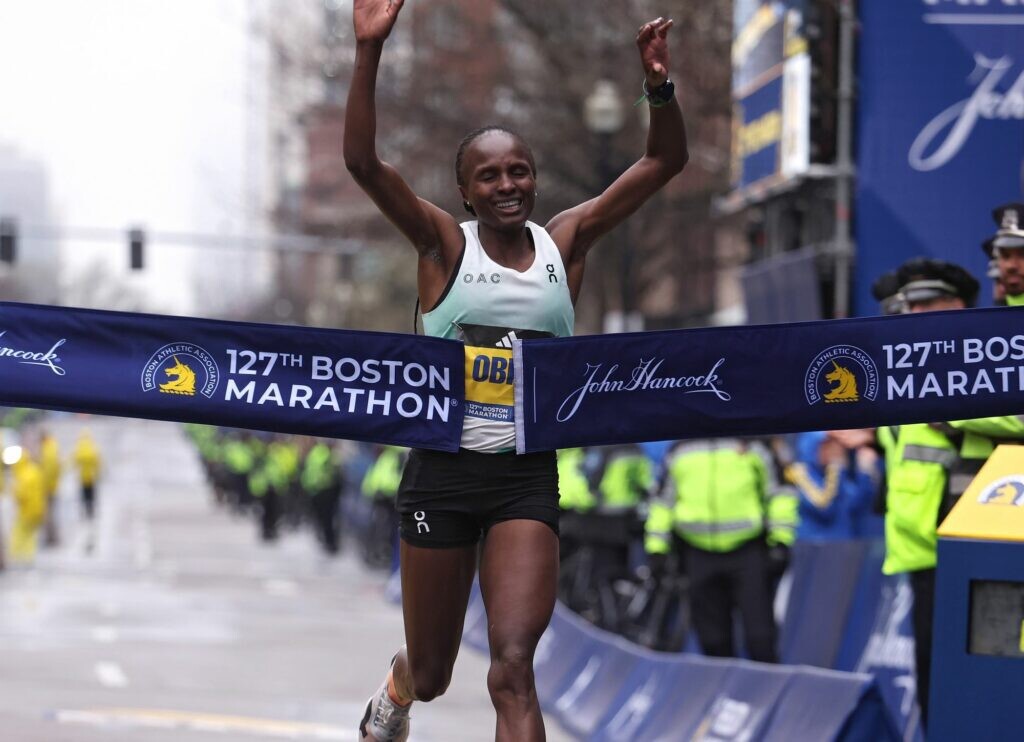
The Boston and New York marathons are two of the tougher Abbott World Marathon Major courses. The Boston is a net downhill, but features a lot of hills in the second half of the race, including the famous Heartbreak Hill at 32 kilometres. The Paris Olympic marathon is touted to be the hilliest Olympic marathon to date, featuring more than 400 metres in elevation gain on an out-and-back loop to the Palace of Versailles.
Elmore will be one of three Canadian marathoners on the women’s elite list. Joining Elmore in Boston are two up-and-coming marathoners from Thunder Bay, Ont., Michelle and Kim Krezonoski. The Krezonoski sisters ran their personal bests of 2:36:39 (Michelle) and 2:37:20 (Kim) at the 2022 California International Marathon.
Michelle said it’s been an exciting and emotional journey to get to this point after partially tearing her Achilles tendon in her build-up to the 2023 Toronto Waterfront Marathon (which she did not race). “I am grateful to have this opportunity to run alongside the world’s best with my twin sister,” Michelle told Canadian Running. “Boston is historic, and it’s a course that challenges your strength.”
Obiri returns for glory
The most dominant women’s marathoner in the world right now, Hellen Obiri, returns to Boston to defend her title. Last year, Obiri unleashed a perfectly-timed sprint in the final mile to earn her first Boston Marathon title, in only her second career marathon. Boston marked one of her two marathon wins in 2023. She became only the second women’s marathoner in history to win both Boston and New York in the same year.
“I am excited to return to the 2024 Boston Marathon to try to defend my title,” shared Obiri, who won last year’s race in 2:21:38. “Boston is a historic race, and I would like to add my name further to its history on April 15. Winning such a historic marathon with my family waiting at the finish line was an experience I’ll never forget.”
The 2024 Boston Marathon will also see a trio of Ethiopian runners with personal bests under 2:18:00. Worknesh Degefa, the 2019 Boston Marathon champion, is set to return. Tadu Teshome, with a marathon best of 2:17:36 from the 2022 Valencia Marathon, will make her Boston debut, and Senbere Teferi, a world championship silver medallist over 5,000m, will also compete after winning the B.A.A. 5K in a course record time of 14:49 in 2022.
(01/18/2024) ⚡AMPby Marley Dickinson
Boston Marathon
Among the nation’s oldest athletic clubs, the B.A.A. was established in 1887, and, in 1896, more than half of the U.S. Olympic Team at the first modern games was composed of B.A.A. club members. The Olympic Games provided the inspiration for the first Boston Marathon, which culminated the B.A.A. Games on April 19, 1897. John J. McDermott emerged from a...
more...How Faith Kipyegon's track rival is planning to dethrone the golden girl
Faith Kipyegon's track rival has revealed her plans to dethrone the queen of the 1500m this season.
Laura Muir, one of Faith Kipyegon’s track rivals has opened up on plans to beat the double world record holder this season.
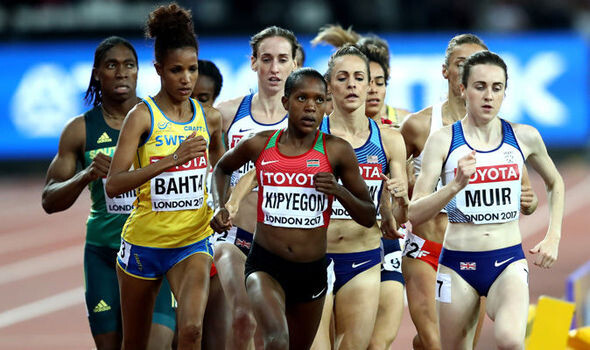
The Scottish woman noted that she has beaten Kipyegon before and even though it was not during a major championship, she believes anything is possible.
She added that all she will do will be to focus on herself and focus on what she can do best. The former World 1500m silver medalist also admitted that Kipyegon is the best 1500m runner at the moment and she comes off as a phenomenal athlete too.
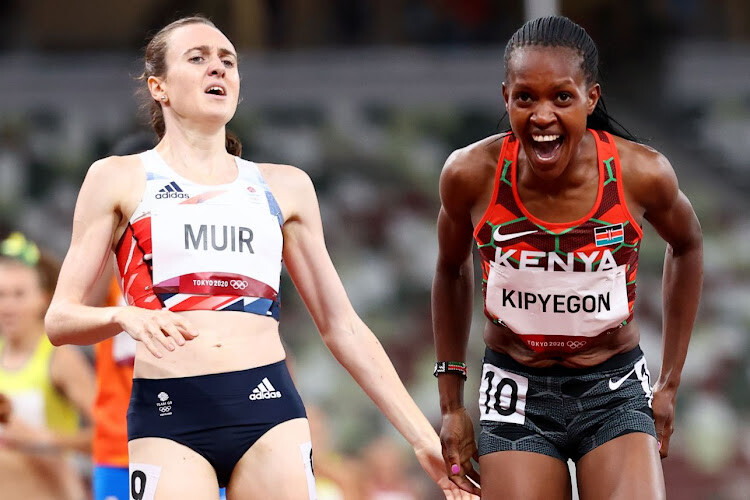
“I think it helps that I’ve beaten her two or three times a few years ago. So I’ve done it, but not for a long time and never in a championship setting. But it's possible.
"There are lots of ways that I can improve this year, so it’s nice to know I can get faster and that we haven’t maxed out everything.
"But it seems to be that when I get faster, she then also gets faster. I was narrowing the gap a little bit when I ran 3:54 in Tokyo, but then she widened it again.
"All I can do is focus on myself and just be the best athlete I can be. And if that gets closer to her, and potentially a tiny chance of beating her, then that's all I can do.
"She's the best we've ever had. She’s a phenomenal athlete and deserves all the recognition she's had. It’s exciting to be a part of, but it's difficult to try and keep up,” she said as per Citius Mag.
The Olympic Games silver medalist also took a trip down memory lane to remember the Diamond League Meeting in Monaco where dozens of athletes set national records following Kipyegon’s world record over the mile.
She added that they were aware she would run a fast race and they knew she meant business. Muir also disclosed that it was great to be part of the team and it was an amazing occurrence to see how she delivered the world record.
“I remember going to Monaco and thinking, “I have to run my own race, I can't go with that.” As much as I like to believe in myself, that was beyond my capability.
"I knew I had to run my own race. I wanted to get the British record and by running my own race, I got that record. So, I was pleased with that,” she said.
Muir will also be going for the top prize at the Olympic Games, however, whatever the outcome, she noted that she would be satisfied.
“I've defended titles, I've broken records and championship records. The only thing that's missing is the global title, which is very hard to get…
"But I'm going to keep trying and that's all I can do. All I can do is focus on myself and work as hard as I can and get myself in the best shape I can. If that's enough to get on the podium, great. If that's enough to win, even better.
"I just love running, I love my training, and I feel very privileged to be in this position to be successful in the sport. I have gotten so much from it. I hope that I can continue for a few more years and get a few more medals as well,” she concluded.
(01/18/2024) ⚡AMPby Abigael Wuafula
Three ways to keep your legs snappy, without feeling beat up
Building speed and strength as a runner while keeping your legs feeling fresh sounds like a challenge—but it can be as simple as incorporating a few drills or quick training sessions into your regular routine. Fast turnover and snappy, quick legs are something you can work on year-round, even when you’re focused on building a base or adding endurance.
To keep those legs moving briskly throughout the year without succumbing to overtraining, consider incorporating these three types of workouts into your routine.

1.- Tweener repeats
Renowned coach Greg McMillan explains that “tweeners” are repeats performed slower than your V02 max effort, but faster than your lactate threshold. The objective is to achieve the benefits of longer speedwork sessions without succumbing to fatigue.
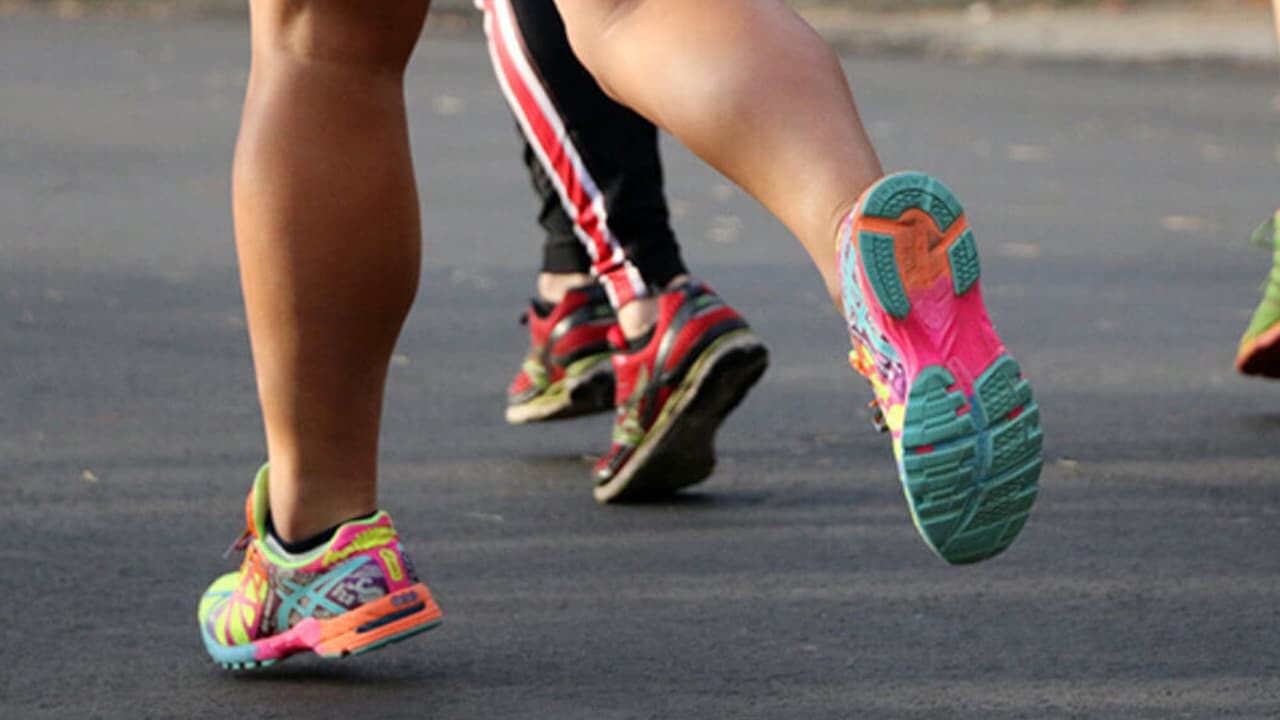
McMillan suggests running these based on effort or heart rate rather than pace, starting at 85 to 87 per cent of your maximum heart rate and gradually progressing to 92 per cent. It’s OK to add recovery time if you start to breathe hard. If that sounds too complicated to calculate, try running these intervals at a pace that’s tough but not full-out, and adjust the repetitions and distance as needed so that you aren’t feeling intensely fatigued between or after intervals.
The workout
Warm up with 10 minutes of easy running.
Run 4-6 x 800m at a cruise interval pace with 200m recovery after between repeats.
Cool down with 10 minutes of easy running.
2.- Short hill sprints
Take your workout to new heights by incorporating super-quick hill sprints on a steep incline (8-12 per cent) or by adjusting your treadmill incline. These intense sprints provide a quick burst without leaving you breathless or struggling to maintain speed. Adjust the sprint duration if needed, ensuring you can run continuously without feeling overly winded.
The workout
Warm up with 20 minutes of easy running.
Run 10 x 10 seconds of uphill sprinting, followed by 2-3 minutes of easy running recovery.
Cool down with 10 minutes of easy running.
3.- Strides
Strides are perfect for everyone, from new runners to experienced athletes, and can easily be tacked on to your already-planned easy runs several times a week. They are a great way to run fast, but avoid building lactic acid or creating a lot of residual fatigue. If you feel out of breath during your strides, reduce repeats until you’ve gained strength.
The workout
5-10 x 15 seconds at a fast but controlled effort, with full recovery (45 to 90 seconds of very easy running).
Remember to follow a high-intensity day with easy running or recovery, and ensure proper hydration. By incorporating these diverse workouts into your routine, you can elevate your running game, maintaining agility, speed and stamina throughout the seasons.
(01/18/2024) ⚡AMPby Keeley Milne
Suguru Osako to skip Tokyo Marathon in order to compete in Boston Marathon
Paris Olympic hopeful Suguru Osako revealed Thursday he will skip the March 3 Tokyo Marathon in favor of competing in the Boston Marathon the following month.
Osako, who was sixth at the Tokyo Olympics in 2021, is currently on track to claim the third and final Japanese men's marathon slot for Paris by virtue of his third-place finish in October's Marathon Grand Championship.
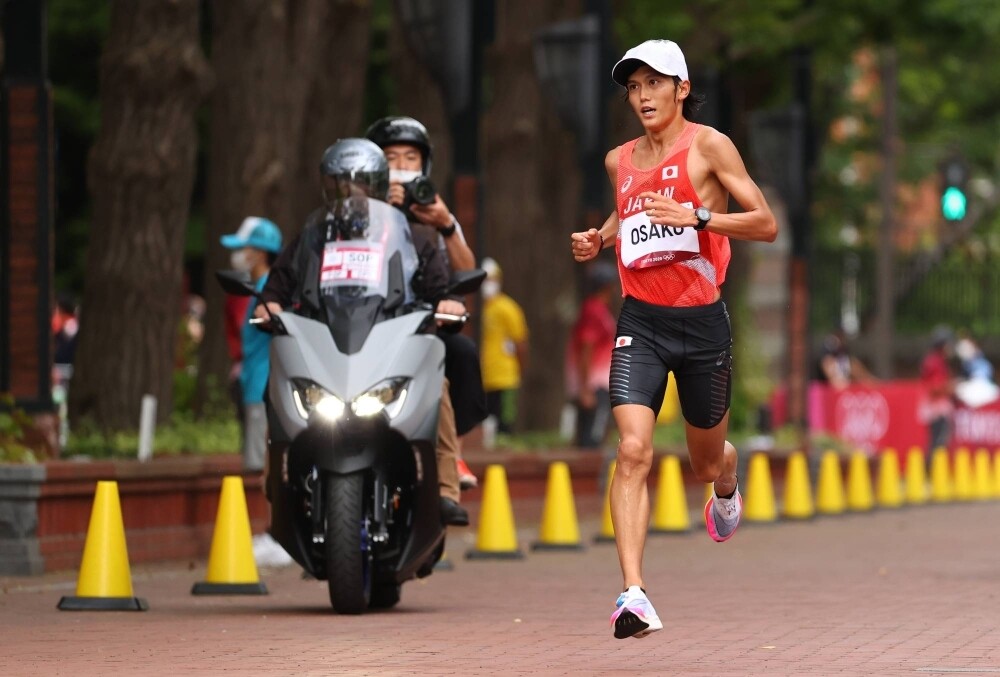
Another Japanese runner must clock 2 hours, 5 minutes, 50 seconds or faster, the time set by the Japan Association of Athletics Federations, at either February's Osaka Marathon or the Tokyo Marathon to move ahead of Osako in the Olympic qualification standings.
In a video message posted to Instagram, Osako indicated he wanted to avoid the intense focus in Japan on qualifying for the games and said his heart was set on running in Boston.
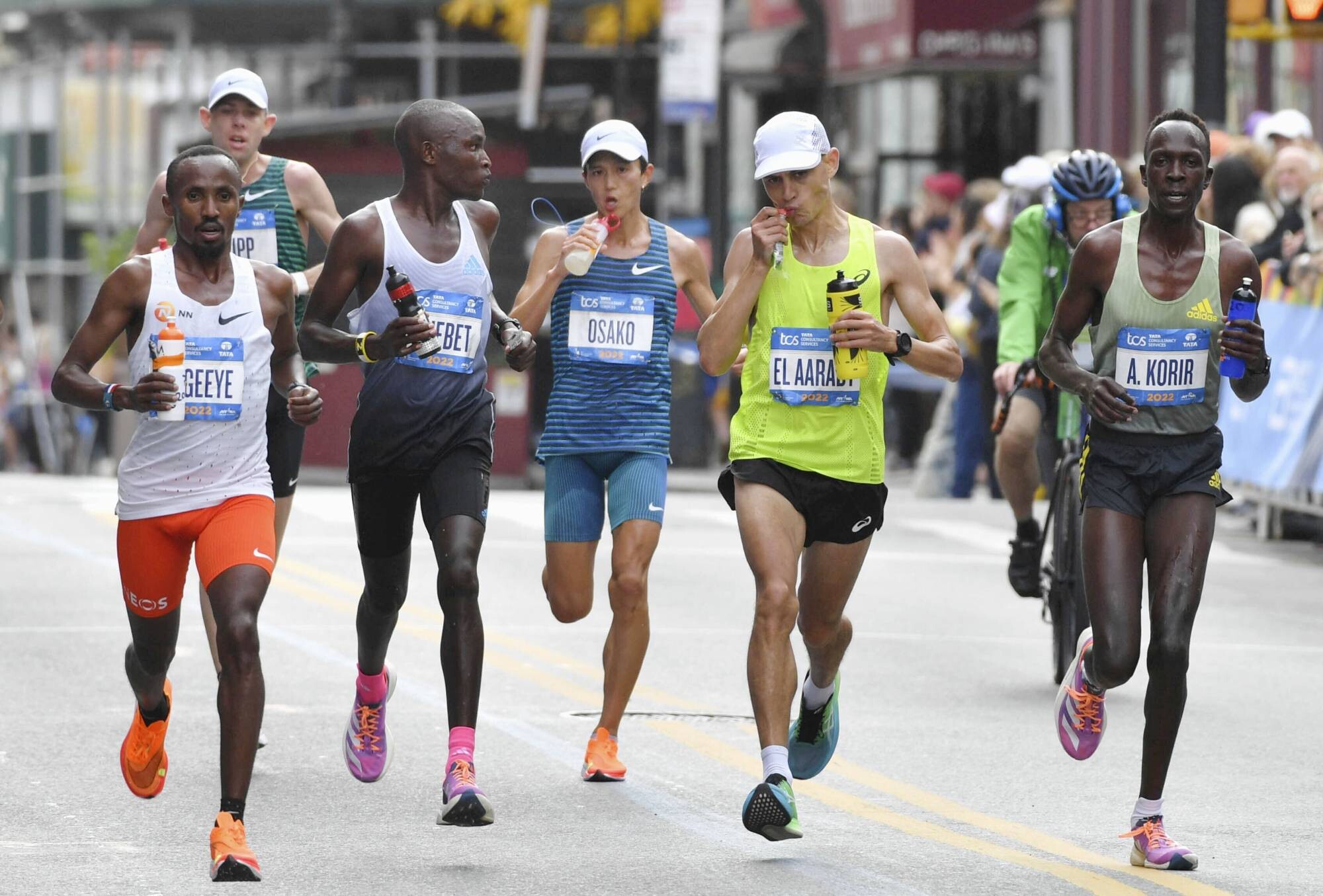
"The bigger the fuss being made around me, the less enthusiasm I tend to feel," the 32-year-old Tokyo native said. "The race that I really felt like I wanted to run was the Boston Marathon."
"Of course, the Olympics are important, but I don't think it's necessary to obsess about them as much as some people do."
Two Japanese runners, Naoki Koyama and Akira Akasaki, have already earned their Olympic berths by finishing first and second, respectively, in the MGC.
(01/18/2024) ⚡AMPby The Japan Times
Boston Marathon
Among the nation’s oldest athletic clubs, the B.A.A. was established in 1887, and, in 1896, more than half of the U.S. Olympic Team at the first modern games was composed of B.A.A. club members. The Olympic Games provided the inspiration for the first Boston Marathon, which culminated the B.A.A. Games on April 19, 1897. John J. McDermott emerged from a...
more...Agnes Jenet Ngetich recently smashed the world 10k record for women but maybe we need to take another look?
Agnes Jebet Ngetich Kenya ran 28min 46sec for 10km road race at Valencia in Spain, Taking half a minute off the previous record.
Sean Williams posted these thoughts on FB, thoughts shared by many we are sure: "I don’t usually like to be negative about world records. But I have to admit, for a long distance runner, this girl looks remarkably masculine. So either she was born with an incredibly strong female runner’s body, or she’s on some special kind of juice or she was a bloke a few years ago. 

just check that photo on your post. I’m thinking testosterone, growth hormones or some special new juice that most of us have not heard of yet.  sad to say that the women who have completely smashed world records, apart from in the marathon, and half marathon, tend to look very Masculine.
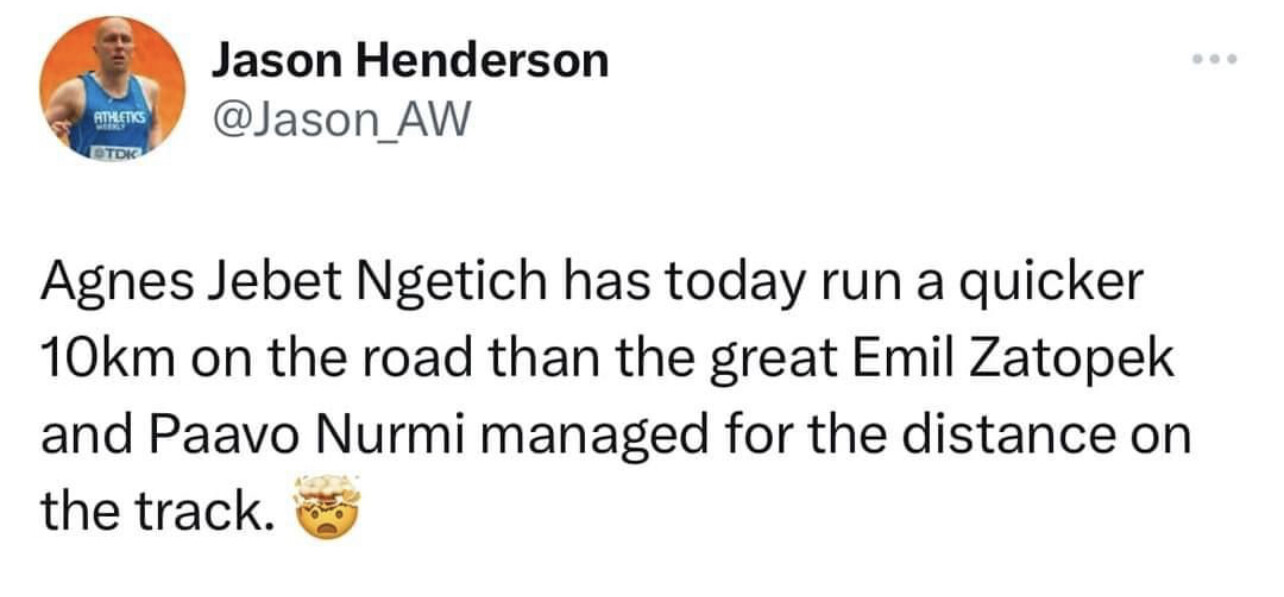
Take away the painted fingernails, make up and often fancy hair, and you could almost say you’ve got a bunch of guys holding all the female world records from the 100 m through to the 10,000 m. * apart from Faith in the 1500. I have a theory that all the Chinese who were smashing world records in the early 90s (Ma’s army) were all the top Chinese male runners and they got the cut and tuck. 8.06 for a chick in 3000m - come on!"
What are your thoughts?
(01/18/2024) ⚡AMPby Sean Williams
Age is not a problem for me, insists 44-year-old marathoner Edna Kiplagat
44-year-old Edna Kiplagat has insisted that age is not an issue as she plans to continue conquering the world of marathon running.
Two-time Boston Marathon champion Edna Kiplagat does not see her age as an obstacle to her achieving her goals in life.
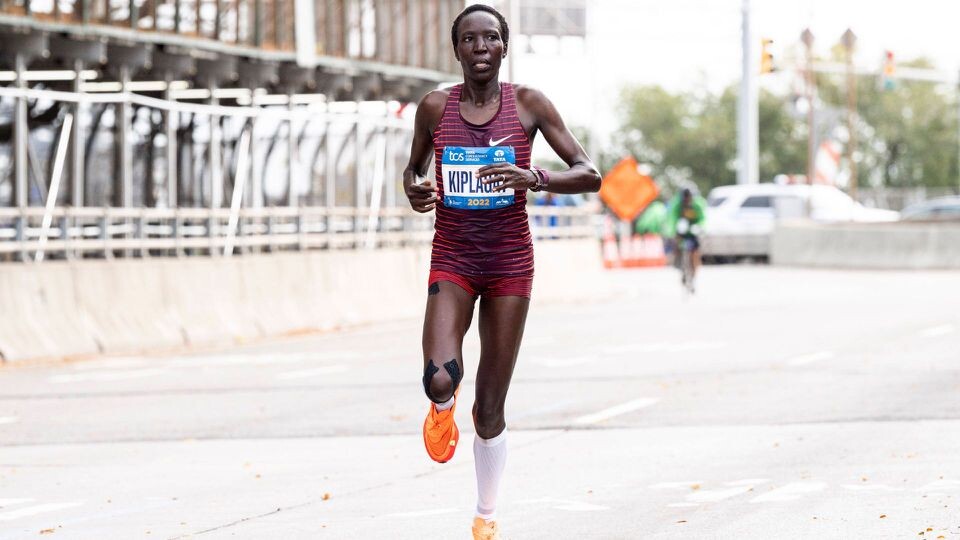
Kiplagat’s age has caught many by surprise, owing to the fact that she is still able to run well and finish races, especially the marathons. Speaking during a press conference before the Houston Half Marathon last weekend, the 44-year-old insisted that she does not view her age as a problem.
She added that the reason why she keeps going is to be a source of encouragement to young runners and her children too. The 2014 London Marathon champion explained that she wants youngsters to understand that anything is possible as long as they put their minds to it.
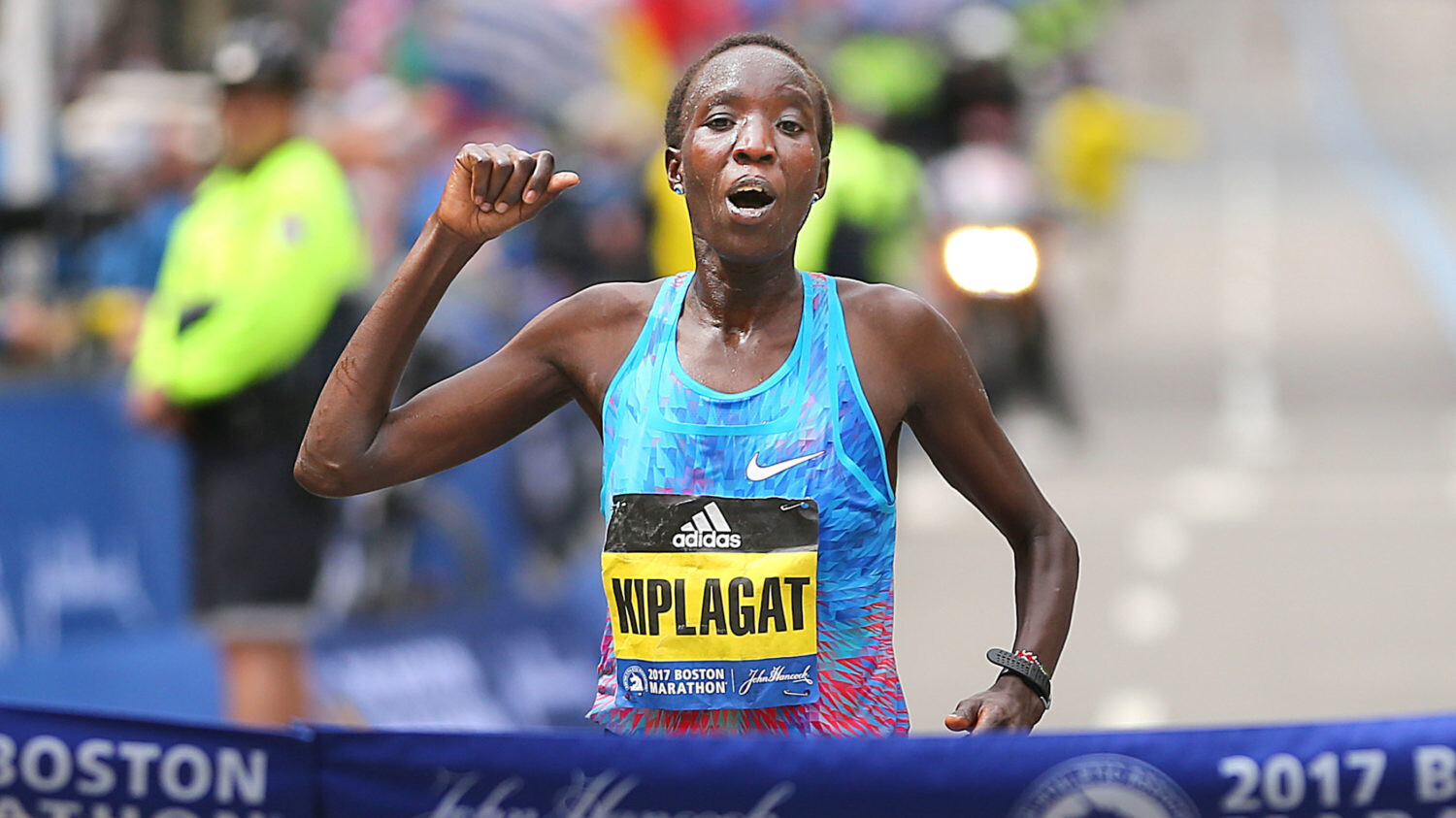
“I believe that what I have done or accomplished before is going to motivate most of the young athletes. I want them to know that if they work hard and focus on anything they are passionate about, then they will achieve their goals.
"I don’t feel that age is a huge factor for me but I know that as long as I feel healthy and I love what I do, I’ll keep on doing my best,” Kiplagat said.
Meanwhile, Kiplagat has been in the game for more than 25 years since she made her professional debut at the 1996 World Junior Championships where she bagged silver in the 3000m. The American-based athlete then proceeded to bag a bronze medal at the 1998 World Junior Championships.
Since then, Kiplagat just kept and she became the first woman to successfully retain her marathon world title.
She won the marathon title at both the 2011 and 2013 World Championships held in Daegu, South Korea and Moscow, Russia respectively. In 2010, Kiplagat bagged the New York City Marathon and Los Angeles Marathon titles.
(01/17/2024) ⚡AMPby Abigael Wuafula
Chebet, Lemma and Geay to clash at Boston Marathon
Evans Chebet and Gabriel Geay, the top two finishers at last year’s BAA Boston Marathon, will return to the World Athletics Platinum Label road race on April 15, to take on recent Valencia Marathon winner Sisay Lemma.
Chebet successfully defended his Boston title last year in 2:05:54. In fact, the Kenyan has won six of his past seven marathons.
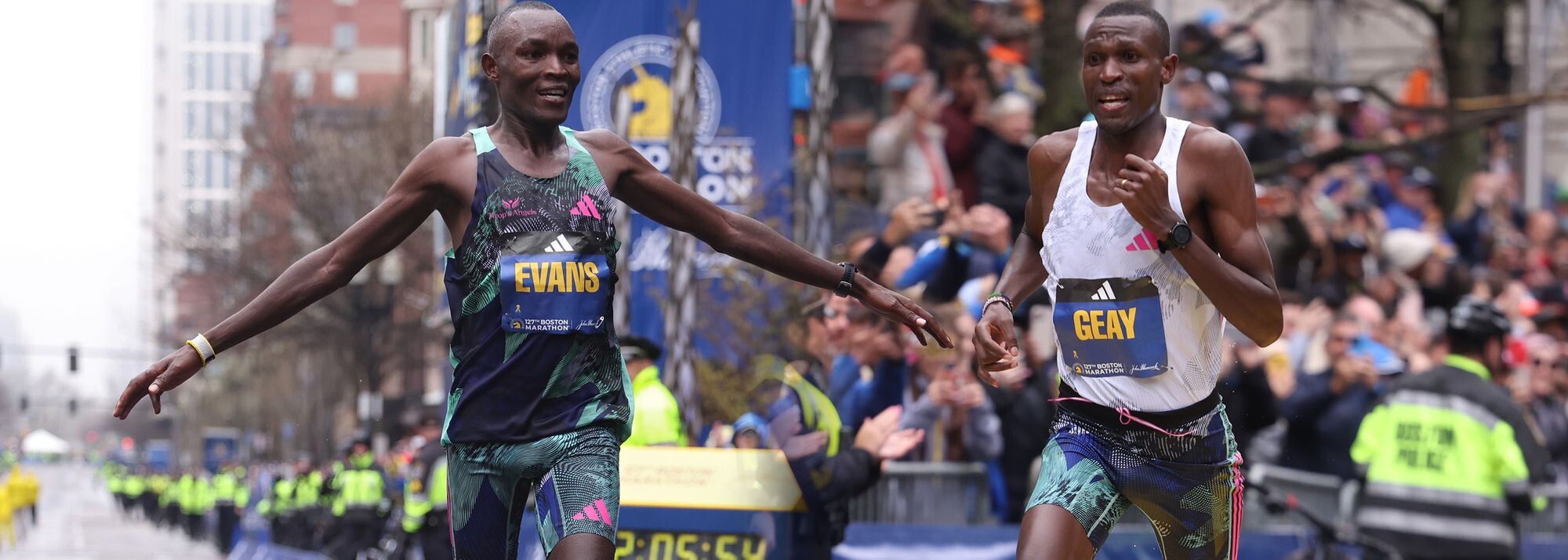
Lemma won in Valencia last month in 2:01:48, making him the fourth-fastest man in history. The Ethiopian, who also won the 2021 London Marathon, is the fastest man in this year’s Boston Marathon field, which features 20 men with sub-2:10 PBs.
Tanzania’s Geay, runner-up in Boston last year, has an identical PB to Chebet – 2:03:00 – and, like Chebet, it was also set in Valencia.
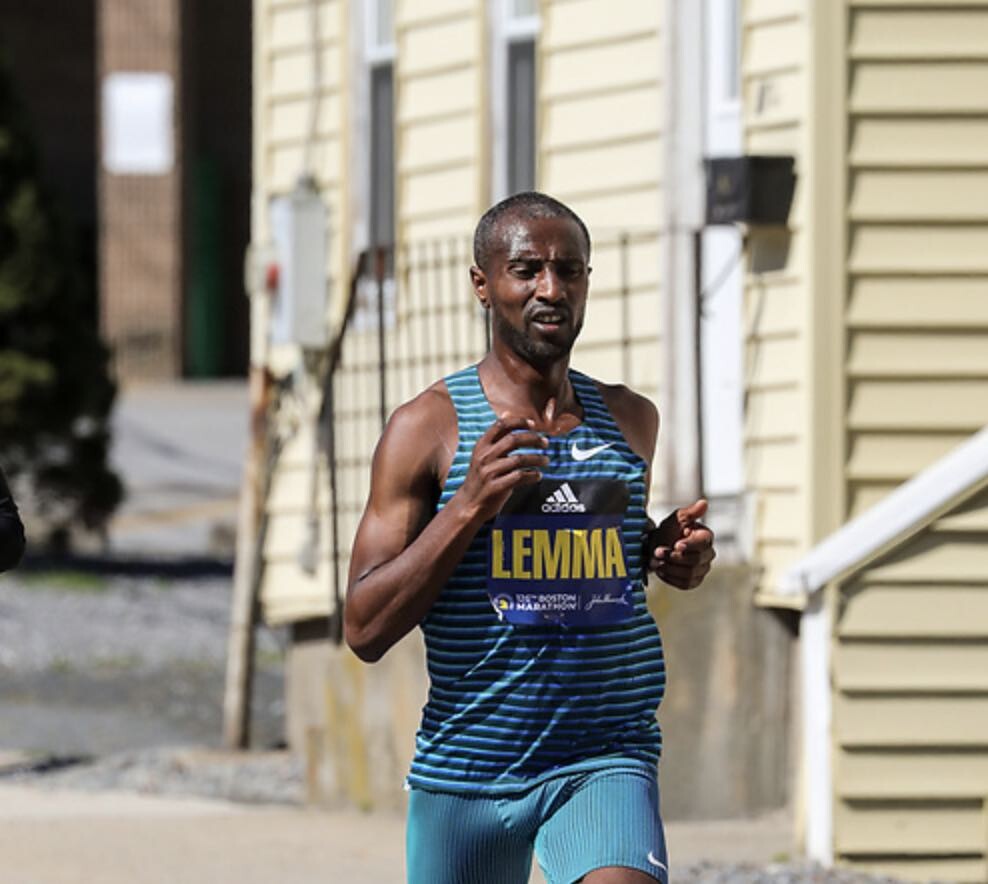
Other men in the field with sub-2:05 PBs are Kenya’s Joshua Belet (2:04:18), Ronald Korir (2:04:22), and Cyprian Kotut (2:04:34), as well as Ethiopians Haftu Teklu (2:04:43) and London and New York City runner-up Shura Kitata (2:04:49).
New York Marathon champion Albert Korir, former Japanese record-holder Suguru Osako, and Norwegian record-holder Sondre Moen are also in the field, as are Morocco’s Zouhair Talbi, winner of last week’s Houston Marathon in a course record 2:06:39, and multiple NCAA champion Edward Cheserek.
Elite field
Sisay Lemma (ETH) 2:01:48
Evans Chebet (KEN) 2:03:00
Gabriel Geay (TAN) 2:03:00
Joshua Belet (KEN) 2:04:18
Ronald Korir (KEN) 2:04:22
Cyprian Kotut (KEN) 2:04:34
Haftu Teklu (ETH) 2:04:43
Shura Kitata (ETH) 2:04:49
John Korir (KEN) 2:05:01
Mohamed Esa (ETH) 2:05:05
Suguru Osako (JPN) 2:05:29
Sondre Moen (NOR) 2:05:48
Filmon Ande (ERI) 2:06:38
Zouhair Talbi (MAR) 2:06:39
Isaac Mpofu (ZIM) 2:06:48
Albert Korir (KEN) 2:06:57
Kento Otsu (JPN) 2:08:15
Ryoma Takeuchi (JPN) 2:08:40
Segundo Jami (ECU) 2:09:05
Tsegay Tuemay (ERI) 2:09:07
Matt McDonald (USA) 2:09:49
David Nilsson (SWE) 2:10:09
Tristan Woodfine (CAN) 2:10:39
CJ Albertson (USA) 2:10:52
Chris Thompson (GBR) 2:10:52
Edward Cheserek (KEN) 2:11:07
Yemane Haileselassie (ERI) debut
(01/17/2024) ⚡AMPby World Athletics
Boston Marathon
Among the nation’s oldest athletic clubs, the B.A.A. was established in 1887, and, in 1896, more than half of the U.S. Olympic Team at the first modern games was composed of B.A.A. club members. The Olympic Games provided the inspiration for the first Boston Marathon, which culminated the B.A.A. Games on April 19, 1897. John J. McDermott emerged from a...
more...Peres Jepchirchir headlines women field at Ras Al Khaimah Half-Marathon
Olympic marathon champion Peres Jepchirchir will headline the 16th edition of the Ras Al Khaimah Half-Marathon scheduled for February 24, 2024 in Ras Al Khaimah, United Arab Emirates.
The three time World Half Marathon champion is also the only woman to simultaneously hold the Olympic, New York and Boston marathon titles, which she achieved in the seven months between August 2021 and April 2022.
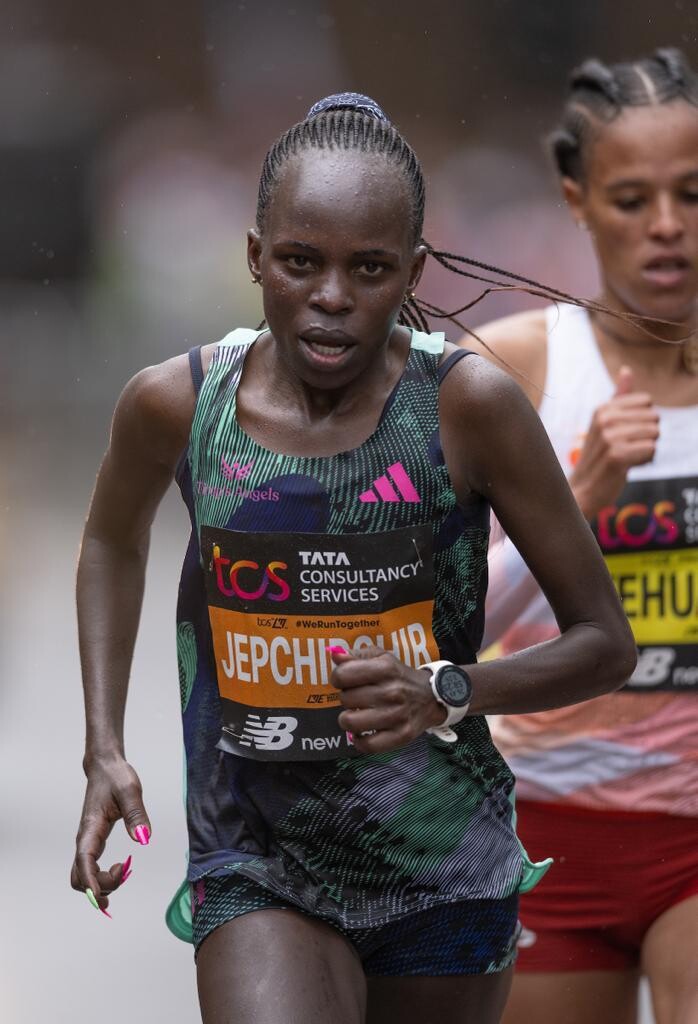
Jepchirchir who also holds two world marathon majors, knows this course so well as she set her first world half marathon record here in 2017 when she broke Florence Kiplagat’s record of 1:05.09 that she had set in Barcelona in 2015 with a new world record of 1:05.06.
The mother of one will be looking to challenge the race course record of 1:04.14 set last year by the 2018 World U20 5000m bronze medallist, Girmawit Gebrzihair of Ethiopia.
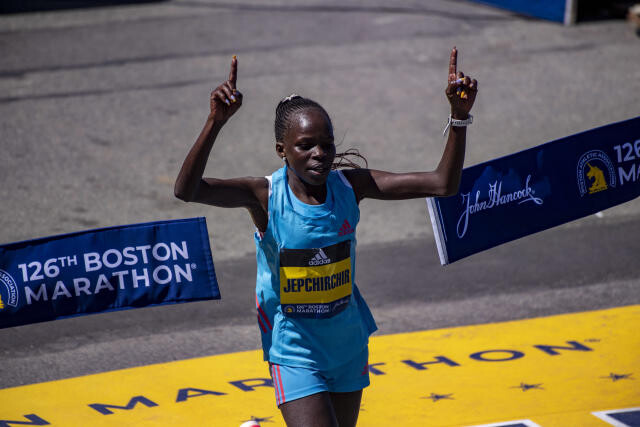
Race Director and Pace Events CEO Peter Connerton said today, ‘We were honoured and enormously gratified to be invited by the Ras Al Khaimah tourist authorities to organise an event like the RAK half-marathon. We feel it’s a reflection of the success we’ve had with the Dubai Marathon since 2000.
We’ve added a 10k to the RAK programme since we’ve seen how successful the shorter event has been in Dubai; either as a challenge in its own right, or as a stepping stone for runners on the way to a half or full marathon. Jepchirchir is the first of many leading names we shall be announcing for the RAK ‘half’ in the coming weeks”.
(01/17/2024) ⚡AMPby John Vaselyne
Rak Half Marathon
The Rak Al Khaimah Half Marathon is the 'world's fastest half marathon' because if you take the top 10 fastest times recorded in RAK for men (and the same for women) and find the average (for each) and then do the same with the top ten fastest recorded times across all races (you can reference the IAAF for this), the...
more...Commonwealth Games sprint medalist Micha Powell to release inspiring memoir
The 2022 Commonwealth Games gold medalist, Micha Powell, is set to release a memoir and workbook for young women, entitled, “Sprinting Through Setbacks: An Olympian’s Guide to Overcoming Self-Doubt and Imposter Syndrome.”
The memoir will chronicle her decade of professional racing experience, sharing vulnerable stories about growing up in the shadow of two Olympian parents, navigating injuries and finding the courage to adopt an Olympic mindset.
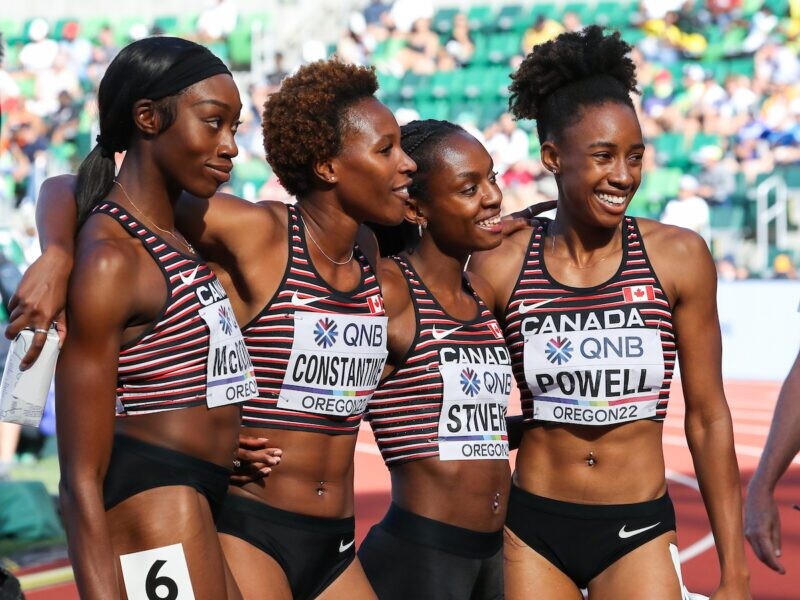
From the day Powell was born, she has had athletics ingrained in her DNA. She is the child of three-time Canadian Olympian Rosey Edeh and current long jump world record holder, American Mike Powell.
“I’m thrilled to share my story about how I accomplished my goals while overcoming setbacks and self-doubt as an Olympic athlete,” said Powell. “I want people to take away from this book that it’s not a linear path to success, and embrace the imperfect journey to triumph and use that resilience to accomplish their big goals in life.”
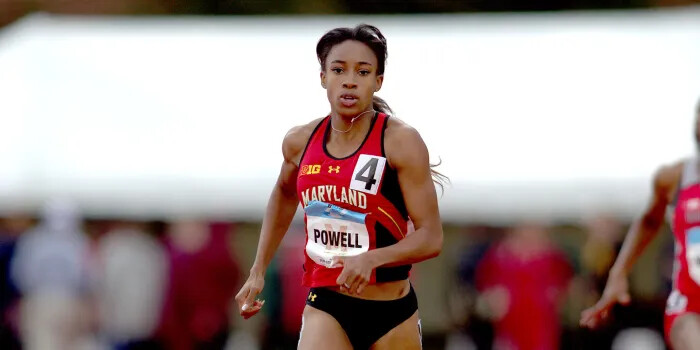
The book will feature 10 pivotal races from Powell’s career, each accompanied by a lesson she learned. Additionally, workbook-style sections will be included to allow young readers to apply Powell’s experiences to their own lives. The topics covered in the book range from finding balance and style to overcoming imposter syndrome and finding your spotlight.
The 29-year-old has set her sights on qualifying for the 2024 Paris Olympics in the women’s 400m and 4x400m relay for Team Canada. The memoir is geared toward young women early in their schooling or athletic careers, aiming to inspire the reader no matter their goals or future endeavors.
The book, co-authored by Canadian Running writer Molly Hurford, founder of Strong Girl Publishing, is scheduled for release in summer 2024. Fans and readers can follow @MichaJadaPowell and @StrongGirlPublishing on Instagram and TikTok for updates on the writing process, early feedback and sneak peeks from the upcoming book.
(01/17/2024) ⚡AMPby Marley Dickinson
Elle St Pierre will toe the line again at the Millrose Games
World indoor silver medalist Elle St Pierre set a meeting and North American record of 4:16.85 to win the Wanamaker Mile in 2020. The 2024 indoor season marks St Pierre’s return to the track following the birth of her first child.

Two-time world indoor silver medalist Axumawit Embaye is also in the line-up, alongside 2022 US 1500m champion Sinclaire Johnson, British 1500m champion Katie Snowden, 2023 Wanamaker Mile runner-up Josette Andrews, Australian record-holder Jessica Hull, Olympic finalist Marta Perez, and two-time NCAA champion Sage Hurta-Klecker.

Olympic 1500m silver medalist Laura Muir made her Wanamaker Mile debut last year, winning in 4:20.15. The 2022 world bronze medalist holds the British record for the distance outdoors with the 4:15.24 she clocked last year.
Other top athletes already confirmed to compete include Yaroslava Mahuchikh, Danielle Williams, Nia Ali, Andre De Grasse, Josh Kerr, Keni Harrison, Chris Nilsen, KC Lightfoot, Yared Nuguse, Alicia Monson, Grant Fisher and Christian Coleman.
(01/17/2024) ⚡AMPby World Athletics
NYRR Millrose Games
The Pinnacle of Indoor Track & Field The NYRR Millrose Games, first held in 1908, remains the premier indoor track and field competition in the United States. The 2025 edition will once again bring the world’s top professional, collegiate, and high school athletes to New York City for a day of thrilling competition. Hosted at the New Balance Track &...
more...Irish runner sets two masters world records in one week
Just a few days after breaking the world M55+ 3,000m record in a stunning time of eight minutes and 47 seconds, Dublin’s Shane Healy broke yet another world record on the weekend at the Irish Masters Indoor Championships on Saturday.
Healy ran 2:02.46 for 800m indoors to break the M55+ world record, making it his second world masters record in seven days. His time shattered the previous world indoor mark by three seconds and is half a second faster than the outdoor mark for his age category, set by Germany’s Peter Oberliessen at age 56 in 2016.
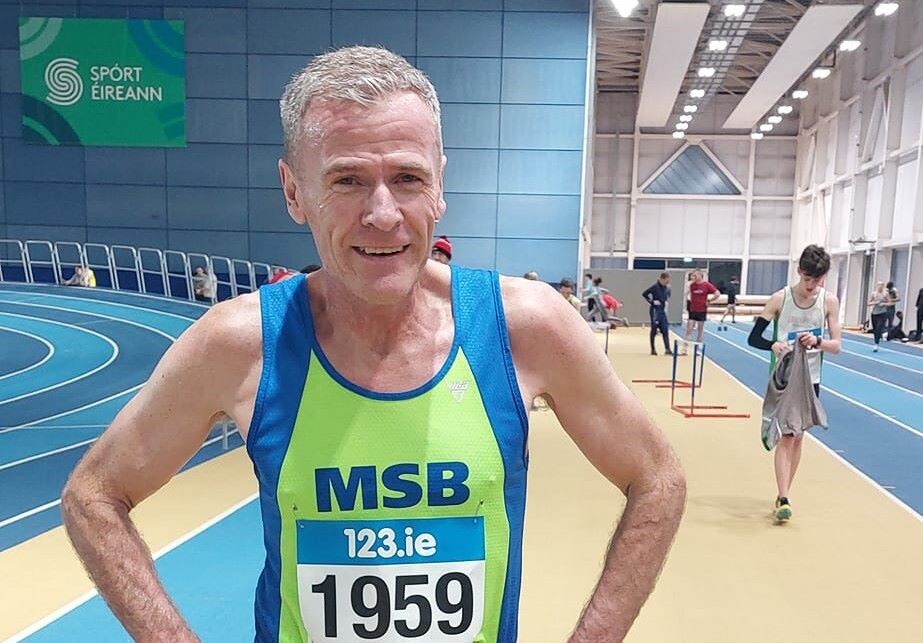
Interestingly enough, the 3,000m world record he broke last week was also held by a German masters runner.
Instead of competing in his age group at the Irish champs, Healy challenged himself and ran against the M35+ category, where he placed second overall. The race was won in 2:01.45, and Healy powered his way to an even split after passing through 400m in 61 seconds. His second-place time in the 800m was also faster than the M40, M45, and M50 winners.
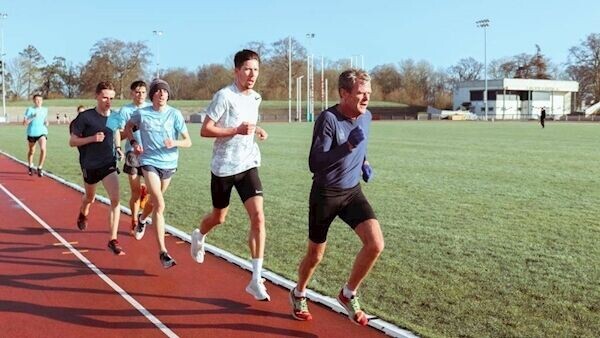
The actual M55 Irish title was won in a respectable 2:16.34, but almost 14 seconds slower than Healy’s time. He also dedicated his new record to his former Irish Olympic teammate David Matthews, who lost his father over the Christmas holidays.
The 55-year-old middle-distance runner has been tearing up the track for several decades. In 1996, Healy represented Ireland at the Atlanta Olympics in the men’s 1,500m, where he made the semi-final. He retired from running in 1999, but after almost a five-year hiatus, he returned to the sport and began breaking Irish and world masters records.
Healy has added three world records to his name in the last year: M55+ 3,000m, 800m, and the M50+ indoor 1,500m record of 4:01.76. It is only a matter of time until he grabs the M55+ 1,500m indoor record of 4:11.79.
(01/16/2024) ⚡AMPby Marley Dickinson
Mary Moraa has returned to training for a grueling 2024 season and is using one of NBA legend Shaquille O'Neal's famous quotes to motivate her
Reigning world 800m champion Mary Moraa is surely on a mission to make history this year as she eyes the Olympic Games in Paris, France scheduled for July 26 to August 11.
As she burns the midnight oil to ensure she makes her dreams come true, Moraa is not leaving her fans out of the mix as she keeps updating them on what she is up to.
In her recent Facebook post, she shared a video of her training at the Nyayo National Stadium and captioned the video with one of NBA legend Shaquille O'Neal’s famous quotes.
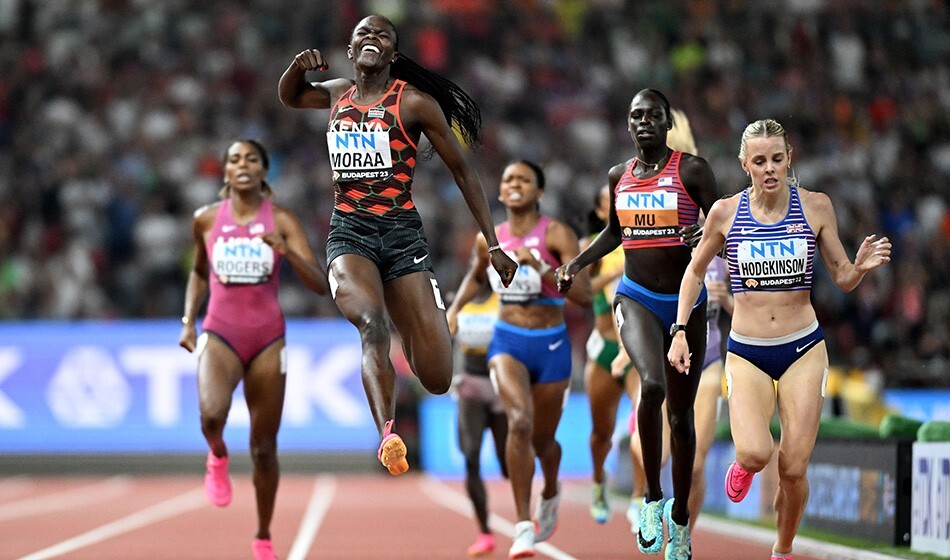
The Commonwealth Games champion said: “Excellence is not a singular act but a habit. You are what you do repeatedly.”
She also added other two photos after returning to training and captioned them saying: “I really enjoyed my first track training session this season with my training regime.”
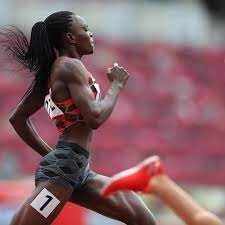
O’Neal was one of the greatest basketball players and centers of all time and Moraa recognizing him means she is on the right track.
Meanwhile, Kisii Express has made it clear that she wants to clock 1:53, the women’s 800m world record, and she is surely putting in the work.
The world record has surely stood the test of time and the world is banking on Moraa to shatter it. It was set by Jarmila Kratochvílová back in 1983.
On July 26, the Czech athlete took to the Olympiapark Meeting in Munich’s Olympic Stadium and shattered the 800m world record, clocking 1:53.28 to win the race.
(01/16/2024) ⚡AMPby Abigael Wuafula
Laura Muir returns to defend wanamaker mile title at 2024 Millrose Games
Great Britain’s Laura Muir, the Olympic 1500m silver medalist and three-time 1500m world championship medalist, will return to the 116th Millrose Games at The Armory on Feb. 11 to defend her NYRR Wanamaker Mile title.
Here’s what you need to know:
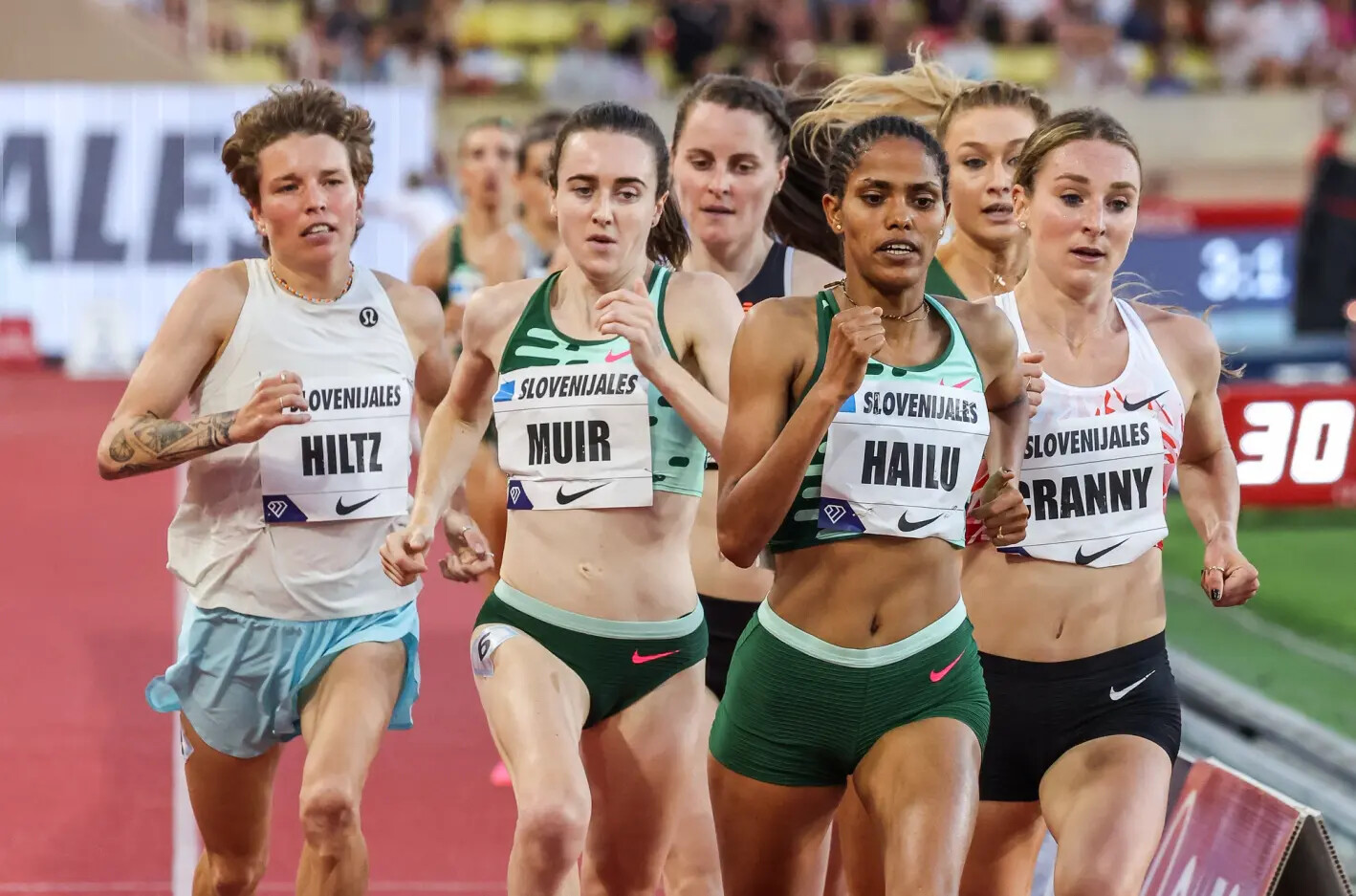
– Last year, Muir closed the race with a 30.99s final lap to win in 4:20.15 over Josette Andrews, who will also be returning after back-to-back runner-up finishes. Muir made her Millrose Games debut last year after a stunning 4:14.8 victory at the 2022 Fifth Avenue Mile. Muir is keeping a tight indoor schedule as she gets ready for the 3000m at the 2024 World Indoor Championships in Glasgow. She just ran 8:34.39 for 3000m at the Cardiff Metropolitan University Christmas Classic on Dec. 19.
– The Wanamaker Mile event record is the 4:16.85 American record set by Elinor Purrier St. Pierre in the 2020 edition of the meet. She will return to The Armory after missing last year’s indoor season while being pregnant with her son, Ivan. She gave birth in March and then returned to racing at the 5th Avenue Mile in September with a 4:23 for seventh place. Purrier -St. Pierre also won the 2019 2022 edition of the Wanamaker Mile with a 4:19.30 victory.
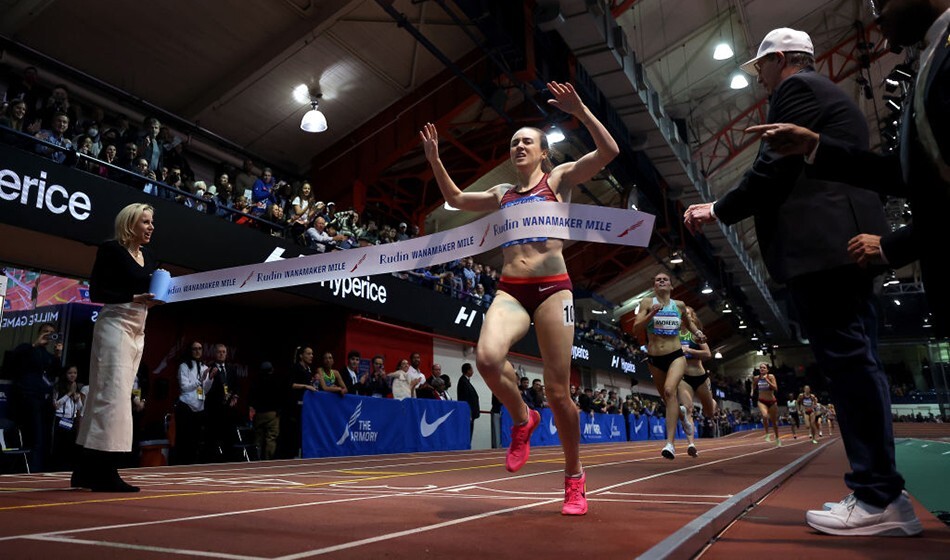
– The field will also include 2023 World Championship 1500m finalists: Jessica Hull (7th in Budapest) and Katie Snowden (8th in Budapest).
– Ethiopia’s Axumawit Embaye, a two-time World Indoor silver medalist in the 1500m, will make her Millrose Games debut. Last year, she ran season’s bests of 4:00.98 for 1500m and 4:24.01 for the mile. She notched a personal best of 15:04.41 for 5000m at the Stockholm Diamond League.
(01/16/2024) ⚡AMPby Chris Chavez
NYRR Millrose Games
The Pinnacle of Indoor Track & Field The NYRR Millrose Games, first held in 1908, remains the premier indoor track and field competition in the United States. The 2025 edition will once again bring the world’s top professional, collegiate, and high school athletes to New York City for a day of thrilling competition. Hosted at the New Balance Track &...
more...Canadian Olympian Andrea Seccafien to debut at Tokyo Marathon
After reaching the Tokyo Olympic 5,000m final in 2021, the next two years were a whirlwind for Canadian 10,000m record holder Andrea Seccafien. The 33-year-old suffered a root meniscus tear in early 2022, then a stress fracture in 2023, and at times, contemplated calling it a career to go back to school. She felt like she was missing something and had one final box to check as a runner: the marathon.
“The plan has always been to move up to the marathon,” says Seccafien. “I will be running the Tokyo Marathon on March 3.”
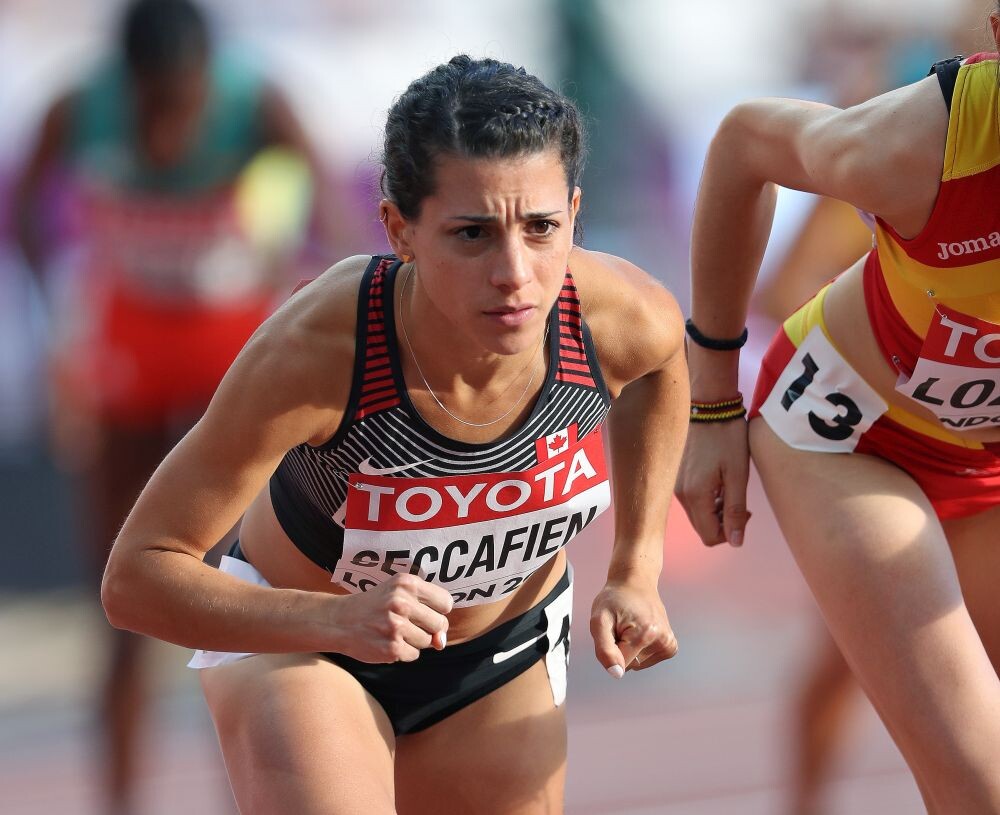
Seccafien told Canadian Running that she wants to be on the Canadian Olympic team for the marathon in Paris: “The Olympic standard [2:26:50] is the goal in Tokyo. I would not be running the marathon if my coach and I did not think it was possible.”
There were a lot of changes for Seccafien last year, who moved from Melbourne, Australia, to Portland, Ore., and back to Melbourne. She left Nike Bowerman Track Club in November 2023 after two years of training under coach Jerry Schumacher. She joined the group with fellow Canadian Lucia Stafford in November 2021 (who also subsequently left the club).

Seccafien says she left Bowerman on good terms. “It wasn’t anything with Jerry; I just did not have a community in Portland or Eugene,” she says. “My life was in Australia, and not in the U.S.” Seccafien is the ninth woman to leave Bowerman Track Club in the past two years, leaving the team with only two women on their roster, according to their website.
When asked about the downfall of the Bowerman team and the timeline around Shelby Houlihan’s doping suspension, Seccafien said that Gabriela DeBues-Stafford was the only athlete who left for that reason specifically: “No one else thought that way about Shelby,” she says. “Everyone in the club has been open with each other’s decision, and I think everyone left for many different reasons.”
“When I joined, I thought running the marathon there would work with Bowerman. Jerry doesn’t have time to coach a marathoner; you’d essentially be training on your own,” says Seccafien. Schumacher took a role with the Oregon Ducks group in Eugene, Ore. (two hours from Portland) while still coaching the Bowerman group. “It’s now a totally different environment than when I joined.”
Since returning to Melbourne, Seccafien has begun working remotely with Canadian physiologist and coach Trent Stellingwerff, who also coaches Olympians Natasha Wodak and DeBues-Stafford. “I wanted to find someone willing to coach me remotely and to give me some stability in my life again,” she says. “Trent calls the shots on mileage, and I just follow his plan. Our training is based more on intensity rather than miles.”
Seccafien says she now does most of her training on her own, with her partner, Jamie, occasionally joining her on the bike. “Like everyone, I’ve started doing double threshold workouts, and Jamie, who’s an exercise physiologist, will test my blood lactate.”
Seccafien told Canadian Running that training has not been easy. “There were a lot of lows. I felt like I had retired at times,” says Seccafien. “I could not put any load on my knee for four months to recover from my meniscus surgery… I could only swim, but could not kick my legs.”
She says it was great when she was finally able to run again, but shortly after, she got a stress fracture –another huge low. “Now, I’m just trying to stay consistent and take things as they come,” she says. Seccafien is seven weeks out from the 2024 Tokyo Marathon, where she will be in the elite field alongside Chicago and London marathon champ Sifan Hassan, whom Seccafien last ran against in the 5,000m final at the Tokyo Olympics (where Hassan won gold).
(01/16/2024) ⚡AMPby Marley Dickinson
Tokyo Marathon
The Tokyo Marathon is a world-renowned annual marathon held in Tokyo, Japan. As one of the prestigious Abbott World Marathon Majors, it attracts elite and amateur runners from around the globe. The race holds World Athletics Platinum Label status, recognizing its high competitive standards, top-tier organization, and international appeal. Sponsored by Tokyo Metro, the Tokyo Marathon has grown into one...
more...Sheila Chepkirui headlines elite field for Kagawa Marugame Half Marathon
Sheila Chepkirui is among the elite athletes invited to the Kagawa Marugame Half Marathon next month.
Commonwealth Games 10,000m bronze medallist Sheila Chepkirui has been confirmed for the Kagawa Marugame Half Marathon scheduled for February 4 in Japan.
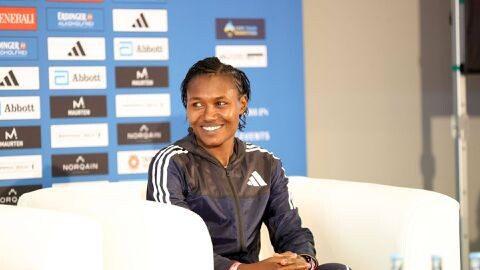
Chepkirui enjoyed a beautiful 2023 season and as she opens her season at the city in Japan, she will have her fingers crossed for an amazing season.
Last season, Chepkirui’s breakthroughs were during the Berlin Marathon and London Marathon. The Kenyan made her full marathon debut at the Valencia Marathon in 2022 where she finished second before stunning the masses last season.
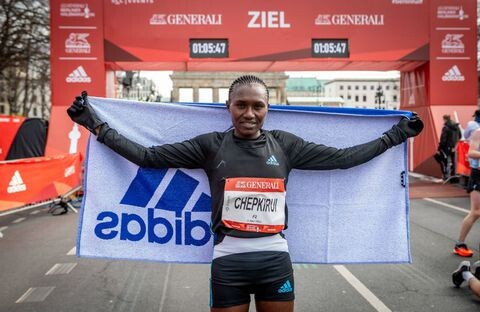
She finished fourth at the London Marathon, her first World Marathon Major before finishing second at the Berlin Marathon.
In the women’s race, she will be joined by compatriots Pauline Kamulu and Dolphine Omare. The greatest opposition will come from Great Britain’s Charlotte Purdue who is one of the greatest long-distance runners.
Meanwhile, the men’s field is headlined by another talented Kenyan, Alexander Mutiso, the reigning Prague Marathon champion.
Mutiso also enjoyed an amazing 2023 season where he impressed in most of his international assignments and is surely among the athletes to watch this season.
The Kenyan started the marathon season by winning the Prague Marathon and finishing second at the Valencia Marathon. He returns to Japan as the defending champion after obliterating a strong field to clinch top honours in the race last year.
Mutiso clocked an impressive time of 59:17 to cross the finish line and proceeded to finish fourth at the Tokyo Legacy Half Marathon. He will be joined by compatriots Charles Langat and Cleophas Kandie.
(01/15/2024) ⚡AMPby Abigael Wuafula
Kagawa Marugame Half Marathon
The Kagawa Marugame Half Marathon is an annual road running competition which takes place in early February in Marugame, Japan. It currently holds IAAF Silver Label Road Race status and the professional races attract over 1000 entries each year, and hosted by the Sankei Shimbun, Sankei Sports, Okayama Broadcasting, BS Fuji. The race in Marugame was first held in 1947...
more...Benard Kibet Koech ready to defend Ras Al Khaimah Half Marathon title
The 17th Ras Al Khaimah Half Marathon will see the welcome return of defending men’s champion Benard Kibet Koech and reigning world half marathon and Olympic marathon champion Peres Jepchirchir.
The Kenyans are the first two of what is expected to be a constellation of stars at the Ras Al Khaimah Half Marathon, hosted by the Ras Al Khaimah Tourism Development Authority (RAKTDA), on February 24.
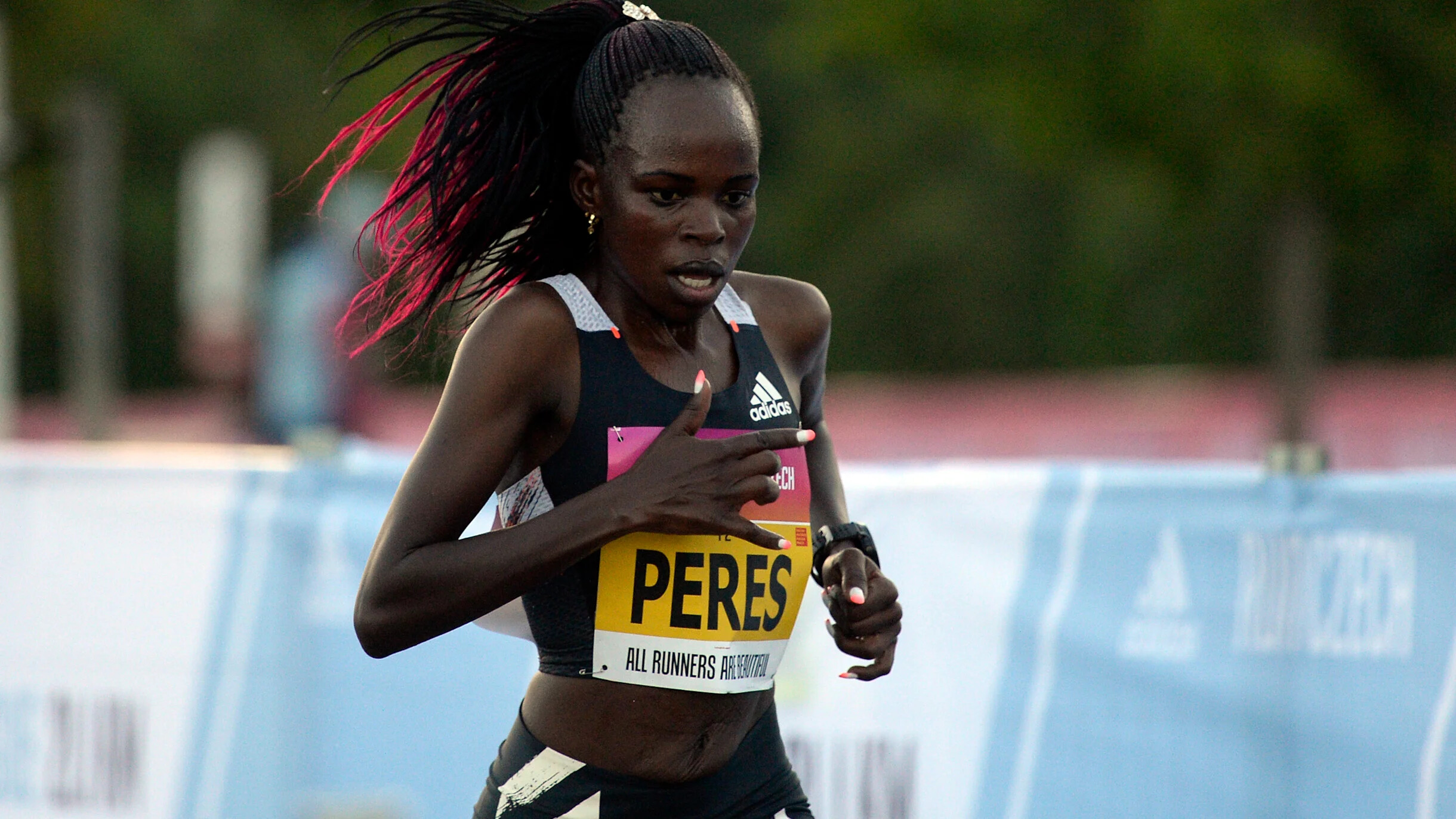
Jepchirchir’s standing as one of the world’s all-time greats is underlined not only by her Olympic marathon win in Tokyo, but also by three individual world half marathon titles, and the considerable feat of being the only woman to simultaneously hold the Olympic, New York and Boston marathon titles, which she achieved in the seven months between August 2021 and April 2022.
When she won the 2017 Ras Al Khaimah Half Marathon it was in a then world record of 65m:06s, which remains her best time.
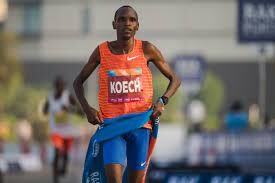
Compatriot Koech is one of many Kenyans recruited to run on one of Japan’s corporate teams. He is similarly unusual in being one of the diminishing number of athletes who combine track with road running and is a 13-minute 5,000 metre runner who also has several 10,000 metre finishes of just over 27 minutes to his name.
His victory last year in Ras Al Khaimah in a time of 58m:45s was one of the 10 fastest of 2023.
Since its inauguration in 2007, the Ras Al Khaimah race has proved to be one of the fastest half marathons on the international circuit with the race staged around the spectacular sea-side route on the iconic Al Marjan Island.
As well as the likes of Koech and Jepchirchir, the Ras Al Khaimah Half Marathon will see thousands of runners coming together in the associated 10km, 5km and 2km runs.
(01/15/2024) ⚡AMPRak Half Marathon
The Rak Al Khaimah Half Marathon is the 'world's fastest half marathon' because if you take the top 10 fastest times recorded in RAK for men (and the same for women) and find the average (for each) and then do the same with the top ten fastest recorded times across all races (you can reference the IAAF for this), the...
more...I will inspire many girls after Paris Olympics – Kipyegon
Two-time Olympic 1500m gold medalist Faith Kipyegon is motivated and ready to write more history and break records in the Paris Olympic Games this year.
The 29-year-old who already has four world titles in 1500m and 5000m to her name, is also keen to enjoy the quadrennial championship and motivate the young girls from the continent and the world at large.
“I’m looking forward to Paris 2024, to step on that track and see what will happen,” Kipyegon said.
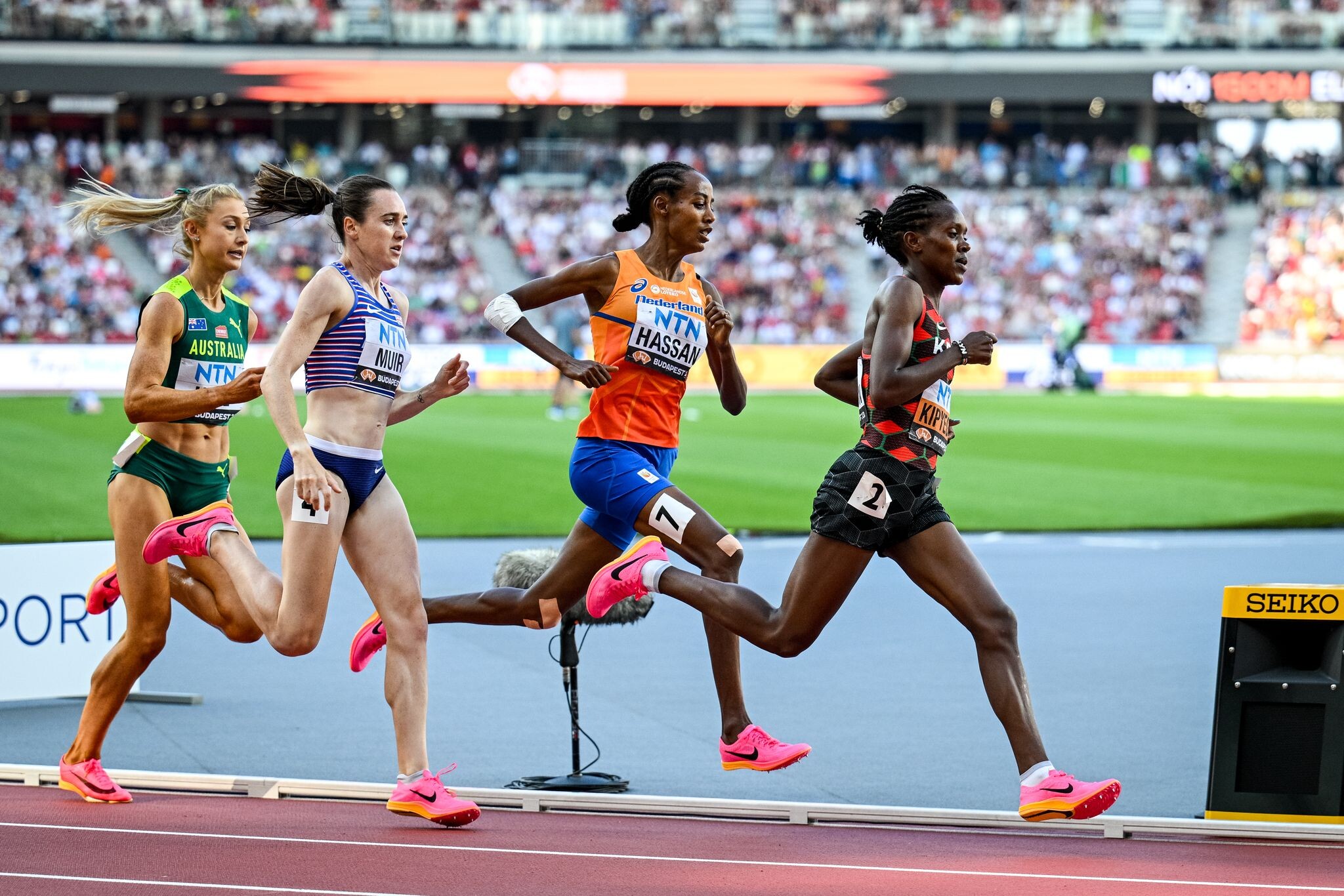
“That’s what we are looking for – to get to the Olympics, get to the track and just enjoy it and see what will come out.”
In 2023, as well as winning 1500m and 5000m gold medals at the World Athletics Championships in Budapest, Kipyegon broke three world records, in the 1500m, mile and 5000m.
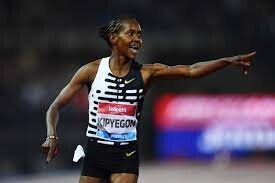
It’s performances like these that she knows will further inspire the next generation, which is another of her aims in 2024.
“Outside of track, and after the Olympics, I think I will motivate and inspire many, especially young girls in my country and Africa and all over the world,” she says. “That is my motivation.
“I want to see them express their talent, follow my footsteps, and I want them to see good role models.”
Kipyegon has never been short of motivation.
Her international career began back at the World Cross Country Championships in Bydgoszcz in 2010.
Running barefoot in the freezing conditions, the then 16-year-old finished fourth in the U20 race.
The following year she got gold in Punta Umbria, before winning that year’s world U18 1500m title in Lille – her first global gold medal in the discipline.
World U20 gold followed in Barcelona in 2012, before senior world titles in London in 2017 and Oregon in 2022, plus Olympic gold medals in Rio and Tokyo.
(01/15/2024) ⚡AMPby Evans Ousuru
Paris 2024 Olympic Games
For this historic event, the City of Light is thinking big! Visitors will be able to watch events at top sporting venues in Paris and the Paris region, as well as at emblematic monuments in the capital visited by several millions of tourists each year. The promise of exceptional moments to experience in an exceptional setting! A great way to...
more...Beatrice Chepkoech to open her indoor track season against two Ethiopian youngsters
Beatrice Chepkoech will be pitted against two Ethiopian youngsters in the women's 1500m at the ORLEN Copernicus Cup, a World Athletics Indoor Tour Gold meeting.
Ethiopian youngsters Diribe Welteji, and Freweyni Hailu will be up against Beatrice Chepkoech in the women’s 1500m field at the ORLEN Copernicus Cup, a World Athletics Indoor Tour Gold meeting, in Torun, Poland, on February 6.
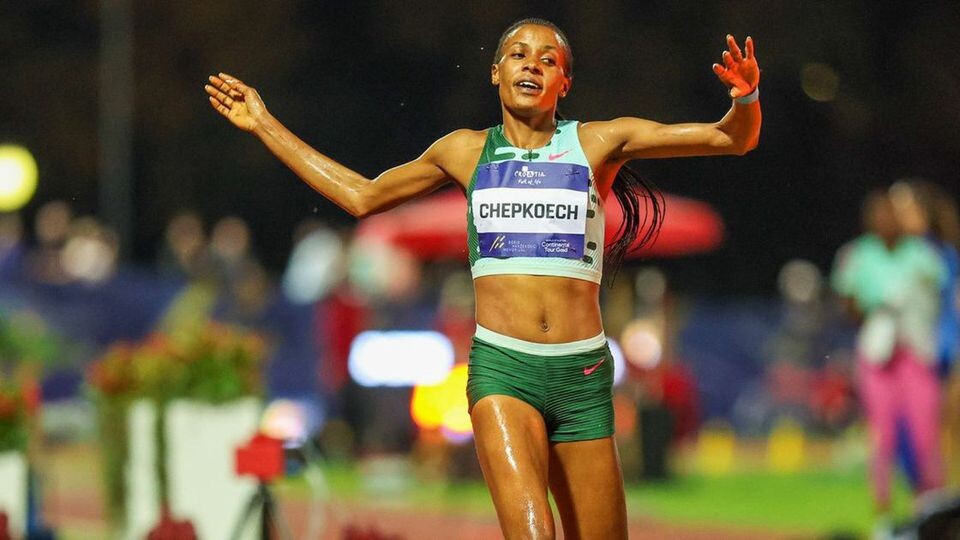
21-year-old Welteji set a world record when winning the mile at the World Athletics Road Running Championships in Riga in October, as she clocked 4:20.98 as her compatriot Hailu finished second with Faith Kipyegon completing the podium.
Welteji and Hailu will team up again in Torun where they will be up against the world 3000m steeplechase record-holder Chepkoech. Other strong opponents in the field include Ethiopia’s world indoor 1500m bronze medallist Hirut Meshesha and Uganda’s 2019 world 800m champion Halimah Nakaayi.
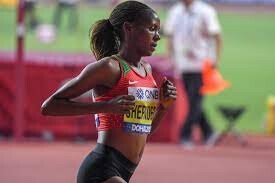
Welteji has proven to be a master in the 1500m and she also doubles up as the World 1500m silver medallist, having finished runner-up to Kipyegon in Budapest in August. She will surely be the one to watch when the race begins.
Meshesha has the quickest short track PB of the quintet, having clocked 4:02.01 in Lievin last year, finishing second and one place ahead of Hailu who set a PB of 4:02.47. Chepkoech ran her national record of 4:02.09 in 2020.
Meanwhile, multiple US record-holder Grant Fisher will take on the already announced world champion Josh Kerr in the two-mile race at the Millrose Games, also a World Athletics Indoor Tour Gold event.
The race on February 11 is set to be paced with the world indoor two-mile best of 8:03.40 as the target. Joining them on the start line will be USA’s Joe Klecker, Cooper Teare, and Dylan Jacobs. New Zealand’s George Beamish, Australia’s Morgan McDonald, and Ky Robinson will also be in the mix and will be joined by Britain’s Matthew Stonier, Japan’s Keita Satoh, Ethiopia’s Samuel Firewu and Addisu Yihune, and Sam Parsons of Germany.
(01/15/2024) ⚡AMPby Abigael Wuafula
Beatrice Chepkoech
Ethiopians Jemal Yimer (60:42) and Sutume Kebede (64:37) won the overall titles in Houston Half
In what is becoming an annual tradition, Weini Kelati ran 66:25 on Sunday to break the American record at the 2024 Aramco Houston Half Marathon. It was the third straight year the record was broken in Houston as the 27-year-old Kelati, making her half marathon debut, followed in the footsteps of Sara Hall (67:15 in 2022) and Emily Sisson (66:52 in 2023) to become a record-breaker in Houston. Sunday marked the third time the record had been broken in the past year as Keira D’Amatolowered Sisson’s record to 66:39 at the Asics Half Marathon in Australia in July.
Kelati finished 4th overall as Ethiopia’s Sutume Kebede, a late addition to the women’s field, upset Hellen Obiri to win in 64:37, a US all-comers record that moves her into a tie for 9th on the all-time list. The time was a pb of more than three minutes for Kebede, who was previously best known for finishing 3rd at the 2020 Tokyo Marathon and running 2:18:12 at the 2022 Seoul Marathon. Obiri, who was with Kebede through 10k (30:28) faded over the second half and wound up a distant 2nd in 66:07.
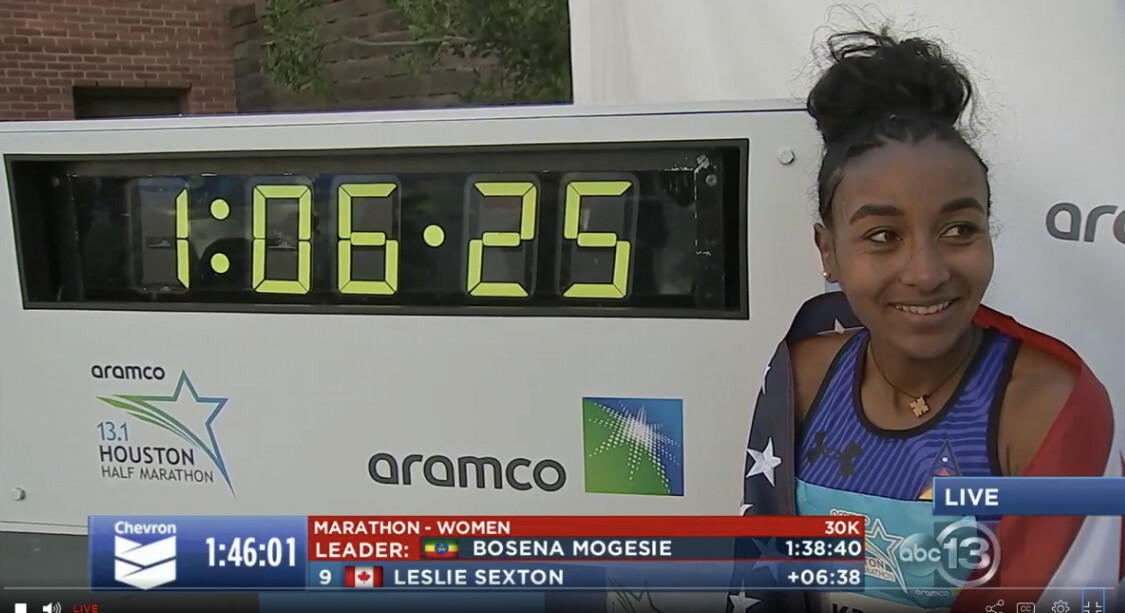
The men’s race came down to a five-man sprint finish with Ethiopia’s Jemal Yimer, who won in Houston in 2020 and was 4th at the World Half Marathon Championships in October, prevailing in 60:42. Wesley Kiptoo of NAZ Elite and Kenya was 2nd for the second straight year in 60:43 with 2022 champ Milkesa Mengeshaof Ethiopia 3rd in 60:45.
Biya Simbassa was the top American man in 60:45 in 4th, just ahead of a resurgent Diego Estrada, who led for the first 20 minutes and finished 5th in a pb of 60:49. Galen Rupp, tuning up for the Olympic Marathon Trials three weeks from now, hung back from the leaders and finished 14th in 62:37.
In the Chevron Houston Marathon, contested simultaneously, former NAIA star Zouhair Talbi of Morocco won the men’s race in 2:06:39 to boost his chances of Olympic selection. 2016 NCAA XC champion Patrick Tiernan, now training as part of Alistair and Amy Cragg’s Puma Elite Running team in North Carolina, was 4th in 2:07:45, hitting the Olympic standard and moving to #2 on the all-time Australian marathon list.

Ethiopia’s Rahma Tusa, the runner-up behind American Betsy Saina in September’s Sydney Marathon, won the women’s marathon in Houston in 2:19:33.
The races featured temperatures in the low 40s with 10 mph winds and gusts up to 17 mph, which made for a challenging end to the half marathon as miles 9, 10, and 11 were run directly into the teeth of the wind.
Below, six takeaways from the day’s racing in Houston.
2024 Houston Half Marathon men’s top 51. 60:42 Jemal Yimer, Ethiopia2. 60:43 Wesley Kiptoo, Kenya3. 60:45 Milkesa Mengesha, Ethiopia4. 60:45 Biya Simbassa, USA5. 60:49 Diego Estrada, USA14. 62:37 Galen Rupp, USA
2024 Houston Half Marathon women’s top 51. 64:37 Sutume Kebede, Ethiopia2. 66:07 Hellen Obiri, Kenya3. 66:24 Buze Diriba, Ethiopia4. 66:25 AR Weini Kelati, USA5. 67:36 Mestawut Fikir, Ethiopia
(01/14/2024) ⚡AMPby Jonathan Gault (Let’s Run)
Aramco Houston Half Marathon
The Chevron Houston Marathon provides runners with a one-of-a-kind experience in the vibrant and dynamic setting of America's fourth-largest city. Renowned for its fast, flat, and scenic single-loop course, the race has earned accolades as the "fastest winter marathon" and the "second fastest marathon overall," according to the Ultimate Guide to Marathons. It’s a perfect opportunity for both elite athletes...
more...Ngetich smashes world 10km record with 28:46 in Valencia
Kenya's Agnes Ngetich obliterated the women's world 10km record by running 28:46* at the 10K Valencia Ibercaja, a World Athletics Label road race, on Sunday (14).
The 22-year-old becomes the first woman to break 29 minutes for the distance, improving by 28 seconds the previous road mixed race world record set by Ethiopia’s Yalemzerf Yehualaw in Castellon two years ago.
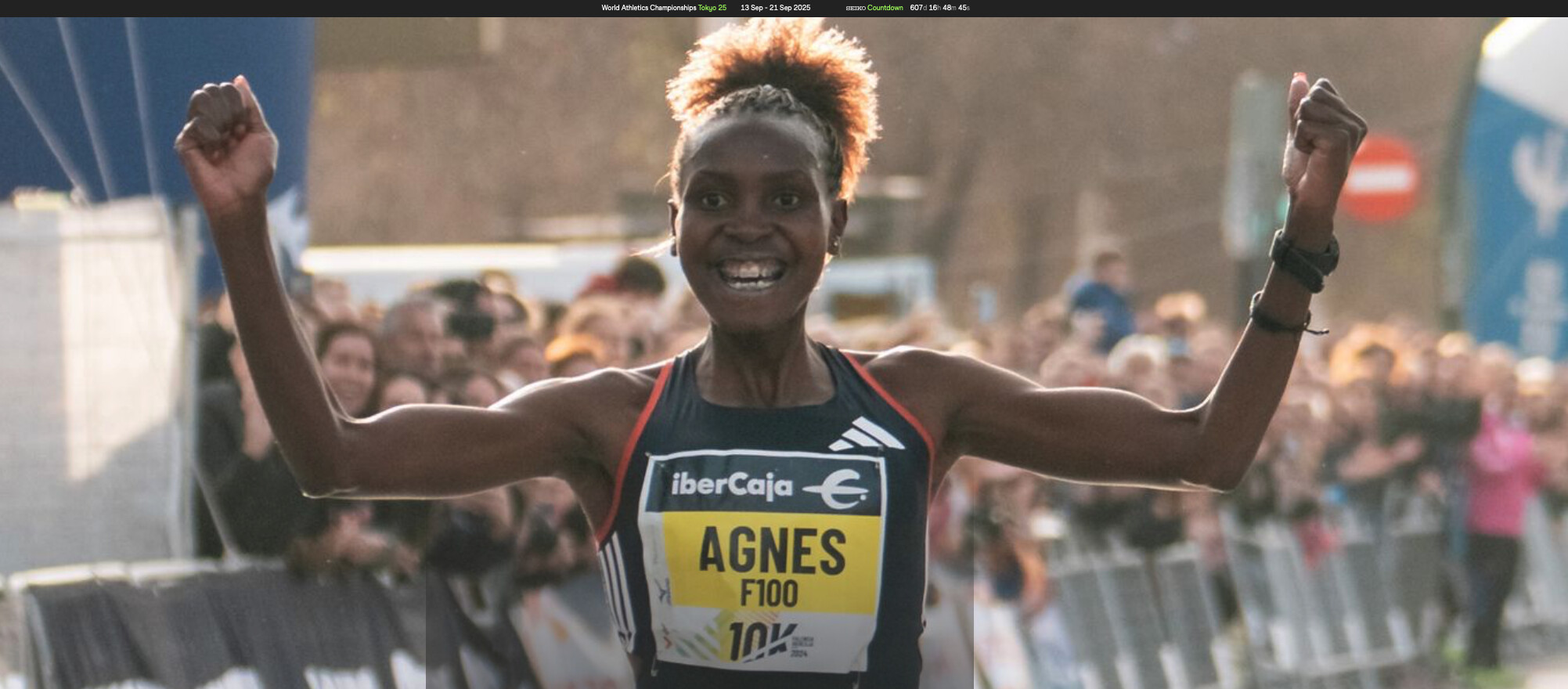
World cross country bronze medallist Ngetich was paced in the Spanish coastal city by her compatriot Japheth Kipkemboi Kosgei and the first world record fell at half way as Ngetich went through the 5km checkpoint in 14:13. That is six seconds faster than the women’s world record achieved in a mixed race, set by Ethiopia’s Ejgayehu Taye in Barcelona in 2021, and matches the time Kenya’s Beatrice Chebet set in a woman-only race in Barcelona a fortnight ago.
Ngetich’s 10km time is also faster than the women's world record for the distance on the track, with Letesenbet Gidey’s world 10,000m record standing at 29:01.03.
Emmaculate Anyango also dipped under 29 minutes in Valencia, clocking 28:57 to finish runner-up to her compatriot Ngetich.
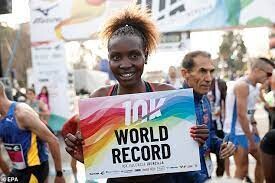
"I am so happy. I didn't expect this world record," said Ngetich. "I was coming to improve my time, at least somewhere around 29:14, but I am happy that I ran a world record of 28 minutes. I didn't expect this."
She will now focus on the World Athletics Cross Country Championships Belgrade 24 in March and then the Paris 2024 Olympic Games, where athletics will be the No.1 sport in August.
The men’s race was won by Uganda’s Jacob Kiplimo in 26:48.
(01/14/2024) ⚡AMPby World Athletics
10k Valencia Trinidad Alfonso
Around the corner we have one more edition of the 10K Valencia Ibercaja, organized one more year by the C. 10K VALENCIA Athletics premiering the running season in Valencia. It is a massive urban race with more than 3,000 registered annually of 10 kilometers, where the maximum duration of the test will be 1 hour 40 minutes (100 minutes). The...
more...The Wild, Uncertain Science of Post-Exercise Ketones
A new review study points toward post-exercise ketone supplementation as a way to improve adaptation and performance. What does the uncertain science mean for endurance athletes?
I heard about athletes supplementing with ketones sometime in the mid-2010s. A company reached out, promising the next big breakthrough in endurance performance from this liquid supplement composed of a molecule naturally produced in the body from the breakdown of free fatty acids. They told me that the top cyclists in the world were already using ketones and that it was destined to take over running, too. They sent a few boxes…and they collected dust in the pantry. It felt like a biohack, and I wasn’t comfortable with it.

Over the years, more studies on ketone ingestion emerged, and I started to get more and more intrigued. Rumors came out that about 70 percent of the cycling peloton used the stuff. But they cost a ton, and it was hard to discern what was actual practice and what was just marketing.
It wasn’t until 2023, though, that I embraced that ketones were here to stay, whether I liked it or not. A 2023 study in the American Journal of Physiology-Endocrine and Metabolism had nine men complete two cycling trials, both with one hour consisting of two minutes at 90 percent of aerobic capacity (moderately hard), followed by two minutes at 50 percent of aerobic capacity (very easy). In both trials, the cyclists consumed a carb-protein drink immediately after exercise and at one, two, and three hours later. Here’s the study intervention: in just one trial, participants ingested 0.29 g/kg ketone monoester immediately after exercise and at one and two hours later.
The ketone trial led to 20 percent higher levels of natural erythropoietin (EPO) in the bloodstream.
For comparison, a 2005 study in the British Journal of Sports Medicine found that the initial exposure to altitude training increased EPO by an average of around 50 percent in swimmers, with large individual variability (returning to baseline after a couple of weeks of altitude training), with lots of variation across studies. Given that our bodies produce EPO to increase red blood cell production, and red blood cells transport oxygen that power endurance performance, the ketone study indicated that we could be seeing a supplement that supercharges adaptation and performance.
Context for Ketones
To be 100 percent honest, I was sad when I saw this study. I love performance physiology, but I don’t want to think about a new biohack. Maybe it’s a sign that I’m getting old when a study on cutting-edge science just makes me tired. Get these research protocols off my lawn!
But I also couldn’t bury my head in the sand (though that would probably increase EPO concentrations via hypoxia). Instead of giving into my old-coach fatigue, maybe I can help publicize the emerging science so fewer athletes have an information disadvantage. My final push was last week when a fantastic review article was published in the American Journal of Physiology-Cell Physiology by Ruben Robberechts and Chiel Poffé. If ketone supplementation has the potential that some think it may, the article could be a key step in the future of exercise physiology.
Before getting to the science, I think it’s important to lay out the stakes. Based on the articles (mixed with a heaping dose of gossip), I can see three different scenarios unfolding over the next 10 years.
One, post-exercise ketones don’t live up to their promise, and this is all a nothingburger. That outcome would please me the most, and we all know that what’s most important in science is my pleasure. If researchers did this type of theoretical analysis on other interventions (i.e. heat training, Vitamin D, lifting, ashwagandha, strides, beta-alanine, doubles, creatine), they could come back with similar findings. We are only talking about a few intervention studies and lots of theory, and future research could have different results. Plus, some critics would already be confident making their judgments as the Supreme Court of Nothingburgerland.
Two, ketones could become a more commonly used supplement with benefits for performance and health (like iron). They are expensive, which isn’t great, but maybe they will help athletes be healthier and faster, with limited side effects. On the flip side, maybe more research indicates tradeoffs that lead to benefit:risk calculations with performance or health. Over email, Dr. Poffé–an author of the review study and a key researcher in this field–says that “studies have shown divergent effects on performance depending on the exercise context and whether you take them before, during or after exercise.” Even if they are beneficial in some contexts, it’s not a simple equation of take ketones = get faster.
The third possibility is that they are banned as an illegal performance enhancer. I have no inside info on whether that’s a possibility, and at first blush, it doesn’t seem likely without some health risks. Dr. Poffé says “I honestly don’t see much of a reason to ban ketones while allowing other ergogenic supplements.”
So, yeah, we’re talking about a wide range of possibilities, which makes sense given the uncertain mechanisms and effects at play. Let’s dig in. (We got even deeper into the nuance on our podcast this week, which you can listen to here.)
Introduction to Ketones
As stated by the review study, ketone bodies “are molecules that are continuously produced from the breakdown of free fatty acids,” primarily in the liver. Ketone body production is upregulated during periods of low carbohydrate availability—that’s why you have heard “ketosis” thrown around for ultrarunners who practice low carbohydrate, high-fat nutrition, aiming to improve fat oxidation and avoid bonking. Ketosis via nutritional interventions comes with way too many downsides for endurance athletes, though, including everything from reduced bone density to diminished high-intensity performance. That makes sense intuitively because low carbohydrate availability is extremely stressful on most body functions, especially the endocrine system.
Ketone esters, enter stage left. Researchers figured out how to create an ester bond between a ketone body precursor and a ketone body (first in 1978 in rats, but not undergoing human testing until 2012). These ketone esters cause a “rapid and transient increase in ketone bodies,” possibly inducing ketosis. It was as if this evolutionary mechanism honed over millions of years now had a dimmer switch. For the chemistry nerds out there, you can probably guess what oral ingestion of an ester is like—not fun. Companies like HVMN honed the taste over time, and now I’d say that ketone esters taste like a robot’s ass. We can only imagine what they tasted like before.
Ketones have mostly been marketed as a before-and-during-exercise supplement, at least in the podcast ads I have heard. Take ketones, burn more fat at higher intensities, win the Tour de France, etc. However, a bunch of studies have shown limited to no acute benefit. For example, a 2017 study in Frontiers of Physiology found that pre-exercise ketone supplementation caused around a two percent performance decrease in 10 male professional cyclists doing a 50-minute time trial.
Perhaps there’s some protocol being used in the cycling peloton that improves acute performance, as the marketing claims indicate. Heck, Tom Evans reportedly took ketone esters on his way to winning Western States, so there must be some benefit for some athletes (or at least neutral impacts), possibly related to perceived effort. Anecdotally, when I tried ketones on a fatigued long run, the lights went out. Thankfully, I had my phone to call the Wuber (when my wife Megan drives to pick me up).
So perhaps it’s something else. Maybe all this ketone hype is because taking them improves recovery and hematological variables, confounding variables that are actually the driving force behind their use (maybe that even explains some of the success stories behind low carb, high fat nutrition approaches. I’d love to see the blood work!).
According to the review, after exercise, circulating ketone bodies are increased. However, any benefits athletes may see from a sustained increase are blunted in advanced athletes practicing good recovery nutrition. Ketone esters “may induce a unique physiological milieu to enhance post-exercise recovery and exercise adaptation as it allows to benefit from the potential beneficial effect of post-exercise ketosis in combination with other nutritional exercise recovery strategies (e.g., carbohydrate-protein recovery drink).” They had me at physiological milieu. Dr. Poffé says that his lab started ketone work in 2016 when “there was already some preliminary data showing that it could help riders during the Tour de France as a recovery aid.”
Mechanisms of Post-Exercise Ketones
I can’t emphasize enough how great this review article is, summarizing extremely uncertain science and studies. Before getting to the EPO mechanisms, let’s briefly touch on a bunch of other considerations. First, ketone bodies may cause epigenetic changes. For example, histone lysine β-hydroxybutylation could increase with ketone body increases, which may “increase transcription of genes involved in the adaptive response to exercise.” Across several different epigenetic mechanisms, it’s possible that ketone bodies could be a signal to the body to adapt to stimuli (which makes sense given their evolutionary role in exercise in energy-limited environments).
Second, ketones could “enhance the restoration of cellular energy status after exercise” while also blunting AMPK phosphorylation, which could enhance recovery due to its role in cellular stress or decrease adaptation due to its role in mitochondrial biogenesis. I love this one because that maybe-good, maybe-bad uncertainty regarding downregulation of AMPK points out just how little is known about the long-term consequences of post-exercise ketones, particularly in conjunction with other impacts.
Third, ketones alter g-receptor signaling, which “mediate cellular responses to a wide variety of external agents.” Fourth, ketones show anti-inflammation and anti-oxidation properties, which seems good at first glance but could theoretically cause long-term reductions in training adaptations since the inflammation response can spur adaptation. Fifth, ketones may influence neurotransmitter concentrations in the brain, which could profoundly impact perceived exertion (and possibly even mental health, though that’s a topic for another day).
The next cohort of potential adaptations are at the cutting edge of science but still theoretical. Ketones could increase muscle glycogen resynthesis, reduce protein degradation and enhance protein synthesis, spur angiogenesis that leads to more capillaries to supply blood to working muscles, induce favorable changes in muscle mitochondria, and improve sleep quality in athletes who are training hard. You can put those variables together with a 2019 study in the Journal of Physiology, where male athletes completed a three-week overload training block with six days a week of two-a-day training sessions, with one group having post-exercise ketones. That study found higher tolerated training load in the ketone group and improved performance. (The study was the subject of a Letter to the Editor disputing some of the conclusions.)
A 2023 study looked at a similar three-week overload block, validating the findings. They had 18 male athletes complete 10 training sessions per week, with one group taking post-exercise and pre-sleep ketones and the other taking a placebo. The ketone group “increased the number of capillary contacts and the capillary-to-fibre perimeter exchange index by 44 percent and 42 percent,” plus “substantially increased vascular endothelial growth factor and endothelial nitric oxide synthase expression both at the protein and at the mRNA level.” And the money finding: EPO concentrations in the ketone group increased by 26 percent. That study was eye-opening for the possible recovery and adaptation benefits of ketones, and it brings us back to the elephant in the room: potential hematological changes from increased EPO production.
Hematological Changes
In 2018, a study in the Diabetes Care journal found increasing levels of EPO after a ketone body infusion. The authors of the 2023 study that started this article cited this study as part of the impetus for their investigation (read their amazing summary here). We’re seeing similar findings in athletes in the 2023 studies, which found 20 percent and 26 percent increases in EPO production in the ketone groups relative to controls. But the science is not there to make a definitive conclusion.
In the title of this article, I promised uncertain science, and now we are deep in it. First, we don’t know how much this EPO change may impact performance. “Currently,” the review says, “it has not been identified if the observed changes in EPO post-exercise are indeed sufficient to induce an improvement in hemoglobin mass and oxygen transport capacity in humans, and whether these effects are additive to stimuli that are frequently used by athletes to increases EPO such as hypoxia.” It’s possible that these changes don’t correspond to performance benefits.
And get a load of this: “The precise physiological mechanism underlying ketone body-induced upregulation of EPO is currently unknown.” However, based on mouse models, the researchers theorize that it relates to H39K acetylation in kidney cells.
Are Ketones the Future?
There are tons of unanswered questions. How do these types of adaptations change over time? The longest study right now is a few weeks.
Do the processes change in female athletes? That’s one of my big concerns in making any recommendations since metabolic processes can vary based on gender. While more research is needed, Dr. Poffé indicates that past studies likely show that the results can be extrapolated to female athletes. “In a recent, unpublished study,” he says, “we observed that some effects are even more pronounced in females.”
How about aging athletes? Athletes of different levels, with different goals and backgrounds? What’s the right dosage and timing? Would the same responses happen at altitude? Should consumption be periodized? With similar studies, would other interventions lead to similar findings? Should ketones be banned altogether?
I don’t know the answers to those questions, and a lot more studies are needed before I make coaching recommendations other than “be careful” and “keep it simple.”
“Similar to most nutritional supplements,” Dr. Poffé says, “the long term effects (e.g. what occurs if you supplement for multiple years) are not known.” When athletes take ketones, he says instead of taking them chronically, to supplement “during periods of limited recovery opportunities,” like training camps. From a performance perspective, he advises to consider ketones when everything else is sorted out around training, nutrition, and recovery. They are “the final step,” not the first one.
In September, after reading the research, I dusted off that old package of ketones and opened up a serving for myself. Then I threw it in the trash because it seemed like a health hazard after all those years. I ordered a new package and started experimenting with them a couple days a week post-exercise. In October, at the Blue Sky Marathon, I closed the final four miles two minutes faster than last year to set a course record.
That probably had nothing to do with ketones, right? I’m no Olympian, but I train hard. And when looking back on the race and why I could finish so fast while feeling so good, I would be burying my head in the sand not to consider one of the only variables that changed.
I’m not sure what the future holds with post-exercise ketone supplementation. Maybe it’s all snake oil and placebo, with some studies that find physiological anomalies without a demonstration that it fundamentally alters performance trajectories, destined to be covering dust in the pantry of exercise physiology history.
Or maybe we’re seeing the dawn of a revolution in endurance training and performance.
(01/14/2024) ⚡AMP
by David Roche (Trail Runner Magazine)
How to Make Your Easy Runs Faster, While Still Keeping Them Easy
Steal these tips for getting faster on your zone 2 runs—while still keeping them easy.
Good news: We’re giving you permission to take it easy. Whether you’re gearing up for a race or running regularly to stay in shape, you should be doing the vast majority of your weekly mileage at a totally comfortable effort.

“An easy run should be at a casual pace that feels easily sustainable and not taxing—when you’re done, it should feel like you could keep going and going,” says Meg Takacs, NASM-CPT, a run coach and founder of the Movement & Miles app.
Although the whole focus of this type of run is to go easy and not stress about your pace, when you’re able to run faster (while still feeling relaxed), you’ll tick off more miles in less time—and be able to get on with the rest of your day sooner.
Keep reading for more about how to dial into the right effort for easy runs and what workouts to add to your routine to make those outings a little speedier.
The Benefits of Easy Run Pace
The name is pretty self-explanatory: An easy run is any workout that’s not a long training run or speed work, and it should be done at a relaxed effort. The purpose, explains Takacs, is to build up your aerobic system, which uses oxygen as its primary source of energy. “When your aerobic system is strong, you can optimize your performance on anaerobic runs—a.k.a., speed days—as well,” she says.
There are a lot of adaptations happening in your body during these slower efforts. “Easy runs are extremely beneficial from a physiological standpoint: They increase capillaries, which supply blood to the muscles; increase mitochondria, which converts fat and carbs into fuel; and improve aerobic capacity, the amount of oxygen your body can use while running,” says Takacs.
They also help your body bounce back from harder efforts—like long runs or sprint repeats, for example—and help combat injuries. “Easy runs, especially for people who run endurance races, are a form of active recovery,” says Gabe Gonzales, head coach and master trainer with STRIDE Fitness in Lubbock, Texas. “Moving your body at a slower pace and keeping your heart rate down flushes lactic acid buildup, avoids putting excess strain on your muscles and joints, and helps your body get stronger and ready to go again.”
How to Find the Right Easy Run Pace
To find your groove on an easy run, use the talk test, says Gonzales: “You should be able to easily hold a conversation with someone throughout the entire run,” he says. “If your heart rate starts to go up and you start having a harder time breathing or talking, you need to dial it back.”
You can also gauge if your pace is relaxed enough by aiming for a rate of perceived exertion (RPE) of no more than 5 or 6. Or if you’re into tracking your heart rate, go for zone 2, or 60 to 70 percent of your max, advises Takacs.
Whatever you do, resist the urge to kick it up a notch—even if you’re listening to music that makes you feel good and makes a moderate effort feel easier than usual. If you do so, “your recovery is harder, it’s more taxing on the body, and you’re more susceptible to overuse injuries,” says Takacs. Plus, she adds, you’ll miss out on those physiological benefits, “which are key to building a solid foundation for being able to run faster and farther.”
How to Make Your Easy Runs Faster
Okay, yes, wanting to do an easy run faster is a bit counterintuitive. You’re not supposed to care how fast you’re going, after all. But while you shouldn’t actively try to push your pace during easy outings, the volume and intensity of your weekly runs can help you gradually get faster without pushing the effort level up (which would, in turn, nix some of the easy-run benefits).
Gradually Build Mileage
In terms of total weekly mileage, there’s not a magic number that will help your easy run pace improve, says Takacs, as it depends on your fitness level and heart rate. She recommends gradually building up your mileage, always keeping around 80 percent of your runs throughout the week at an easy effort.
Mix Intervals Into Other Days
Once a week, mix in some faster intervals with a fartlek run (a type of unstructured speed work where you play around with your speed throughout), suggests Gonzales. “Adding very short bursts of intensity into a run at an overall slow, easy pace helps your body adapt to those quicker paces at the same time you’re building endurance,” he says.
Adding some workouts incorporating hill repeats can also help, he says, because they strengthen the lower body and will help increase your power output overall—making an easy effort eventually feel even easier.
Build Strength
Along with speed work, make sure you’re getting in some resistance sessions, too. “Strength training is a very important factor in building endurance and durability of your muscles, and it improves your power output,” says Gonzales.
It may also help make you faster by making you a more efficient runner; exercises such as leg presses and plyometric jumps lead to significant improvements in running economy, according to a 2022 review published in the journal Sports. Plus, says Takacs, resistance training improves joint strength, which can increase your speed by improving your mechanics.
For the biggest benefit, Gonzales recommends lower body moves that work your glutes and hamstrings—like squats and deadlifts; core moves like Russian twists or mountain climbers; and moves that strengthen your shoulders, like overhead presses, lateral raises, and dumbbell flys—to add power to your arm swing. For each of these moves, he suggests doing two to three sets of eight to 10 reps at least twice a week.
Give Yourself Time
Becoming a faster runner during easy session is a long game. Even if clocking a faster easy run pace is one of your goals, prioritizing the time on your feet and a relaxed effort—rather than pushing into a moderate effort on easy runs—will be the most beneficial in the long term, notes Takacs. “The longer you can sustain an easy effort, the easier it is to gradually increase your pace while maintaining that easy, zone 2 heart rate,” she says
(01/14/2024) ⚡AMPby Runner’s World
Bored, Injured, or Experiencing a Plateau? Here’s How to Shake Up Your Running
Plus, coach-approved ways to shake up your training. We’re all for having a set run schedule, considering the ease it can bring to your life. You don’t have to formulate workouts on the fly or do any guesswork over how to reach your goals—simply lace up and follow the plan.
But sometimes, too much structure can backfire, causing you to fall into a rut. And that can zap the joy out of running, transforming the activity you once loved into nothing but negativity.
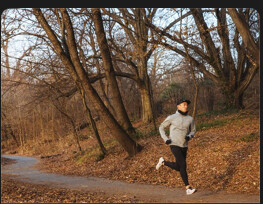
Fortunately, there are simple things you can do to bust out of a rut and get back into a happy running groove. First though, you have to identify that you’re in one.
With that in mind, we tapped two coaches to learn the signs of when you might want to switch up your run routine, and what those signs might indicate. Plus, exactly how to inject excitement back into your runs. Let this be the permission you need to try something new.
1. You Dread Working Out
It’s normal to feel less-than-chipper about an occasional workout, but if you find yourself outright dreading your runs more often than not, “it’s time to reassess,” Kaila DeRienzo, a South Carolina-based certified personal trainer and certified run coach tells Runner’s World.
The potential cause: A few things could lead to dreading workouts. One possible culprit: Your workouts are too challenging because you’ve set a goal that’s unrealistic for your current fitness level, Kai Ng, USATF- and RRCA-certified run coach in New Jersey and New York, tells Runner’s World. Runs and workouts that are too hard cause you to overtrain and ultimately loathe your workouts because all you’re really doing is just beating up your body.
Another potential cause: Other stressful factors in your life, such as a tough work schedule, or demanding caregiver responsibilities, or parenting duties, all of which can make it tough to devote as much time to running as your current training plan dictates, Ng says.
The fix: First, have an honest conversation with yourself to understand why you’re feeling amiss, DeRienzo suggests. By identifying the root cause of your malaise, you can take targeted steps to address it, she explains.
For example, if your dread is tied to a too-lofty goal, such as trying to run four days a week instead of aiming for a more manageable two days or aiming for a PR in a marathon instead of a half or 10K, then let yourself off the hook by lowering the bar. Though it’s great to dream big, it’s also important to be realistic. “Smaller wins are so, so important,” Ng says, as they help build confidence.
If you pinpoint other factors in your life that are making it tough to stick with your current plan, be honest about what you’re actually able to commit to right now and adjust your routine accordingly, Ng suggests. Maybe this isn’t the season to log 50 miles a week, or finally run a marathon. That’s okay. Not every training cycle needs to end with a PR.
Lastly, if you realize the sense of dread extends beyond running and into other areas of your life, you may be struggling with a mental health issue, such as depression. In this case, talk to a trained professional, DeRienzo says.
2. You’re Really Bored
People get into running for various reasons, but one common thread that inspires folks to stick with it is that it engages and challenges them. If you find that your sense of joy about running has evaporated—for example, workouts or races that once felt exciting are now ho-hum—that’s worth looking into.
The potential cause: You may not be challenged enough, Ng says. While all runners should regularly pencil in easy runs, only doing workouts that feel like a walk in the park can lead to boredom.
Alternatively, you may not be injecting enough variety into your routine. Perhaps you run the same route every. single. day. Or you carbon copy your workouts week after week. That level of monotony can also lead to boredom.
The fix: First, evaluate your fitness to get a solid sense of your current abilities in order to help figure out how to best challenge yourself.
“Whether it is a fitness test, a time trial, a race, get out there and see where you’re at and how you stack up,” Ng says. From there, level up your plan as needed. You might want to talk to a coach for some helpful guidance.
On the other hand, if you suspect your boredom is due to monotony, shake things up by exploring new running routes (Strava can be a great tool for this), joining a local run club (Ng suggests trying out a different one each week), or experimenting with different types of workouts. This could look like venturing out on trails if you’re typically a road runner or challenging yourself to run hills if you normally go flat.
Dabbling in forms of exercise outside of running, such as swimming, cycling, dance, and Pilates—really whatever tickles your fancy—can also help add variety and excitement to your schedule.
Finally, you can also reignite your spark with running by treating yourself to something novel, like a fresh pair of shoes, a snazzy new training outfit, or a fancy fitness tracker. “Getting something new always shakes things up,” says Ng.
3. You’re Dealing with Injuries
According to 2021 study published in the Journal of Health and Sport Science, 50 percent of runners experience some type of injury every year that prevents them from running for a period of time, and 25 percent of runners are injured at any given time. These injuries can range from shin splints to ankle and knee problems.
In other words: Almost every runner deals with injury at some point, but if ailments continuously crop up, that’s a surefire red flag your plan needs adjusting.
The potential cause: Chances are, you’re overtraining by either running too many miles, logging too many high-intensity runs, or not allowing your body enough recovery time in between sessions, Ng says.
The fix: It’s common sense, but it bears repeating: Don’t train through injury. Instead, scale back your running to allow your body time to heal. Seek help as needed from a physical therapist or coach to fully mend the issue and get their guidance on how to avoid future injuries.
Keep in mind that factors like poor sleep and inadequate nutrition can increase your odds of injury, so take an honest look at your overall lifestyle and make adjustments as needed.
4. Your Progress Has Stalled
If, despite consistent efforts, your performance in workouts and races has stagnated, then it’s high time to re-evaluate your current plan.
The potential cause: You may be overtraining or struggling with a nutrition issue, says Ng, both of which can sabotage performance because your body isn’t getting the recovery it needs. Or, quite possibly, you don’t have enough variety in your routine, DeRienzo says.
Over time, your body adapts to the work you demand, and if you don’t routinely challenge your body in novel ways, eventually you’ll stop seeing progress.
As the American Council on Exercise explains: “Doing the same exercise repeatedly could lead to a plateau where no more physiological changes occur.”
The fix: If you suspect you’re plateauing due to overtraining or nutrition problems, dial back your mileage and/or workout intensity and focus on eating frequent, well-balanced meals.
Also, inject other types of exercise into your schedule. “Move in different ways,” says Ng, explaining that most any type of cross-training movement—from strength training to skiing to swimming to yoga—is beneficial for runners. Because running is such a linear sport (you move in just one direction: forward), taking the time to build your strength and athleticism in other ways can ultimately make you a stronger, more resilient runner.
Now, if you realize your stagnation is due to an unchanging run routine, spice things up however you can: Add speed work, hit the hills, challenge yourself to run longer, or try new interval workouts. “Having something new and exciting to look forward to each day of the week is going to keep it mentally stimulating and also keep your body stimulated, too,” DeRienzo explains.
5. You Don’t Feel Confident in Your Workouts
If you don’t have a training plan, have low confidence in your program, or are unsure if the schedule you’re following is inching your toward your goals, it’s time to rethink your approach.
The potential cause: Choosing the right training plan for you and your goals can help you feel accomplished by checking off workouts one by one. Plus, it will give more structure to your training so you get the right mix of intensities within your workouts and the right amount of rest—rather than simply winging it. If you have a plan, but it’s too generalized and not personalized to you, says DeRienzo, it may also leave you feeling less than confident in your training. “What somebody else does is not going to be the most beneficial” for your situation, she explains.
The fix: Find the right training plan for you by determining your fitness level and your goals. (You can also use our quiz to point you in the right direction.)
If you're serious about becoming a better runner, you might also consider hiring a coach—even for just a few months—to get personalized guidance and a curated-for-you plan.
“There’s a myth that run coaching is super expensive,” says Derienzo. Truth is, “it’s a lot more affordable than personal training,” she says, noting that in her experiences, it’s realistic to find support for less than $100 per month. Search platforms like CoachUp, Training Peaks, and RunDoyen to connect with a pro.
6. You’re Missing Workouts
While skipping a run here and there is NBD, if you’re consistently bailing on workouts, then your run plan clearly isn’t working for you.
The potential cause: Life is probably too busy right now to sustain the level of running your plan requires, says Ng. Or, you may just need more rest. Either way, your current approach just isn’t appropriate for your schedule or fitness level.
The fix: Take a close look at your schedule and map out which days make the most sense to do which workouts, says Ng. For example, instead of attempting long runs on Sundays like everyone, you might realize Wednesdays are more ideal since you don’t have any work meetings then. Or, perhaps Friday becomes your new strength training day instead of Tuesday, since the gym is less crowded then, making it easier to get in and out.
Taking the time to rejigger your plan so that it actually makes sense with your schedule will increase your likelihood of sticking to it—and ultimately, seeing results.
Of course, if you’re missing workouts because you really feel like you need it (or you’re injured), then it’s best to scrap your plan entirely and allow yourself the downtime you need to heal.
Finally, if it’s your mental motivation that’s making you miss most of your planned runs, it’s probably time to take a break. “Get a breather and gather yourself,” says Ng. By putting distance between yourself and the sport, you can get a clearer picture of what you ultimately want to get out of running.
(01/14/2024) ⚡AMPby Runner’s World
Boost your protein intake with these tasty treats, perfect for pre- or post-run
Whether you’re prepping for a race or casually hitting the road for an easy run, these three mouthwatering recipes are your secret weapon for effective fueling. Bid farewell to dull protein shakes and welcome tasty treats that’ll delight your taste buds and muscles alike. Quick to make, these recipes are a delicious solution to amplify your protein intake and power your runs.
Protein basics

How much protein should you be consuming? Well, that varies for individual needs—renowned nutrition scientist Dr. Stacy Sims writes on her website that women should aim for 1.7 to 2.4 grams of protein per kilogram of body weight per day.
While it’s fantastic if you can hit your protein requirements from food sources, it’s not the end of the world if you have to add protein in powder form. Pamela Nisevich Bede, sports dietitian and author of Fuel the Fire, suggests avoiding any brands that include “proprietary blends” and supplements added. “Choose one with 20-30 grams of protein per serving, and limit added sugars and fat.”

No-Bake Protein Energy Balls
(adapted from Ambitious Kitchen)
Ingredients
1/2 cup natural drippy peanut butter (can substitute almond butter)1/4 cup honey (or date syrup or coconut syrup)1 tsp vanilla extract1/3 cup protein powder of choice1/3 cup flaxseed meal1/2 cup rolled oats (can be gluten-free)1/2 tsp cinnamon1 Tbsp chia seeds1 Tbsp mini chocolate chips (vegan, if desired)
Instructions
If you have a food processor, toss in peanut butter, honey, vanilla, protein powder, flaxseed meal, oats, cinnamon and chia seeds, and pulse together until well combined.
Add in chocolate chips (and coconut if using) and pulse a few more times.
Use a medium cookie scoop (or your hands) to grab dough, roll into 10 balls, and place in an airtight container.
To make without a food processor, simply add wet ingredients to a medium bowl and mix to combine. Add in dry ingredients, and mix until combined—you may have to use your hands to work the dough until you can form balls.
Depending on the consistency of your nut butter, you may need to add more (or add more protein powder) to make the balls firm.
Store in the fridge for up to one week, or the freezer for up to two months. Grab one or two whenever you need a quick, protein-packed energy boost before or after your run.
Pumpkin Protein Bars
(adapted from Eating Bird Food)
1 cup old-fashioned rolled oats or quick oats1 cup vanilla protein powder (vegan is OK)1 tsp baking powder1 tsp baking soda1/2 tsp salt1 Tbsp pumpkin pie spice1/4 cup maple syrup1 cup canned or homemade pumpkin puree1/2 cup almond milk (or other non-dairy milk)1-2 Tbsp chocolate chips
Instructions
Preheat oven to 350 F. Spray an 8″×8″ baking dish with non-stick spray or line with parchment paper.
Stir together the dry ingredients including oats, protein powder, baking powder, baking soda, salt and pumpkin pie spice.
In a separate bowl, combine the wet ingredients including the maple syrup, pumpkin and almond milk.
Gently add the dry mixture to the wet ingredients and mix until well combined.
Spread batter evenly into the prepared dish, sprinkle on a few dark chocolate chips and bake for about 20 minutes or until a toothpick comes out clean. Let cool, cut into 16 bars, and enjoy.
Greek Yogurt Parfait
Ingredients
1 cup Greek yogurt1/2 cup fresh berries (strawberries, blueberries or raspberries)1/4 cup granola (choose a low-sugar option)1 Tbsp chia seeds drizzle of honey (optional)
Instructions
In a glass or bowl, layer Greek yogurt at the bottom. Add a layer of fresh berries on top of the yogurt.
Sprinkle granola and chia seeds over the berries, and repeat the layers. Finish with a drizzle of honey if desired.
Dive in with a spoon and enjoy a protein-rich, low-sugar parfait, nutritious enough to have for breakfast (and delicious enough for dessert!).
(01/13/2024) ⚡AMPby Keeley Milne
Outdoor running vs. the treadmill in winter: which is better?
There is a long-standing debate in the running world between running outside and running on a treadmill–especially in winter, when conditions may send you into the gym more often than usual. Some runners refuse to step foot on the ‘mill, while others appreciate a good indoor session now and again. Each option has its merits, but is there a clear winner in the battle between outdoor and treadmill running, in terms of the benefit to your training?
Pros and cons of running outside
There’s something invigorating about hitting the pavement or trails and feeling the wind on your face. Outdoor running provides a direct connection to your environment. The constantly changing scenery and exposure to natural elements can boost our mood and overall sensory experience. Running outside also introduces irregular terrain and natural inclines and declines, which can provide an extra challenge and potentially improve your fitness.
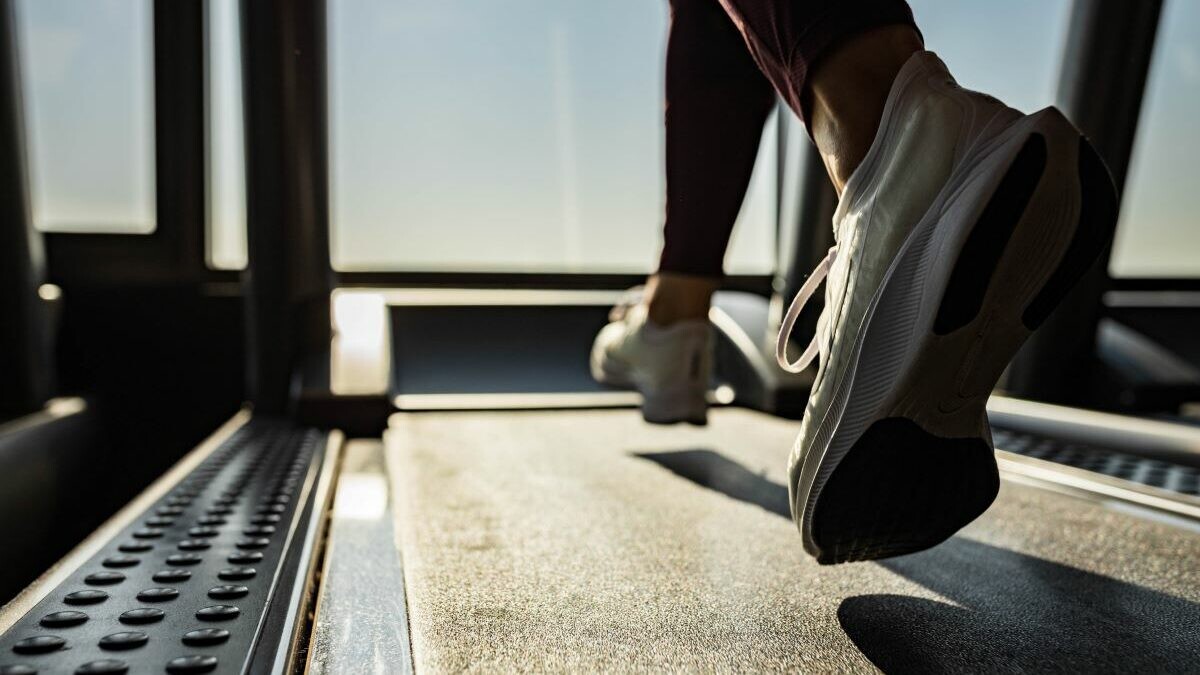
Rain, snow, ice or extreme heat or cold can sometimes make heading outside unpleasant at best and dangerous at worst.
Pros and cons of running on the treadmill
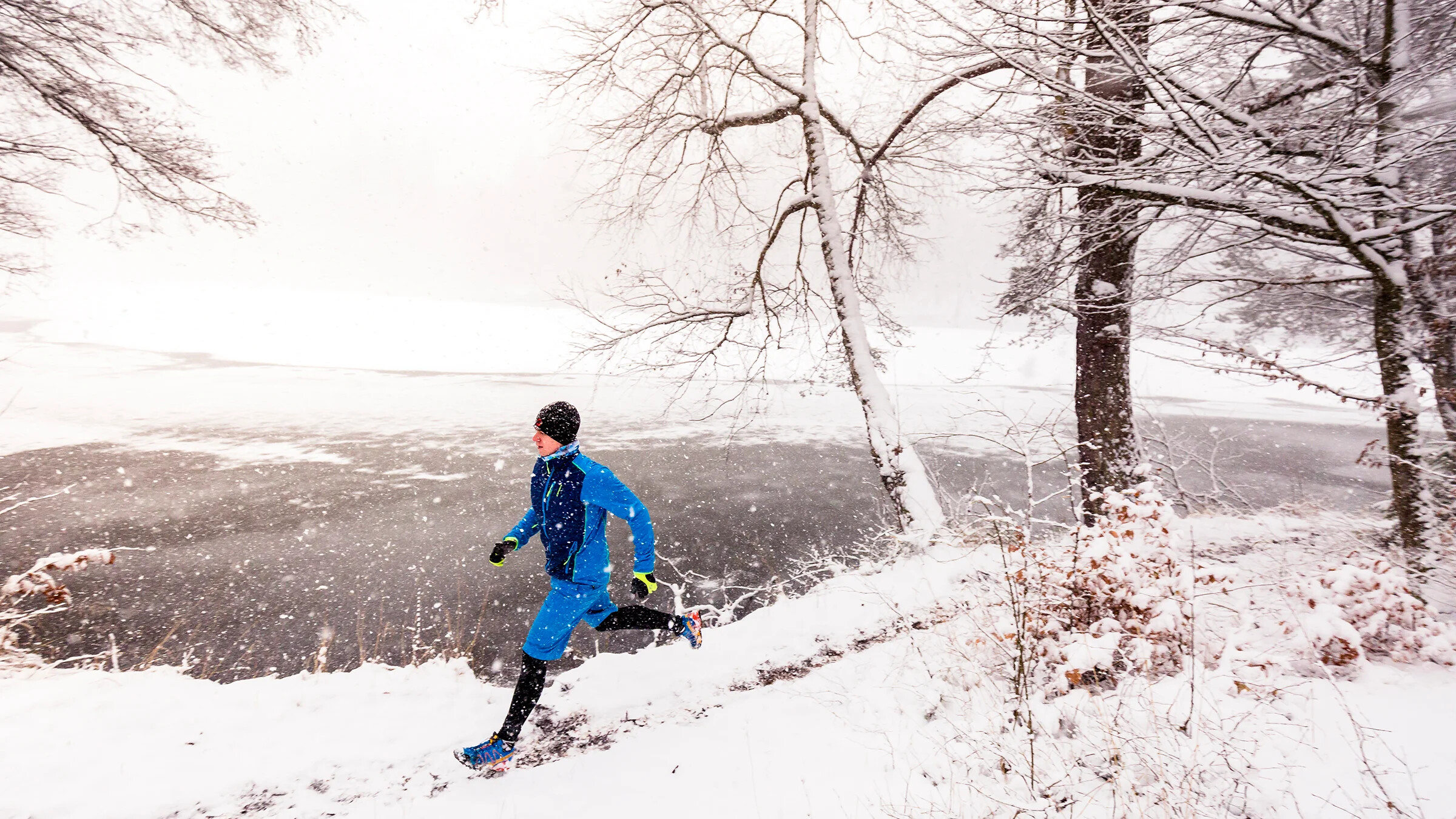
Running on a treadmill offers a controlled environment that eliminates the unpredictable factors of outdoor running. Treadmills allow you to easily customize your workout, adjusting the speed, incline and duration to specific training goals. This controlled setting is particularly useful for those recovering from injuries or seeking a consistent surface to lessen the impact on your joints.
Perhaps the biggest argument against treadmills is that they can be boring. The absence of natural scenery and lack of fresh air may feel monotonous, making it harder to stay motivated to complete your running sessions.
Are there physical differences between outdoor and treadmill running?
Sports science journalist and author Alex Hutchinson of Toronto says that, for the most part, there are no differences in training effects between outdoor running and the treadmill. “There have been a whole bunch of studies analyzing how running on a treadmill is different from running outdoors,” he says. “They do pick up some subtle differences in things like the angle of your knee, but overall these biomechanical differences are pretty negligible.”
The biggest difference between is the lack of air resistance on a treadmill, since you’re not moving forward in space. To counteract this, Hutchinson says runners can set the treadmill incline to 0.5 or 1 per cent, to mimic the effort you’d be putting in outdoors.
“Despite the lack of air resistance, a lot of studies find that treadmill running feels harder when you’re running fast,” he says. “This is probably less to do with physiology than psychology: it’s kind of nerve-wracking to be pushing close to your limits on a fast-moving treadmill, where one false step could send you shooting off the back. That might raise your heart rate a little, but should be less of an issue if you do a lot of treadmill running and get comfortable with the feeling.”
So what’s the verdict?
In the end, declaring one option as definitively better than the other would overlook the unique advantages each brings. Outdoor running stimulates the senses, while treadmill running offers control, convenience and consistency. If you’re training for an outdoor race, you should probably do at least some of your training outside, but both types of running are valuable. Variations in training goals, weather conditions, time constraints and personal preferences should dictate the choice between outdoor or treadmill running.
(01/13/2024) ⚡AMPby Brittany Hambleton
Why Mary Ngugi-Cooper is always eager to return to sentimental Boston Marathon
Mary Ngugi-Cooper has opened up on why the streets of Boston hold a special place in her heart.
Mary Ngugi-Cooper will once again line up for the Boston Marathon scheduled for Monday, April 15.
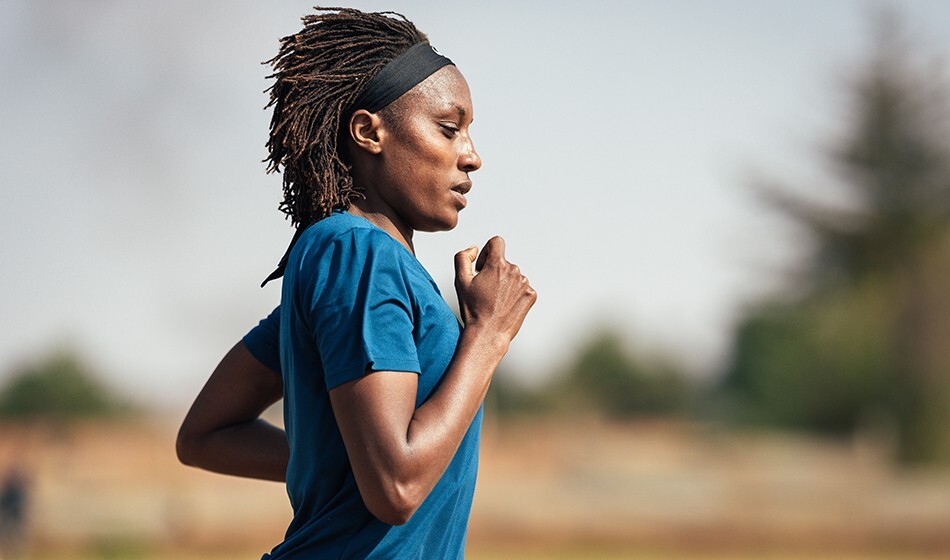
Ngugi expressed her elation upon returning to the streets of Boston which she considers one of her favorite courses, citing various reasons.
Ngugi has made several appearances at the Boston Marathon and has managed to finish among the top ten athletes five times. She was also in action last year, where she managed to finish ninth before ending her season with a fifth-place finish at the New York City Marathon.
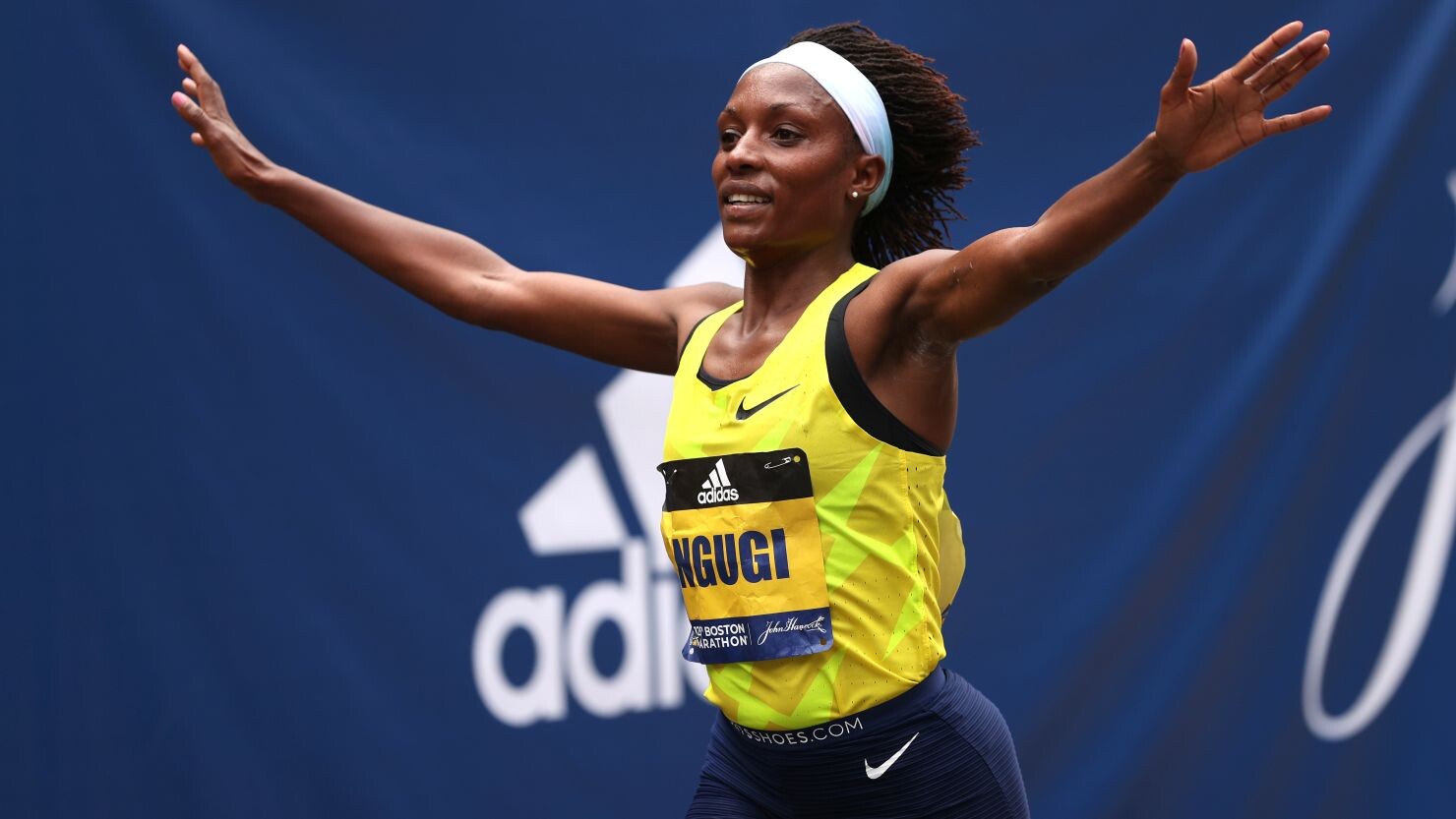
“Back to Boston… I’m really excited to announce that in April I will be running the Boston Marathon. Boston holds a special place in my heart, not only for having two podium finishes in the last few years, but getting married there too!
"The streets are always amazing, crowds loud and I can’t wait to hit Heartbreak Hill once again with a ridiculously strong field of talented women. See you there," she said in a post on her Facebook page.
The Kenyan will be up against some of the greatest female marathon runners including defending champion Hellen Obiri who has already exuded confidence ahead of the assignment.
The Kenyan charge also includes former World Marathon silver medallist Judith Korir, two-time Boston Marathon champion Edna Kiplagat, and the 2022 New York City Marathon champion Sharon Lokedi.
The Kenyans will face an acid test from Ethiopians who have confirmed participation in large numbers. Worknesh Degefa, the 2019 Boston Marathon champion, will make a return and she will enjoy the company of Tadu Teshome who will make her Boston debut.
Hiwot Gebremaryam will be aiming to improve upon her eighth-place finish last year while Senbere Teferi will also be in the mix.
Experienced marathoner Ababel Yeshaneh –second in 2022 and fourth in 2023— will try to become the seventh woman from Ethiopia to win the olive wreath in Boston.
(01/13/2024) ⚡AMPby Abigael Wuafula
Boston Marathon
Among the nation’s oldest athletic clubs, the B.A.A. was established in 1887, and, in 1896, more than half of the U.S. Olympic Team at the first modern games was composed of B.A.A. club members. The Olympic Games provided the inspiration for the first Boston Marathon, which culminated the B.A.A. Games on April 19, 1897. John J. McDermott emerged from a...
more...Country Star "Jelly Roll" Is Training for His First 5K
The country-pop-rap sensation has already dropped close to 200 pounds in the past few years.
Over the past few years, country-pop sensation Jelly Roll has embarked on a weight loss journey to improve his overall health. Now, the singer has announced he is gearing up for the next step by training to run a 5K in the spring.

“Yeah baby, this message is for Bert Kreischer and Tom Segura,” the 39-year-old said in a video posted to Instagram. “I was on the Full Send Podcast this week, and Kyle from the Nelk boys convinced me that I could make it to the 5K by May if I dedicated myself to it,” he said, referring to a challenge put forth by comedians Bert Kreischer and Tom Segura who host the popular 2 Bears, 1 Cave Podcast.
The rapper, whose real name is Jason Bradley DeFord, says in the video that he has been taking daily walks while slowly building up to running the 5K. “Bert, I love you bubba, Tom, I don’t know you but I love you too and can’t wait to meet you. I’ll be there baby, I’m in the woods walking every morning.” the rapper said.
The comedians will be hosting a 5K in May, intending to run it in under 26 minutes. For every minute Tom & Bert go above the 26-minute 5K run time challenge, they will each donate $1,000 to a charity they choose. The race will also feature several other comedians participating, in addition to Jelly Roll.
He closes the video by saying he is committed to the run by May. “5K by May baby, 5K by May. I mean it Bert! I mean it Bert!”
Running a 5K is the next step in his weight loss journey. The CMA winner, who weighed over 500 pounds in 2015, has already dropped over 200 pounds in the past few years, and in a December 2022 interview with Music Mayhem, the singer said he was planning to prioritize his family and his health in 2023.
In November, he told Fox News he had lost around 50 pounds while on tour last year. “I’m drinking less than I’ve ever drank, and I feel incredible. I’m drinking water like a fish. I’m getting it right out here. I want to touch people as long as I can,” he told the news outlet.
In February of last year, he posted an update on his health goals to X. “Just know that I’m doing my part—I’m working out daily … praying and meditating ... Eating better—losing weight,” he said. “Making sure I bring the best version of me on my new album and this tour ... this is what growth and gratitude look like in real-time.”
We look forward to seeing him on the course, and who knows what’s next—maybe he’ll be one of the celebrity runners in next year’s New York City Marathon?
(01/13/2024) ⚡AMPby Runner’s World
It's Not Just You: Exercising After COVID Really Is Harder
Research sheds light on why you may have trouble with endurance once you’re past the virus.
New research points out that COVID can have a physiological affect on the body that makes exercise feel difficult even when you’re over the virus.
Researchers point out the importance of returning to running gradually after COVID.
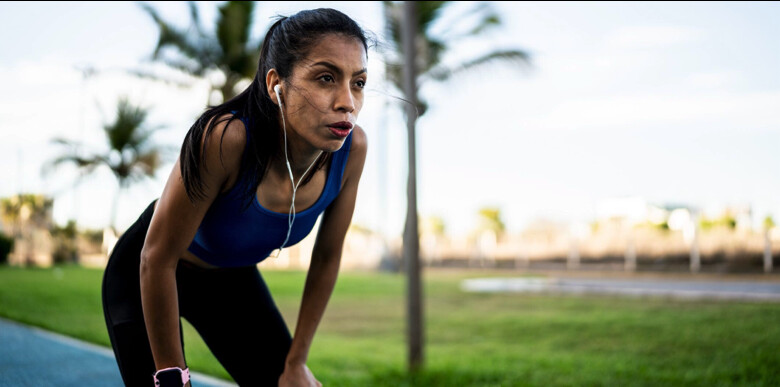
The connection between COVID and reduced exercise capacity has been well established at this point, but researchers still don’t have all the answers on why this happens. But recently, scientists took a step toward more insight: A new study in the journal ERJ Open Research suggests that COVID affects the way oxygen is delivered to the body’s tissues, in a way that may lead to limitations in lung and heart function during activity.
In the study, 55 participants were evaluated for post-COVID exercise intolerance, including 41 who showed no evidence of heart or lung limitations. Yet all had reported reduced exercise capacity since having the virus.
What was particularly notable is that pulmonary and cardiovascular function showed up as normal on standard tests such as CT scans, echocardiograms, and cardio stress tests, said lead author Peter Kahn, M.D., M.P.H., pulmonary and critical care fellow at Yale School of Medicine.
“We found the heart was pumping oxygenated blood and the lungs were providing adequate amounts of oxygen, so these participants showed no evidence of limitations on initial tests,” he told Runner’s World.
It was only when they underwent additional screening through an iCPET—an invasive cardiopulmonary exercise test, where catheters are inserted into the pulmonary artery (which carries blood from the heart to the lungs)—that researchers found deficiencies in the way oxygen was being delivered throughout the body.
“This is helpful, because the prevailing belief has been that exercise intolerance after COVID is tied to deconditioning,” said Kahn. “Our findings contradict that hypothesis and show there’s a clear physiological reason instead.”
These findings are in line with previous research that’s looked at why COVID in particular might affect exercise capacity, rather than just having a virus in general.
For example, a 2022 research review in JAMA Network Open covering nine studies on COVID’s effects found that those who have lingering symptoms after an initial bout of the virus showed faster muscle fatigue compared to those without post-COVID symptoms.
According to first author of that study, Matt Durstenfeld, M.D., cardiologist and clinical researcher at the University of California San Francisco Department of Medicine, the culprit also turned out to be reduced oxygen delivery to the muscles, he told Runner’s World.
Adding to that, participants with reduced exercise capacity had changes in the autonomic system—basically, their “fight or flight” responses don’t reset properly, which can lead to emotional and physical fatigue.
“What we don’t know yet is whether these effects are long-term or even permanent,” he said. “Some studies are showing a minor rate of improvement over time, but others show none, even after a year past the virus.”
That can be disheartening for those trying to get back into an exercise routine, he said, but it doesn’t mean ditching exercise completely. Instead, those with long COVID or who are struggling with recovery from a bout with the virus need to focus on more modest progression, he suggested.
“Pushing yourself harder in the belief that it will help you condition yourself faster can sabotage your progress,” said Durstenfeld. For now, the advice is to build exercise capacity slowly by increasing variables like mileage, frequency, or speed very gradually over a long duration, as your body continues to readjust to life after COVID.
(01/13/2024) ⚡AMPby Runner’s World
Runner wins half-marathon but race officials did not believe him
Last Sunday, one Argentinian runner found himself in some finish line confusion at the 2024 Merida Half Marathon in Merida, Mexico.
Juan Esteban Pizarro had the half-marathon all wrapped up in the final kilometres, surging from third to first overall after the 17-kilometre mark. Little did he know, his glory was about to take an unexpected detour.

As Pizarro ran toward the finishing line, he was ready to break the tape and pose for the win, but a confused race official mistook him for a 10K finisher since the 10K and half marathon races were being run simultaneously. The officials holding the finishing tape hastily closed it, leaving Pizarro without his winning moment.
The officials quickly realized their mistake, but it was too late. They asked the Argentinian to make a U-turn and run back onto the course and through the gantry. Undeterred and probably fueled by the confusion, Pizarro, having just run 21.1 kilometres, walked back onto the course for his second effort at the line. This time, he walked his way in to break the tape.
Luckily, Pizarro had a four-minute lead over the second-place finisher, giving him plenty of time to fix the mix-up, break the tape and get the first-place finish line photo he rightfully deserved.
Despite the finish line confusion, Pizarro was still crowned champion and took home the top prize of $200.
(01/13/2024) ⚡AMPby Running Magazine
Courtney Dauwalter and Jim Walmsley win 2023 Trail Runner of the Year
Trail running media community Freetrail have announced the winners of the Trail Runner of the Year (TROY), and the epic champions weren’t really a surprise: Americans Courtney Dauwalter and Jim Walmsley, both winners of the 2023 edition of UTMB.
TROY is a global award intended to recognize pro athletes within the sport by ranking their performances during the 2023 racing season. “It’s our hope that TROY will become an annual capstone, celebrating the year in competition,” Freetrail said when they created TROY in 2022.
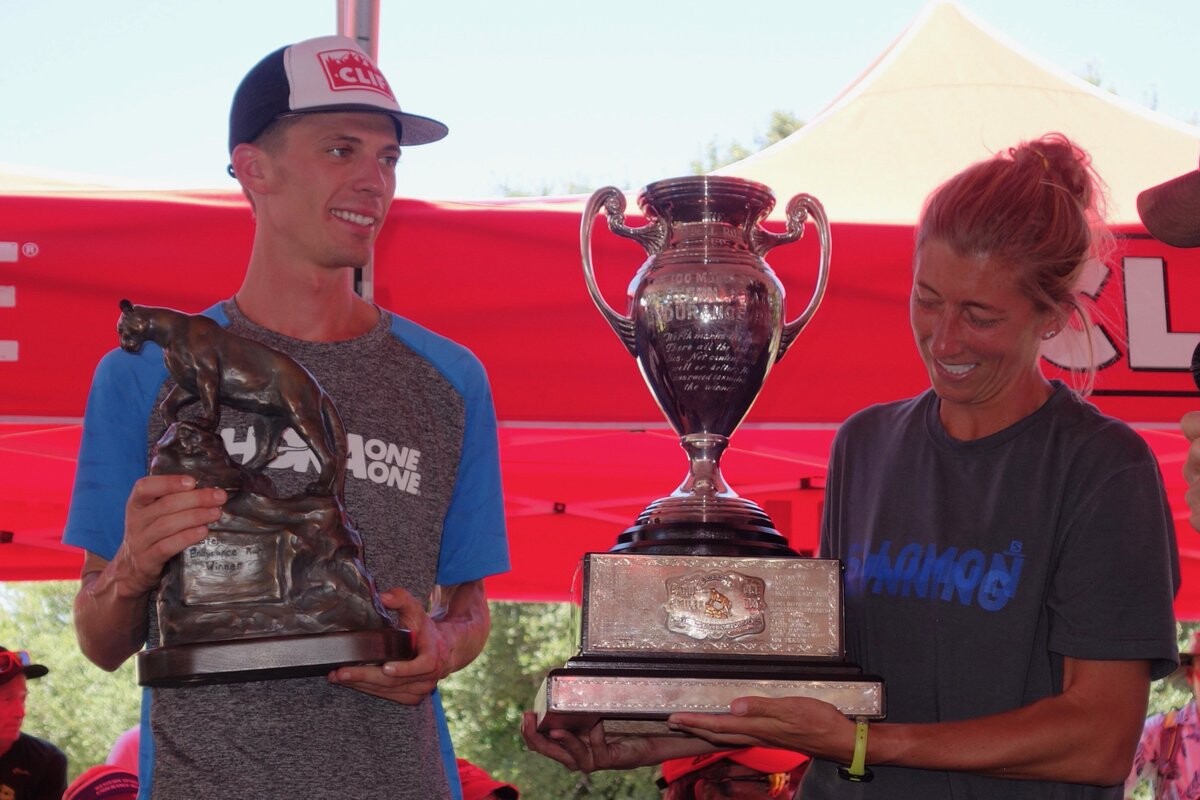
Traditionally, contests like this one have been country-based, so Freetrail is taking a step toward inclusivity by making the competition international. “TROY is an extension of Freetrail’s mission to elevate the profile of the professional athletes in our sport while helping casual observers and the general public feel connected to their stories – hopefully creating diehard fans in the process,” Freetrail shares on its website.
We had some stellar Canadian athletes on the list, including Ailsa MacDonald of Cochrane, Alta., Edmonton’s Priscilla Forgie, Chilliwack’s Ihor Verys and Montreal’s Marianne Hogan. Americans took the lead, however, after remarkable performances in 2023.
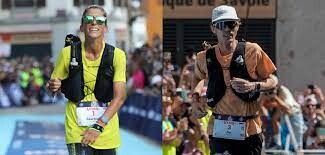
Courtney Dauwalter
Ultrarunner and coach Corinne Malcolm says in the Freetrail announcement that “we are living in the Courtney Era and we aren’t mad about it.” The trail and ultrarunning community witnessed a historic chapter in 2023 as Dauwalter conquered the elusive triple crown of 100-mile races (Western States 100, Hardrock 100 and UTMB 171K) becoming the first person to win all three in one season.
Malcolm captures the essence of Dauwalter’s remarkable journey in 2023 when she says, “We’ve reached peak Courtney.” Before the triple was even an idea, Dauwalter kicked off her season with wins (setting new course records) at Bandera 100K, Transgrancanaria 128K classic, and a record-breaking performance at Western States 100 (WSER).
auwalter’s 2023 season unfolded as an extraordinary narrative of triumphs. Fans watched in awe when she ran to victory at WSER, breaking Canadian Ellie Greenwood‘s long-standing record by 77 minutes, and three weeks later, dominated the Hardrock 100, setting yet another course record.
The unexpected revelation of Dauwalter’s pursuit of the triple crown at UTMB adds a surreal dimension to her already illustrious season. “While she would go on to convincingly win her third world-class 100-mile of the season, completing a triple that will likely never happen ever again, she would also show us she was human, gritting through the final 50 km of the course… Leaving us absolutely speechless in the process,” Malcolm writes.
Jim Walmsley
Walmsley is a beloved fixture in the trail community, known for his immense talent and dedicated work ethic. Fans have followed the evolution of his ultrarunning career. Walsmsley’s journey is one of continuous growth, from three consecutive wins at WSER to a strategic move to Arêches, France, to learn from the likes of Francois D’Haene how to conquer UTMB.
“Just like for many of his mountain colleagues, that would also mean coming into the first spring race of the season off of largely ski fitness,” Malcolm says. “To qualify for the UTMB Finals Jim ran, won, and set the course record at the Istria by UTMB 100-mile race—in the process winning his first 100-mile race that wasn’t WSER.”
While temporarily sidelined with an ankle injury, Walmsley’s determination prevailed as he clinched victory at Trail La Frison Roche and, ultimately, UTMB. Fans watched a nail-biting race, with some doubts as to whether Walmsley would best compatriot Zach Miller, but “a switch flipped at Champex Lac,” and Walmsley secured his win in under 20 hours. Jim’s subsequent triumph at Nice Côte d’Azur by UTMB 100K not only cements his legacy but also earned him a golden ticket to WSER 2024, leaving the ultrarunning community in eager anticipation.
(01/12/2024) ⚡AMPby Keeley Milne
Moh Ahmed withdraws from Houston Half Marathon due to hamstring injury
Moh Ahmed’s debut in the half-marathon will have to wait. He has withdrawn from this Sunday’s Aramco Houston Half Marathon after suffering a hamstring injury in his final tune-up workout.
“I am regretfully withdrawing from the Aramco Houston Half Marathon. In my final tune-up workout on Wednesday, I tweaked my hamstring/hip flexor a bit, such that my coach, Jerry Schumacher, and I felt it would be unwise to line up on Sunday,” said Ahmed in a statement Thursday.
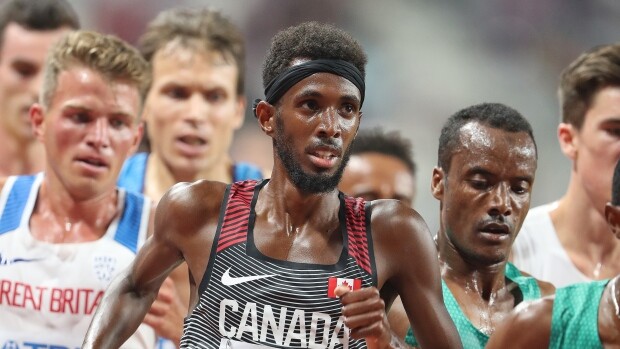
Ahmed’s half-marathon debut was highly anticipated, given his Canadian records in the 5,000m and 10,000m on the track. He is the only Canadian distance runner to have medalled in the men’s 5,000m event at an Olympic Games (Tokyo 2020).
“After a great few months of training, I was really looking forward to testing myself over the streets of Houston against a great field, but it will have to wait until next year,” said Ahmed. Outside of a few local road races and winning the Canadian men’s 10K title last year, he has not raced the 21.1 or 42.2 km distance.

Rory Linkletter will be the lone Canadian athlete in the men’s elite half-marathon field. Linkletter is racing in Houston in preparation for the Sevilla Marathon on Feb. 18, aiming for the Olympic standard of 2:08:10. His personal best of 61:08 was set at this race in 2022 (a Canadian national record at the time). Ljnkletter’s PB is only 50 seconds behind the Canadian half marathon record of 60:18 held by Cam Levins.
Despite Ahmed’s withdrawal, there will still be a large Canadian presence in Houston. Four athletes will be chasing their Olympic dreams in the marathon. Leslie Sexton, 2016 Olympian Lanni Marchant, and Canadian marathon record holder Natasha Wodak will all have their goals on the women’s Olympic standard of 2:26:50, with two spots still open for Paris 2024.
On the men’s side, Tristan Woodfine from Cobden, Ont, returns to the marathon looking to break his personal best of 2:10:51, set three years ago at the London Marathon. The men’s Olympic standard for Paris is 2:08:10.
(01/12/2024) ⚡AMPby Marley Dickinson
Aramco Houston Half Marathon
The Chevron Houston Marathon provides runners with a one-of-a-kind experience in the vibrant and dynamic setting of America's fourth-largest city. Renowned for its fast, flat, and scenic single-loop course, the race has earned accolades as the "fastest winter marathon" and the "second fastest marathon overall," according to the Ultimate Guide to Marathons. It’s a perfect opportunity for both elite athletes...
more...Hellen Obiri faces tough field in Boston Marathon title defence
Hellen Obiri will defend her Boston Marathon title on April 15 in what the organizers say is the strongest elite women's field in the history of the race.
However, Obiri faces a Herculean task in a race where 19 athletes have personal bests under 2:23:00 including Olympians, World Marathon Majors winners and national stars.
Obiri, a two-time Olympic 5000m silver medalist — now living in Colorado, USA — won the 2023 edition thanks to a perfectly-timed sprint in the final kilometer.

Obiri who has been named in Kenya’s marathon team for Paris Olympics is also the New York City Marathon champion.
“I am excited to return to the 2024 Boston Marathon to try to defend my title,” said Obiri, who finished last year’s race in 2:21:38.
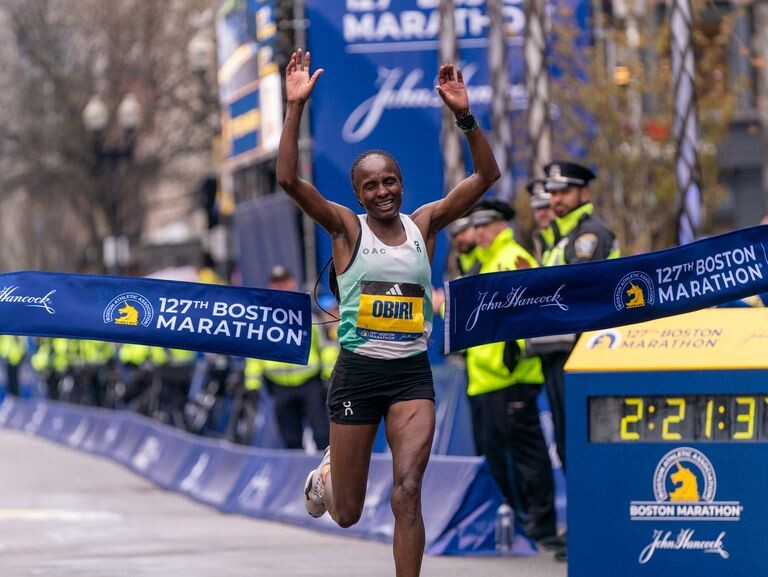
“Boston is an historic race and I would like to add my name further to its history on April 15. Winning such a historic marathon with my family waiting at the finish line was an amazing experience.”
A trifecta of Ethiopians with lifetime bests under 2:18:00 will take to the Boston course.
Worknesh Degefa, the 2019 Boston Marathon champion, returns, while 2:17:36 marathoner Tadu Teshome will make her Boston debut. Hiwot Gebremaryam aims to improve on her eighth-place finish last year.
World championships medallist Senbere Teferi who won the 2022 B.A.A. 5K in a course record of 14:49 is also in the mix.
Experienced marathoner Ababel Yeshaneh –second in 2022 and fourth in 2023— will try to become the seventh woman from Ethiopia to win the olive wreath in Boston.
Joining Obiri from Kenya are 2022 World Athletics Championships Marathon silver medalist Judith Korir, two-time Boston Marathon winner Edna Kiplagat, four-time top-ten finisher Mary Ngugi-Cooper and 2022 New York City Marathon champion Sharon Lokedi.
Helah Kiprop, who holds a silver medal in the marathon from the 2015 World Athletics Championships and has earned wins in Tokyo, Copenhagen and Paris, makes her second career Boston start. From Morocco is 2023 world marathon bronze medalist Fatima Gardadi.
Desiree Linden leads the American contingent six years after winning the title. Linden has finished in the top-five five times and holds the third-fastest time by an American ever on the Hopkinton-to-Boston route (2:22:38).
Linden will run her fifth U.S. Olympic Marathon Trials in February. Joining her is Emma Bates, who finished fifth last year in the second-fastest time ever by an American woman at Boston (2:22:10).
“At this point in my career it’s an easy decision to return to the Boston Marathon and make it my top priority race of the spring,” said Linden.
“I can’t wait to take on the iconic course for an 11th time and have the opportunity to mix it up with some of the best runners in the world.”
Jack Fleming, President and CEO of the Boston Athletic Association said: “The Boston Marathon is proud to showcase the world’s best athletes year in and year out on Patriots’ Day.”
“This year’s women’s field is exceptionally fast and showcases many who’ve been podium finishers on the global stage. It’ll make for an exciting race from Hopkinton to Boston, and we look forward to crowning our champions on April 15,” he added.
(01/12/2024) ⚡AMPby Angwenyi Gichana
Boston Marathon
Among the nation’s oldest athletic clubs, the B.A.A. was established in 1887, and, in 1896, more than half of the U.S. Olympic Team at the first modern games was composed of B.A.A. club members. The Olympic Games provided the inspiration for the first Boston Marathon, which culminated the B.A.A. Games on April 19, 1897. John J. McDermott emerged from a...
more...Betsy Saina explains what it will mean to represent USA at Paris Olympics
Kenyan-born American marathoner Betsy Saina has revealed what is motivating her to represent USA at the Paris Olympics after ditching her motherland in 2021.
Kenyan-born American marathoner Betsy Saina believes she is representing her whole family by running for the United States.
Saina switched allegiance from Kenya to the US in 2021, having represented her country of birth in 10,000m at the 2016 Rio Olympics before later moving to the marathon.
The 35-year-old is gearing up for her first Olympics trials with Team USA set to be held in Orlando, Florida and she has explained what it would mean to don the American colours at the Paris 2024 Olympics.
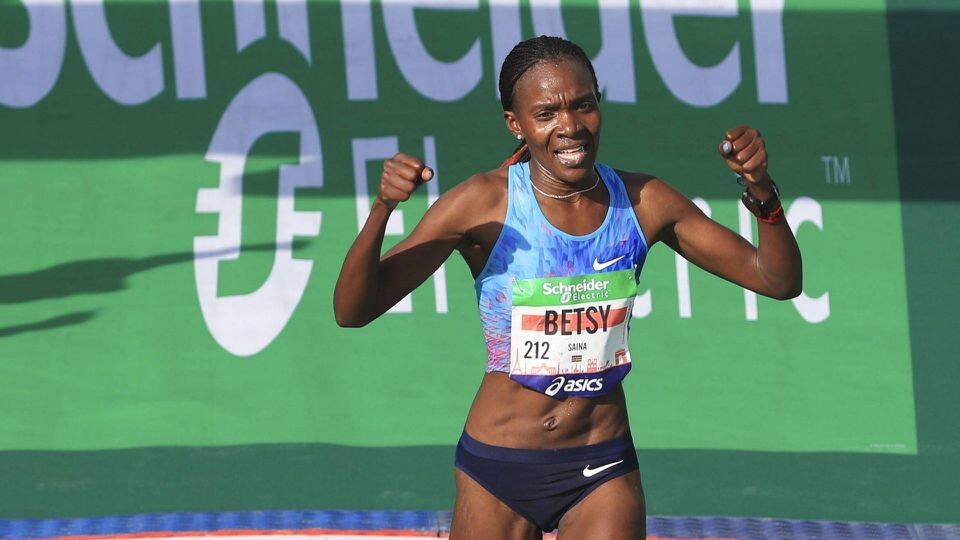
“I'm really excited. Like I said, things have changed a lot,” Saina told CITIUS Magazine.
“The U.S. has become my home because it's been over ten years since I moved there. That makes me feel really emotional. My heart is full.
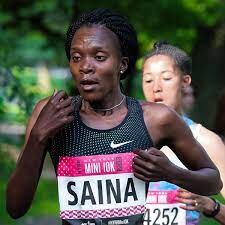
“I'm so grateful to be able to represent the U.S., after all I've gained in living there: to my two sisters living there, my son being born in the U.S. – it's a family thing for me. So I'm running for the whole family now.”
Saina moved to the US when she joined Iowa State University in Ames, Iowa, later earning an agriculture and life sciences degree with a focus on nursing.
She has continued to shuttle between the US and Kenya, mostly training back home, including now as she prepares for the 2024 Olympics, alongside her long-time friend Joyciline Jepkosgei.
Saina admits it is much easier to train with Kenyan runners now knowing that she will not be competing with them for a ticket.
“I went to high school at the same time as her (Jepkosgei), so I knew her from back in 2005,” she added of her friend and training partner.
“When I made the decision [to switch allegiance] I really wanted to train with her because we have had a long-time friendship. But I was a little bit like, ‘oh my gosh, she's run 64!’
“But I looked at myself and I was like, ‘I need to challenge myself every day.’ When you're running with someone who is better than you, it's a privilege.
“I remember when I was training for Sydney and we were doing the same workouts, and my coach could use the time [difference between us] like, ‘hey, for this long run you still have like one or two minutes, you know, that you need to improve on.’ And I remember when I started maybe it was like four minutes and then by the time I was going for the race, I was closing down to like a minute."
Saina says unlike other runners, she enjoys training with Jepkosgei as she does not see her as a rival which makes things easier.
“It's been a big challenge, in a good way,” said Saina. “She's been helping me so much for the last month. She's not super competitive in training. Like, I know some people, when you're training with them, they can start saying, no, I don't want her to be close to me.”
“But for Joyciline, she really wants me, you know, to be on the same caliber with her, especially knowing that she's not in the same team with me. I love training with her. And when I come back from the Trials, I'll be able to keep training with her, whatever happens,” added the Sydney Marathon champion.
(01/12/2024) ⚡AMPby Joel Omotto
Paris 2024 Olympic Games
For this historic event, the City of Light is thinking big! Visitors will be able to watch events at top sporting venues in Paris and the Paris region, as well as at emblematic monuments in the capital visited by several millions of tourists each year. The promise of exceptional moments to experience in an exceptional setting! A great way to...
more...The 2025 World Masters Athletics Indoor Championships is coming to the US
World Masters Athletics, together with Alachua County Florida and USA Track & Field (USATF), announce the 10thWorld Masters Athletics Indoor Championships will be held in Gainesville, Florida.
This Championship, set to be held from March 23-30, 2025, promises to be another great experience for Masters Athletes and attendees. It might be the most convenient WMA Championship ever with 2,000 hotel rooms within 2km, shuttles to venues and much more. Message from Margit Jungmann, WMA President: “WMA Council thanks Alachua County, Gainesville Sports Commission and RADD Sports for hosting our 2025 Indoor Championships.
We are confident their team is exceptionally qualified and capable of organizing a World Championship as they support over seventy sporting events annually. It will be special having outdoor events in warmer average temperatures than previous Championships and returning to North America.” Message from Commissioner Mary Alford, Chair of the Alachua County Board of County Commissioners: “My fellow commissioners and I thank the WMA Council and its member federations for giving us the opportunity to host this amazing international event.
It is exciting to welcome the world to Alachua County in 2025! We will provide a wonderful experience for all our regional, national, and international visitors. Alachua County's experience hosting major events, our world-class facilities and amenities, rich sports history, and cultural, natural, and entertainment offerings, make it the ideal location for the World Masters Indoor Championships.” Message from Max Siegel, CEO of USATF: “On behalf of USA Track & Field, I am delighted to extend our heartfelt congratulations to Alachua County and the Gainesville Sports Commission on securing the honor of hosting the 2025 World Masters Athletics Indoor Championships, making its inaugural debut in the United States.
This historic achievement speaks volumes about Gainesville’s commitment to fostering athletic excellence on a global stage, and we look forward to an extraordinary Championship showcasing the pinnacle of Masters athletics that will inspire athletes and spectators alike.”
(01/12/2024) ⚡AMPJacob Kiplimo will be heading the 10K Valencia Ibercaja on Sunday
Jacob Kiplimo will be heading to the 10K Valencia Ibercaja on Sunday with an attempt to break Rhonex Kipruto's world record that he set on the same course.
As Uganda’s Jacob Kiplimo heads to the 10K Valencia Ibercaja on Sunday, January 14, all eyes will be on him to obliterate Rhonex Kipruto’s world record time over the distance.
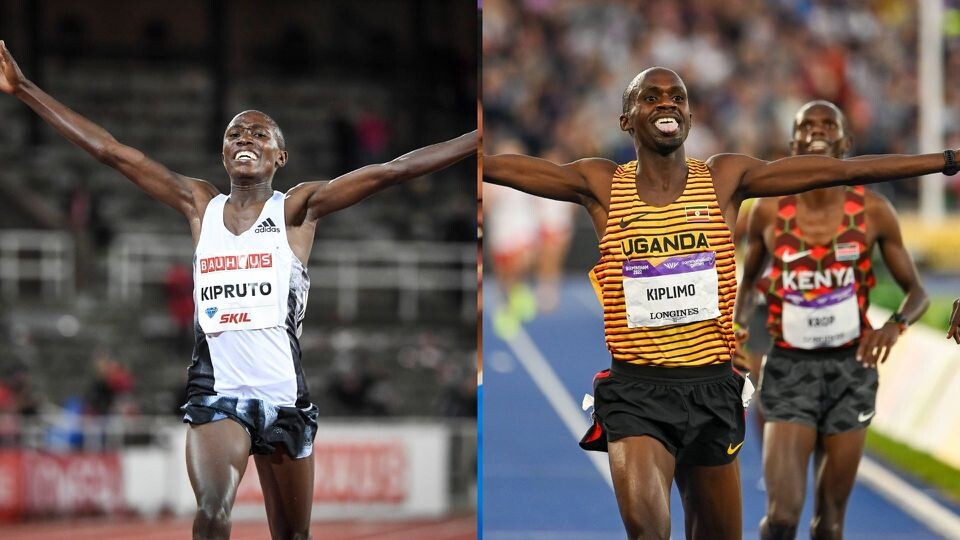
The Ugandan, just 23 years of age, has proven to be in impeccable form and he will be angling to destroy the Kenyan's world record over the distance. Kipruto set the world record back in 2020 on the same course, clocking 26:24 to win the race.
The courses in Valencia are usually known to be fast and produce great times and 2024 will be no different since the quality of the field attracted comprises Olympians and World Championships medalists.
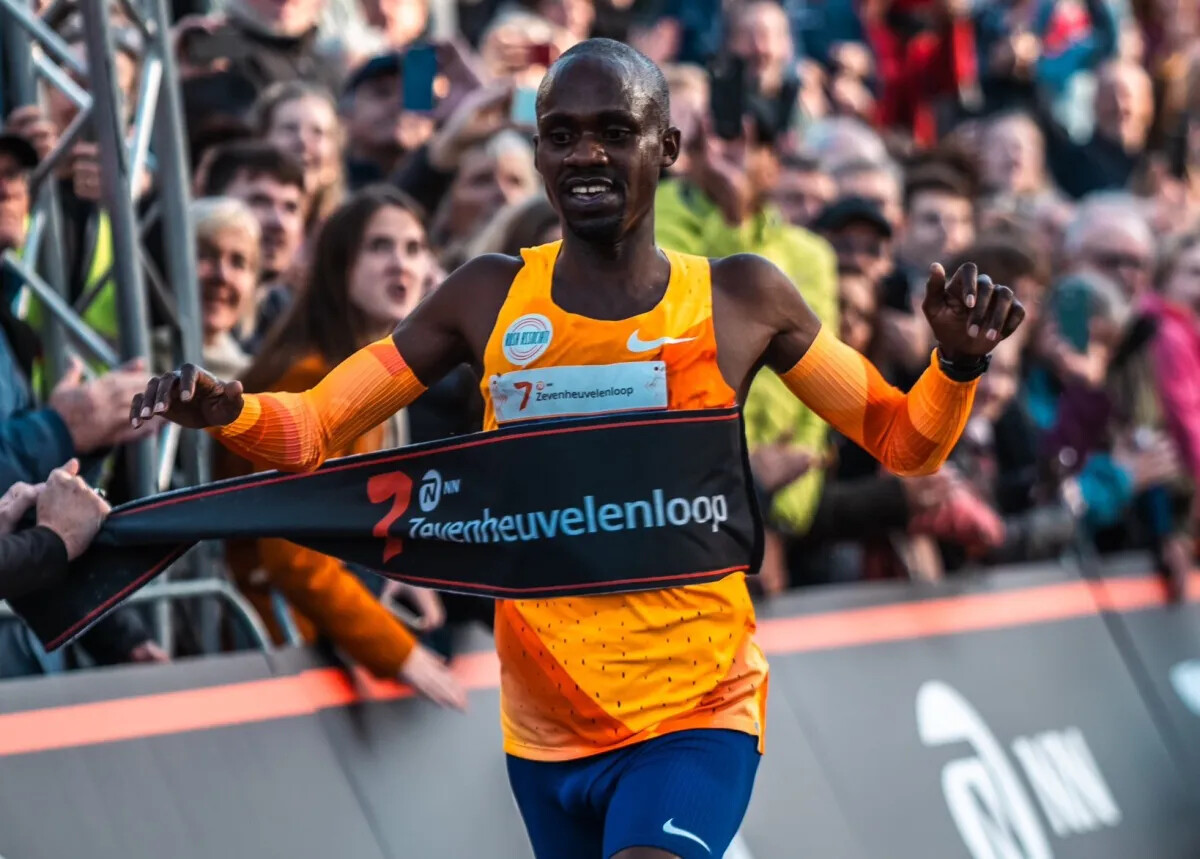
Less than two months ago Kiplimo equaled the 15km world record in the Netherlands (41:05) after coming back from injury.
He also holds the half marathon record after his dominant display at the Lisbon Half Marathon where he cut the tape in 57:31. Kiplimo has already proven to be in the form of his life and if the weather and all conditions are right, he will surely dip under Kipruto’s world record time.
Meanwhile, the men’s race has also attracted national 10K record holders like Rodrigue Kwizera (Burundi), Pietro Riva (Italy), and Richard Douma (Netherlands).
Additionally, Dominic Lobalu, a refugee athlete from South Sudan now naturalized Swiss, who tied the European 5K Record, will also be a competitor to watch.
Spanish elite athletes include Abdessamad Oukhelfen in men's and Águeda Marqués and Cristina Ruiz in women's, all arriving in excellent shape and with ambitious goals.
(01/12/2024) ⚡AMPby Abigael Wuafula
10k Valencia Trinidad Alfonso
Around the corner we have one more edition of the 10K Valencia Ibercaja, organized one more year by the C. 10K VALENCIA Athletics premiering the running season in Valencia. It is a massive urban race with more than 3,000 registered annually of 10 kilometers, where the maximum duration of the test will be 1 hour 40 minutes (100 minutes). The...
more...Malaga Half Marathon judged third best in Spain by World Athletics
Malaga's Half Marathon has experienced some remarkable growth in recent times. Last October witnessed one of its most successful editions, shattering records in both categories and boasting significant participation numbers, with over 4,000 athletes donning their race numbers to take part.
However, the accolades don't end there. World Athletics, the foremost athletics organization globally, has now compiled a ranking assessing the quality of Spain's half marathons. In it, Malaga has secured third spot with an impressive score of 9,461.
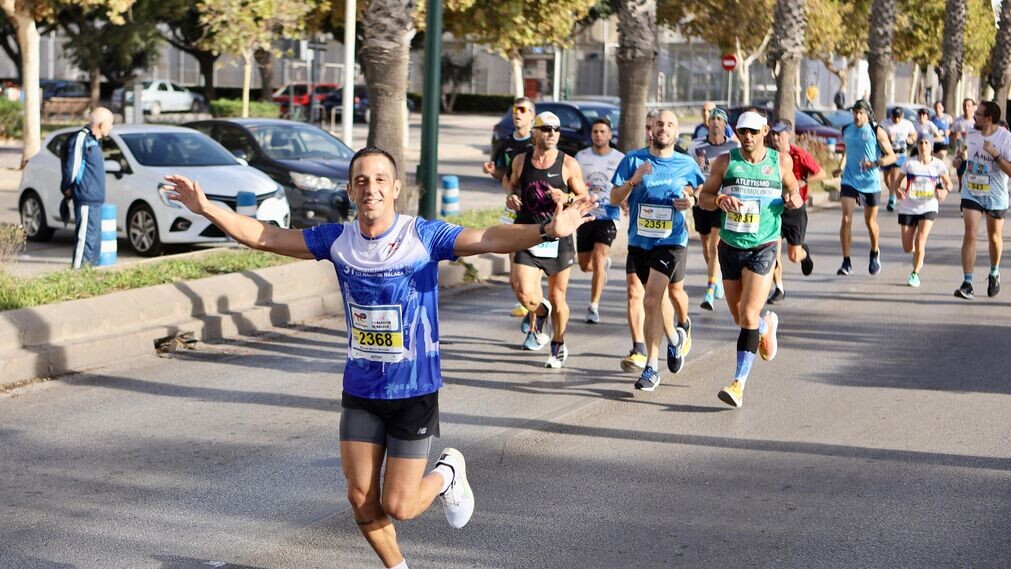
It falls just behind Valencia (awarded 10,853 points) and Barcelona (with 10,076 points). Seville, in seventh with a score of 9,176, is the only other Andalusian city that comes close.
Unique characteristics
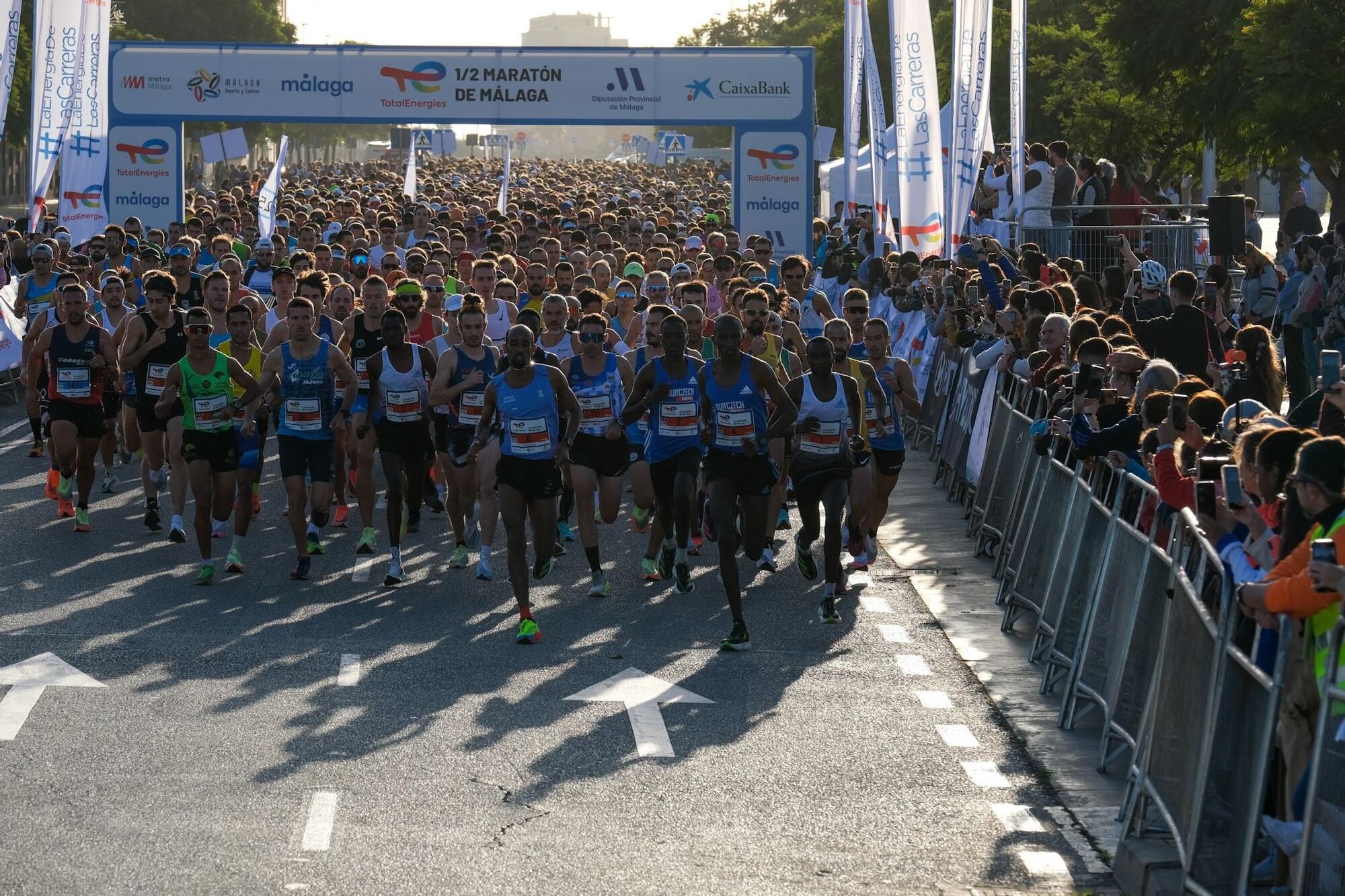
The reason for such a high ranking are the unique characteristics that set it apart. It holds the distinction of being the half marathon with the fewest curves across the entire continent, featuring just seven bends.
What's more, the records set in the latest edition by Kenyan runner Geoffrey Toroitich (59:13) and compatriot Caroline Nyaguthii (1h 07:36) position the Malaga Half Marathon among the top five fastest in the country and within the twenty fastest in Europe.
New date
As a result, all signs point to the event breaking its registration record in the upcoming 2024 edition, slated for 10 March.
This year, the event reverts to its original date, in the early months of the year, meaning that there are just over two months left until it takes place.
So far, registrations have already surpassed 3,000 participants, indicating a promising turnout.
(01/11/2024) ⚡AMPby Nacho Carmona
Malaga Half Marathon
TheTotalEnergies Málaga Half Marathonis one of Europe’s premier road racing events, held annually in the sun-drenched coastal city ofMálaga, Spain. Known for its lightning-fast course and ideal racing conditions, this half marathon attracts elite athletes and recreational runners from around the world. Set along the scenicCosta del Sol, the route is celebrated for itsultra-flat profile, featuring just a7-meter elevation...
more...Emma Bates Withdraws from Olympic Marathon Trials 2024
Emma Bates was widely considered a top contender to make the U.S. Olympic team in the marathon this year. But over the weekend, she announced she won’t be lining up at the Olympic Marathon Trials in Orlando, Florida, on February 3.
Bates, 31, tore her plantar fascia during October’s Chicago Marathon. On December 12, she posted that she had been healing well and was back to running on the ground for an hour at a time when she developed another injury, posterior tibial tendonitis.
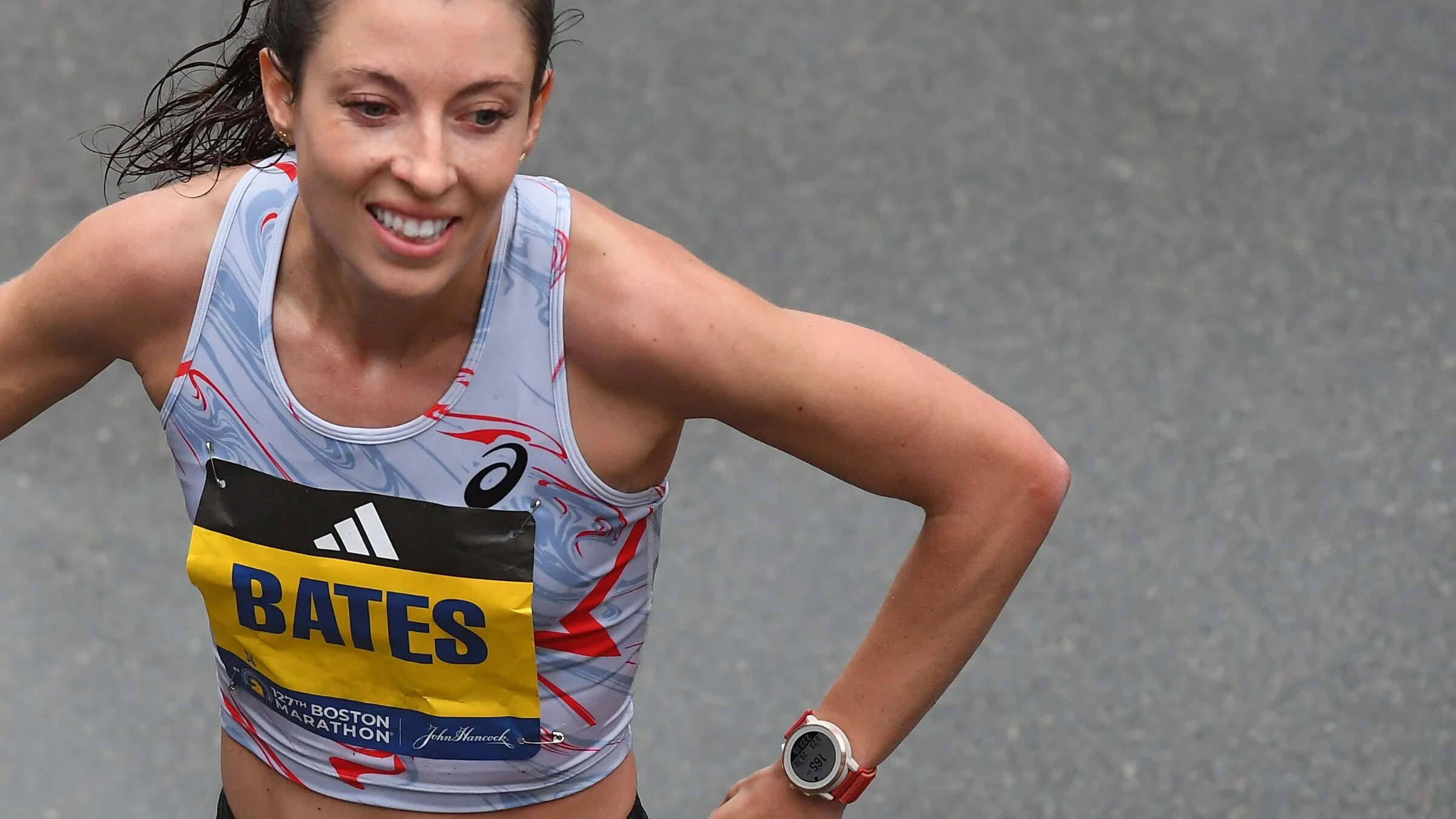
And in a tearful Instagram video posted Saturday night, Bates said that while she had returned to workouts with her Boulder-based training group, Team Boss, “we just know that there’s not enough time to be where I need to be.”
Bates’ personal best of 2:22:10 at the 2023 Boston Marathon, where she placed fifth, was the third-fastest time by an American last year.
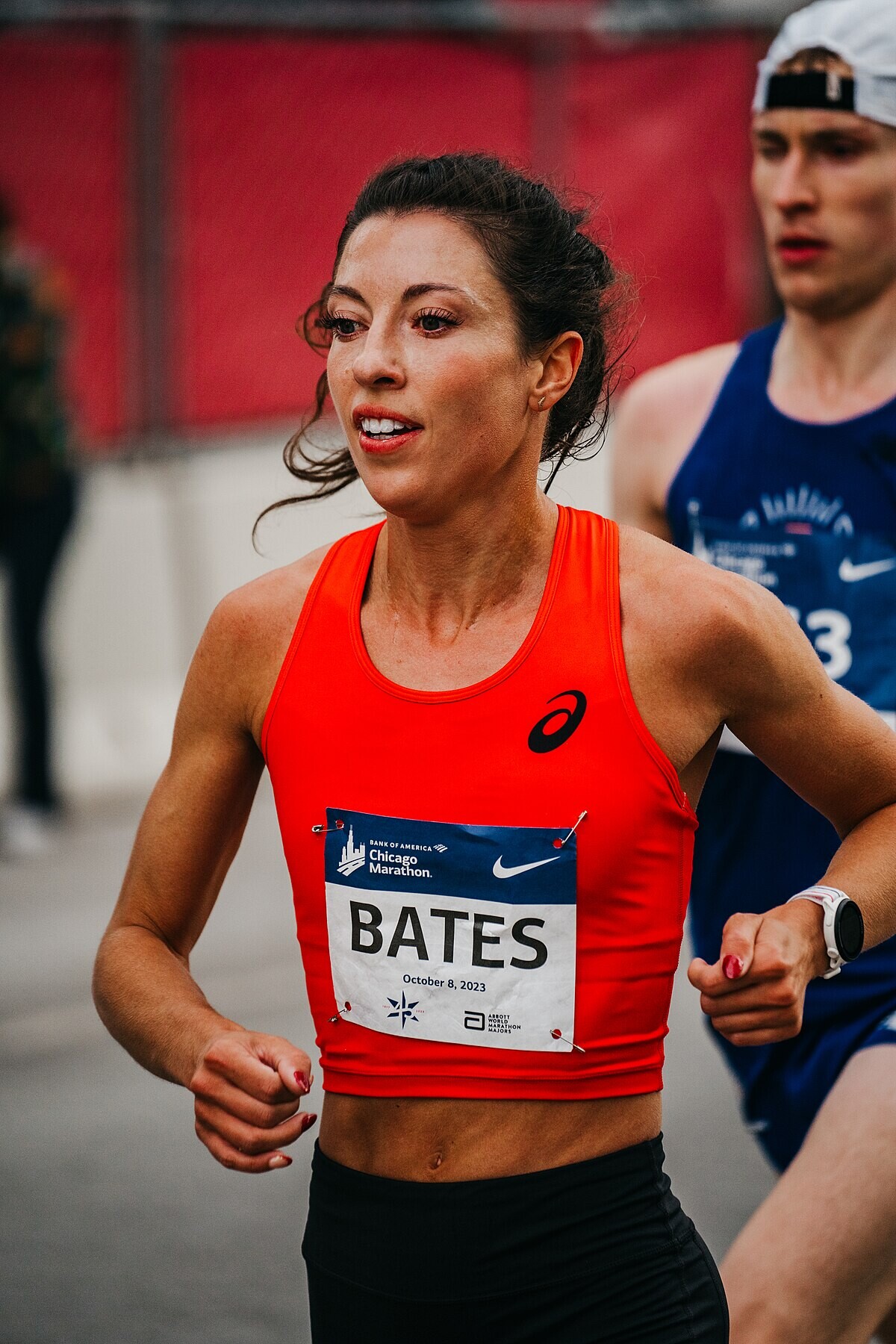
She headed into Chicago in the fall with high hopes—saying she was in shape to run 2:18 to 2:19 pace—but stepped in a pothole around mile 14. She finished 13th in 2:25:04 and left the finish line in a wheelchair. A week after the race, an MRI revealed a torn plantar fascia.
She put on a boot and began cross-training on the bike, knowing the buildup to the Trials wouldn’t be easy. With the new setback last month, she and coach Joe Bosshard decided it simply wouldn’t be possible.
Bates, a 2014 NCAA champion in the 10,000 meters at Boise State University, won her marathon debut and the USATF Marathon Championships with a 2:28:18 at the 2018 California International Marathon and has steadily improved since. In her second marathon, the 2019 Chicago Marathon, she finished fourth in 2:25:27.
Those performances made her a contender for the 2020 Olympic Marathon Trials, where she ran 2:29:35 to place seventh. But her next big breakthrough was around the corner. On a hot, humid day at the 2021 Chicago Marathon, she ran a personal-best 2:24:20 to place second.
And in 2022, she was part of a trio of Americans who produced top-10 finishes at the World Athletics Championships in Eugene, Oregon—she was seventh in 2:23:18, between Sara Hall (fifth in 2:22:10) and Keira D’Amato (eighth in 2:23:34).
Bates was clearly disappointed not to line up with the likes of Hall and D’Amato again in Orlando; “this one hurts a lot,” she wrote.
“It’s another four years to wait for another Olympic team,” she said in the accompanying video. “I’ll be OK. I’ll be OK.”
(01/11/2024) ⚡AMPby Cindy Kuzma
2028 US Olympic Trials Marathon
Most countries around the world use a selection committee to choose their Olympic Team Members, but not the USA. Prior to 1968, a series of races were used to select the USA Olympic Marathon team, but beginning in 1968 the format was changed to a single race on a single day with the top three finishers selected to be part...
more...Four things runners should stop worrying about
There’s a lot of weird pressure in the running world to do certain arbitrary things, like log massive amounts of weekly mileage, run fascinating routes and document (or not document) all of it, update your watch every few months—the list is endless.
If you’ve ever felt slightly “less than” as you discussed your passion for creating artsy routes on Strava with someone who has decided to delete the app and “feels freer than ever,” you know the feeling. Maybe you love poring over the splits in your last hard workout, maybe you don’t worry about pace at all—either way, you’re an awesome runner. Here are five running “rules” to stop worrying about this year.
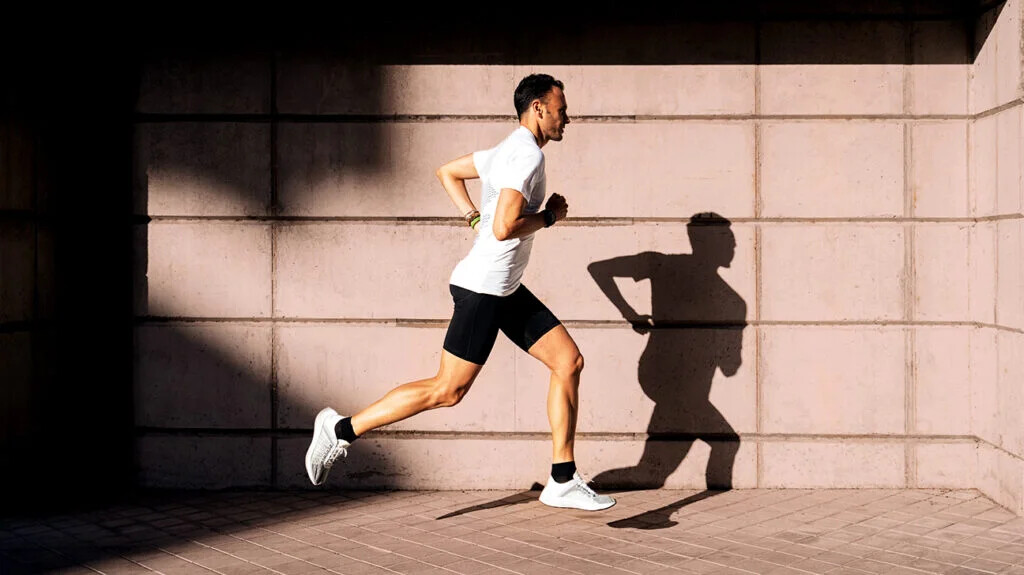
1.- It’s OK to love data (or hate it!)
Whether you’re hooked on wearable tech, subscribed to multiple running apps and geek out over data or you’re rocking a decade-old GPS watch with no idea what KOM means—it doesn’t matter. Embrace your running style, and ignore anyone who tries to make you change teams.

If you’re on the tech-friendly team, you probably gain valuable insight from perusing Strava, and if you’re the back-to-basics type, you never have to stress if you forget to charge your watch or have your Local Legend title stolen. Data lover or tech minimalist, the choice is yours, and there’s plenty we can all learn from each other.
2.- Run wherever you want
When my kids were teenagers, I got in the habit of never running too far from home. They often needed something, and I wanted to be able to help them out without a lot of stress and logistics. Now that they’re out of the house, I still gravitate to those same, loopy routes near my house. Hey, I’m close to snacks, a washroom and extra mittens.
Recently though, a fellow runner questioned my running routes on Strava.”Why do you always stay so close to home? There are trails all over the entire city,” he said. I felt bad about my chosen routes for a few minutes, and then I realized: it’s OK to run wherever you want. Whether it’s loops around your block or an epic FKT adventure across town—your run, your rules. Forget the naysayers—be proud of your chosen paths, be they familiar loops or exploring every nook and cranny of the city. There’s no wrong way to enjoy the run.
3.- Run whenever you want
For years, I desperately wanted to be an early-morning runner. Whenever I managed to get out the door at the crack of dawn, I would gloat about it all day. If you’re like me: stop that. Morning, noon or night—pick your run time and own it. No more feeling superior for being an early bird or guilty for not fitting into the “ideal” time slot.
Whether it’s a lunchtime jog or a midnight run, celebrate moving your body whenever it feels right for you. Run on your clock, not anyone else’s.
4.- Walk like a runner, talk like a runner
New runners, listen up: walking is not the enemy! Forget the pressure to ditch walk breaks. Whether it’s long strolls, quick breathers, or a mix of both—you’re still a runner. Brendan Leonard, author of I Hate Running and You Can Too, nails it: “Allowing yourself to walk makes running less daunting, less restrictive, less all-or-nothing. There are no rules, and no one’s keeping track but you, so figure out what works and use it to log some miles.”
(01/11/2024) ⚡AMPby Keeley Milne
Kandie is ready to fight off competition to make Kenya's team to Paris
With the Valencia Half Marathon title safely tucked away in the bag, Kenyan course sensation Kibiwott Kandie now has his sights firmly trained on the Paris 2024 Olympics.
In an interview on Wednesday, Kandie vowed to burn the midnight oil until he cracks a spot on the Kenyan marathon team for the Paris 2024 Olympics.
Although his last race at the Valencia Marathon on December 4 saw him fizzle out to a disappointing sixth after clocking 2:04:48, Kandie said he is ready to rise from the ashes of the heart-wrenching debacle to curve a niche for himself in the Olympic Hall of Fame.
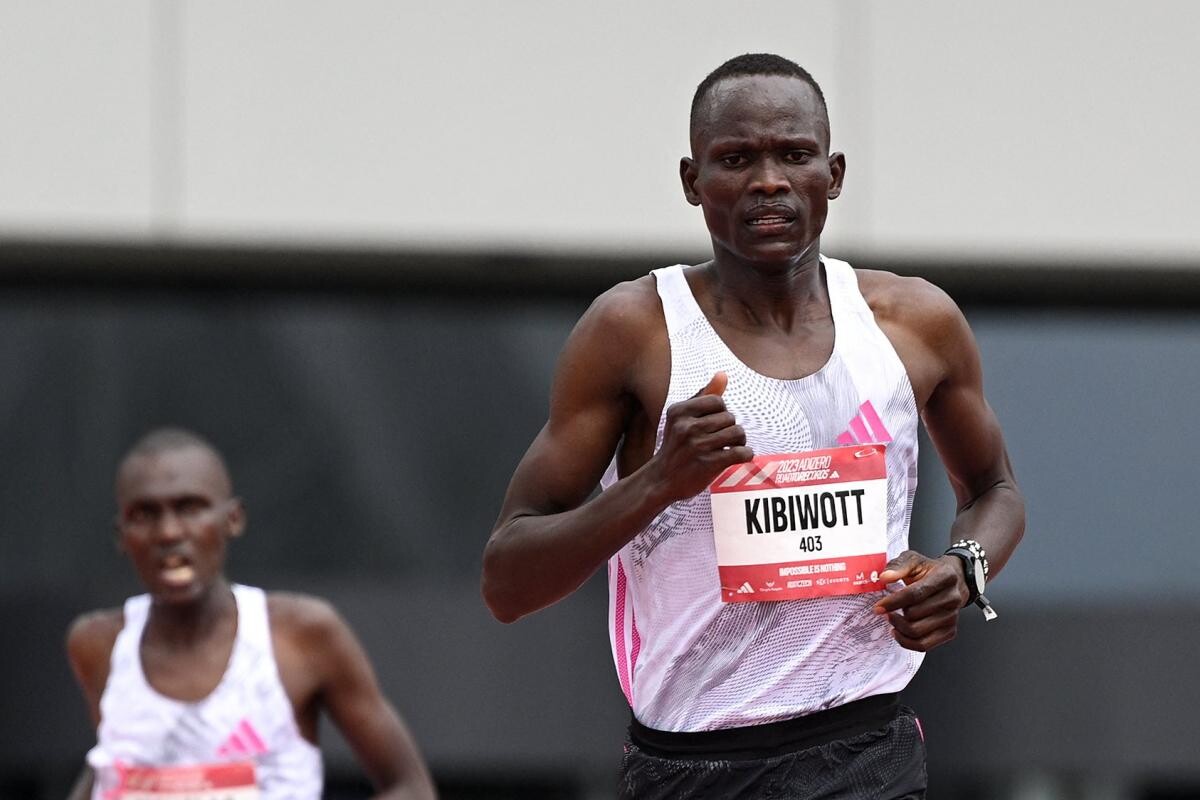
“All my focus is on the Paris Olympic Games and I’m ready to give my best shot in marathon. The marathon has never been my specialty but I believe I have gathered adequate experience from the half marathon that will help me navigate the new waters effectively,” Kandie remarked.
“I have now decided to graduate to the marathon and I hope to seal a slot in the Kenyan team that will be participating in next year’s Olympics in Paris. I will be aiming for a podium finish with clinching the gold medal as my main goal,” he added.
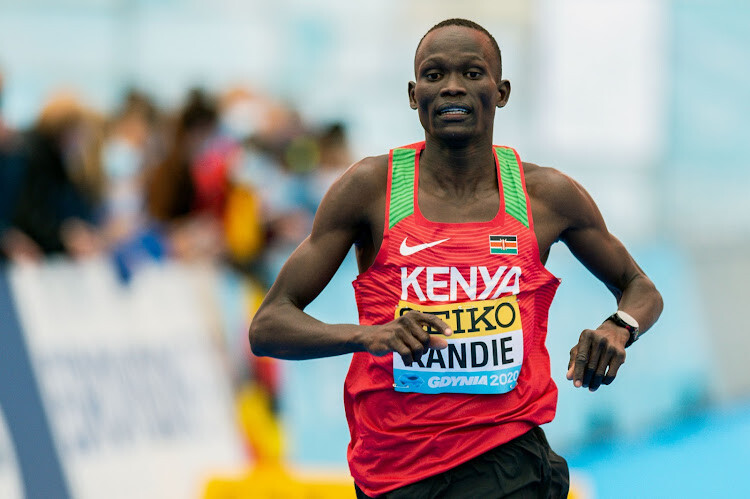
Indeed, Kandie is likely to face formidable competition in the race for a Kenyan ticket, including multiple Berlin Marathon champion Eliud Kipchoge.
“I’m aware securing a place on the Kenyan team to Paris won’t be a walk in the park. We have some great Kenyan marathoners who are also eyeing the ticket. It’s all about competition and I’m ready to put my best foot forward,” Kandie stated.
If he manages to punch a ticket on the plane to the French capital, Kandie hopes to replicate his performance at the Valencia Half Marathon on October 22, where he obliterated a rich field of competitors to defend his title.
The 2023 Valencia Half Marathon feat was the third major decoration in his glittering career, having previously sauntered to victory in 2020 and 2022.
The Valencia race recorded the fastest half marathon of 2023, with three runners locked in a photo finish.
Kandie breezed to triumph in an impressive 57:40, ahead of Yomif Kejelcha who wrapped up second in a time of 57:41, followed closely by Hagost Gebrhiwet, also at 57:41.
Kandie’s time not only made it the fastest of 2023 but also ranked as the fourth-fastest in the history of the event.
Nevertheless, his performance, albeit sterling, was nowhere near the master class act he exhibited at the 2020 Elite Edition of the Valencia Half Marathon, where he set a new world record time of 57:32. In 2021, he set a course record at the Istanbul Half Marathon and won The Giants Geneva 10k.
(01/11/2024) ⚡AMPby Tony Mballa
Paris 2024 Olympic Games
For this historic event, the City of Light is thinking big! Visitors will be able to watch events at top sporting venues in Paris and the Paris region, as well as at emblematic monuments in the capital visited by several millions of tourists each year. The promise of exceptional moments to experience in an exceptional setting! A great way to...
more...Strongest Women’s Field in the race history at Boston Marathon 2024
The 128th Boston Marathon presented by Bank of America will feature the strongest women’s field in race history, led by defending champions Hellen Obiri and Susannah Scaroni. A total of 19 women with personal bests under 2:23:00 will line up in Hopkinton aiming to earn the Open Division crown, including Olympians, Abbott World Marathon Majors winners, and national stars. In the Wheelchair and Para Athletics Divisions, Paralympic hopefuls from around the world are set to compete.
“The Boston Marathon is proud to showcase the world’s best athletes year in and year out on Patriots’ Day,” said Jack Fleming, President and CEO of the Boston Athletic Association. “This year’s women’s field is exceptionally fast and showcases many who’ve been podium finishers on the global stage. It’ll make for an exciting race from Hopkinton to Boston, and we look forward to crowning our champions on April 15.”
Women from 20 countries will be competing as part of the Bank of America Professional Athlete Team.
“Each year, the Boston Marathon sets the bar higher with an unbelievable level of athletic talent, and its impact on communities around the world,” said David Tyrie, chief digital officer and chief marketing officer, Bank of America. “The 128th Boston Marathon builds on a rich history and will continue to be an inspiration for all athletes.”
HELLEN OBIRI SET TO DEFEND OPEN DIVISION TITLE
Hellen Obiri, a two-time Olympic silver medalist from Kenya now living in Colorado, won the 2023 Boston Marathon thanks to a perfectly-timed sprint in the final mile. Adding to her trophy case, Obiri also took home the 2023 B.A.A. 10K title in June and the TCS New York City Marathon crown in November.
“I am excited to return to the 2024 Boston Marathon to try to defend my title,” said Obiri, who finished last year’s race in 2:21:38. “Boston is an historic race and I would like to add my name further to its history on April 15. Winning such an historic marathon with my family waiting at the finish line was an amazing experience.”
A trifecta of Ethiopians with lifetime bests under 2:18:00 will take to the Boston course. Worknesh Degefa, the 2019 Boston Marathon champion, returns, while 2:17:36 marathoner Tadu Teshome will make her Boston debut and Hiwot Gebremaryam aims to improve upon her eighth-place finish last year. Also from Ethiopia is World championships medalist Senbere Teferi; she won the 2022 B.A.A. 5K in a course record 14:49 and has shown talent at the longer distances. Experienced marathoner Ababel Yeshaneh –second in 2022 and fourth in 2023— will try to become the seventh woman from Ethiopia to win the olive wreath in Boston.
Joining Obiri from Kenya are 2022 World Athletics Championships Marathon silver medalist Judith Korir; two-time Boston Marathon winner Edna Kiplagat; four-time top-ten finisher Mary Ngugi-Cooper; and 2022 TCS New York City Marathon champion Sharon Lokedi. Helah Kiprop, who holds a silver medal in the marathon from the 2015 World Athletics Championships and has earned wins in Tokyo, Copenhagen, and Paris, makes her second career Boston start. From Morocco is 2023 World Athletics Championships Marathon bronze medalist Fatima Gardadi.
Desiree Linden leads the American contingent six years after winning the 2018 title. Linden has finished in the top-five five times, and holds the third fastest time by an American ever on the Hopkinton-to-Boston route (2:22:38). Linden will run her fifth U.S. Olympic Marathon Trials in February. Joining her is Emma Bates who finished fifth last year in the second-fastest time ever by an American woman at Boston (2:22:10).
“At this point in my career it’s an easy decision to return to the Boston Marathon and make it my top priority race of the spring,” said Linden. “I can’t wait to take on the iconic course for an 11th time and have the opportunity to mix it up with some of the best runners in the world.”
128TH BOSTON MARATHON PROFESSIONAL WOMEN’S FIELDS
Women’s Open Division
Country
Personal Best
Worknesh Degefa
ETH
2:15:51 (Valencia, 2023)
Tadu Teshome
ETH
2:17:36 (Valencia, 2022)
Hiwot Gebremaryam
ETH
2:17:59 (Valencia, 2023)
Judith Korir
KEN
2:18:20 (Eugene, 2022)
Meseret Belete
ETH
2:18:21 (Amsterdam, 2023)
Tiruye Mesfin
ETH
2:18:47 (Valencia, 2022)
Worknesh Edesa
ETH
2:18:51 (Berlin, 2022)
Zeineba Yimer
ETH
2:19:07 (Berlin 2023)
Senbere Teferi
ETH
2:19:21 (Berlin, 2023)
Dera Dida
ETH
2:19:24 (Berlin, 2023)
Edna Kiplagat
KEN
2:19:50 (London, 2012)*
Mary Ngugi-Cooper
KEN
2:20:22 (London, 2022)
Nazret Weldu Gebrehiwet
ERI
2:20:29 (Eugene) NR
Ababel Yeshaneh
ETH
2:20:51 (Chicago, 2019)
Vibian Chepkirui
KEN
2:20:59 (Vienna, 2022)
Helah Kiprop
KEN
2:21:27 (Tokyo, 2016)
Hellen Obiri
KEN
2:21:38 (Boston, 2023)
Emma Bates
USA
2:22:10 (Boston, 2023)
Desiree Linden
USA
2:22:38 (Boston, 2011)*
Buze Diriba
ETH
2:23:11 (Toronto, 2023)
Sharon Lokedi
KEN
2:23:23 (New York City, 2022)
Malindi Elmore
CAN
2:23:30 (Berlin, 2023)*
Fatima Gardadi
MOR
2:24:12 (Xiamen, 2024)
Angie Orjuela
COL
2:25:35 (Berlin, 2023) NR
Fabienne Konigstein
GER
2:25:48 (Hamburg, 2023)
Jackie Gaughan
USA
2:27:08 (Berlin, 2023)
Dominique Scott
RSA
2:27:31 (Chicago, 2023)
Grace Kahura
KEN
2:29:00 (Sacramento, 2023)
Katie Kellner
USA
2:32:48 (Berlin, 2023)
Briana Boehmer
USA
2:33:20 (Sacramento, 2021)
Dylan Hassett
IRL
2:33:25 (Pulford, 2021)
Parley Hannan
USA
2:33:43 (Carmel, 2023)
Sara Lopez
USA
2:33:48 (Eugene, 2023)
Annie Heffernan
USA
2:34:33 (Lowell, 2023)
Nera Jareb
AUS
2:35:00 (Queensland, 2022)*
Johanna Backlund
SWE
2:35:10 (Hamburg, 2019)
Argentina Valdepenas Cerna
MEX
2:35:34 (Chicago, 2022)*
Ariane Hendrix Roach
USA
2:35:39 (Sacramento, 2022)
Michelle Krezonoski
CAN
2:36:39 (Sacramento, 2022)
Shannon Smith
USA
2:36:43 (Columbus, 2023)
Caroline Williams
USA
2:37:01 (Sacramento, 2022)
Gina Rouse
USA
2:37:10 (Sacramento, 2023)*
Kim Krezonoski
CAN
2:37:20 (Sacramento, 2022)
Abigail Corrigan
USA
2:37:45 (Sacramento, 2023)
Marissa Lenger
USA
2:38:41 (Chicago, 2022)
Emilee Risteen
USA
2:38:46 (Duluth, 2023)
Isabelle Pickett
AUS
2:38:46 (Valencia, 2023)
Allie Hackett
USA
2:38:52 (Duluth, 2023
Mary Christensen
USA
2:38:55 (Big Bear, 2023)
Olivia Anger
USA
2:39:13 (Indianapolis, 2023)
April Lund
USA
2:39:23 (Houston, 2022)*
Sarah Short
AUS
2:39:51 (Valencia, 2023)
Maura Lemon
USA
2:40:30 (Valley Cottage, 2023)
Sarah Sibert
USA
2:40:31 (Philadelphia, 2022)
Lauren Ames
USA
2:40:34 (Valley Cottage, 2023)
Kassie Harmon
USA
2:41:48 (Utah Valley, 2023)*
Elizabeth Camy
USA
2:42:51 (Sacramento, 2022)*
Alexandra Niles
USA
2:43:23 (Hartford, 2022)*
Amber Morrison
USA
2:43:50 (Sacramento, 2022)*
Mindy Mammen
USA
2:44:01 (Duluth, 2023)*
Ziyang Liu
USA
2:44:56 (Eugene, 2023)*
*Denotes Masters Division (40+)
(01/10/2024) ⚡AMPBoston Marathon
Among the nation’s oldest athletic clubs, the B.A.A. was established in 1887, and, in 1896, more than half of the U.S. Olympic Team at the first modern games was composed of B.A.A. club members. The Olympic Games provided the inspiration for the first Boston Marathon, which culminated the B.A.A. Games on April 19, 1897. John J. McDermott emerged from a...
more...Defending Champions Ethiopians Hayle Lemi Berhanu and Anchialem Haymanot headline at the Tata Mumbai Marathon
Defending champions and event record holders Ethiopians Hayle Lemi Berhanu and Anchialem Haymanot will headline the 19th edition of the Tata Mumbai Marathon. The event is a World Athletics Gold Label Road Race, and is scheduled for Sunday, January, 21.
Earlier this year, Berhanu clocked 2:07:32 and Haymanot logged a 2:24:15 on her debut, to win in Mumbai with new event records. Later, Haymanot improved her best to 2:22:23 in Amsterdam while finishing sixth. Berhanu posted a season-best 2:05:48 to finish at fifth.
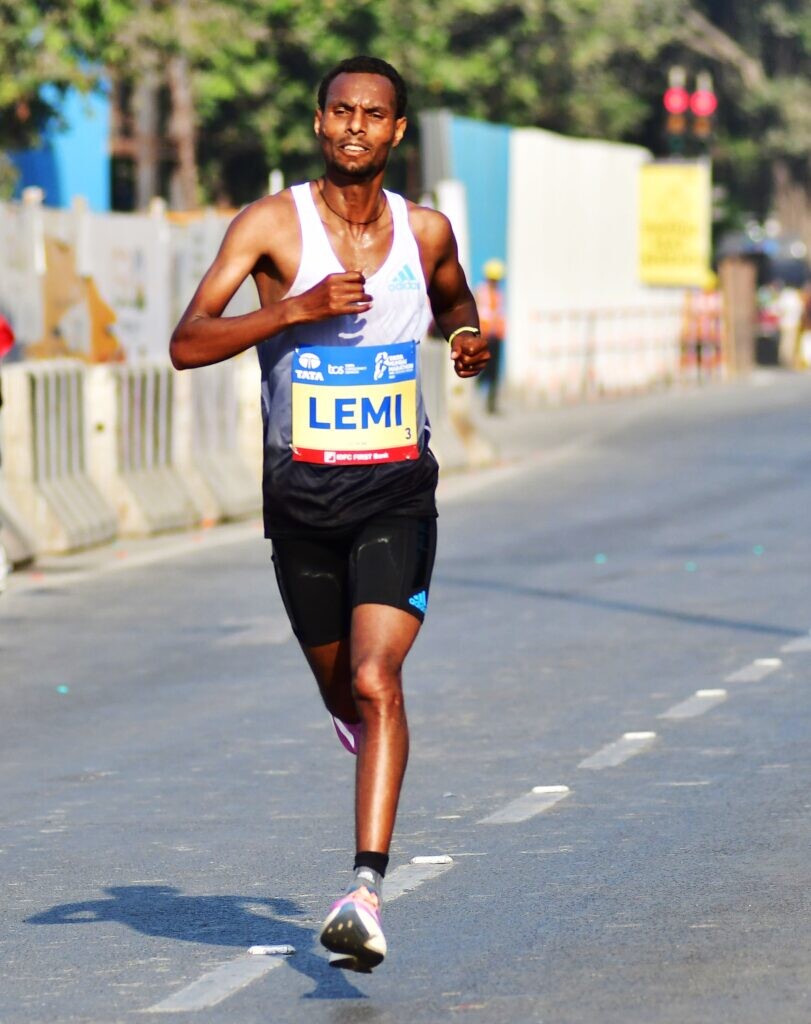
Speaking about returning to the Tata Mumbai Marathon, Hayle said, “I won the 2023 edition of the Mumbai marathon under perfect conditions. It was indeed a surprise and unexpected win at that time. But I want to make sure that I replicate my victory in January as I’m confident of finishing on top in 2024.”
However, it will not be an easy task for either runner to wrest their titles again in 2024. As many as six other men and two other women have superior personal bests in comparison to the current Mumbai course records have entered to challenge the event.
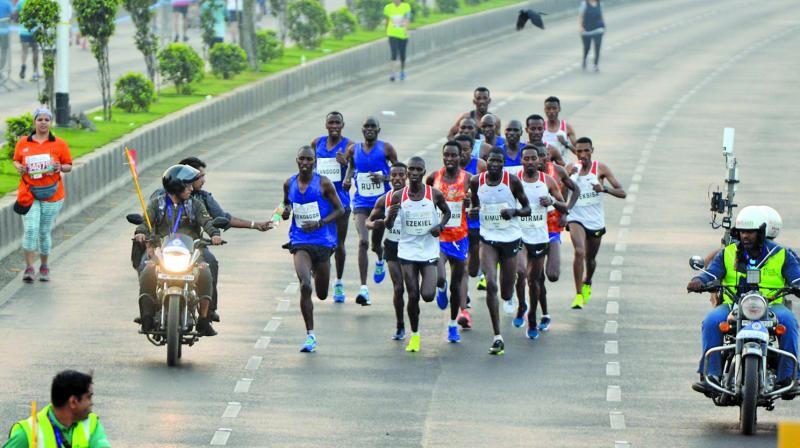
The $405,000 USD prize money event will witness some of the finest athletes take centre-stage at the Tata Mumbai Marathon. The first three in each race stand to win US $50,000, $25,000 and $10,000, respectively. The $15,000 bonus also awaits those who break the existing event records.
Ethiopian Kinde Atanw (30), who is credited with a PB of 2:03:51 — which was achieved while winning the Valencia Marathon in 2019 — will be the leading name among the men. Atanaw finished third during the World 10K in Bengaluru way back in 2014 on his previous appearance in India.
Lelisa Desisa, the 2019 World Champion, together with four fellow Ethiopian runners and Eritrean Merhawi Kesete will give Hayle Lemi a run for his money. Kesete finished ninth in Mumbai in 2020.
Desisa, had his earlier appearances in India through the TCS World 10K Bengaluru, there he finished third in 2011, and in the Vedanta Delhi Half Marathon for three consecutive years (2010-2012, including a victory in 2010) is credited with the second-fastest time (2:04:45) among those men who entered for the 2024 race. On his numerous international ventures, Desisa also captured two Boston marathon wins besides a title victory in New York among the big ones.
The women’s line-up includes two Ethiopians and one Kenyan runner to make it tough for Anchialem in the upcoming race in Mumbai. Tadelech Bekele, the 2018 London Marathon podium finisher, and Sofia Assefa — the 2012 London Olympics steeplechase silver medallist who clocked an impressive 2:23:33 on her marathon debut in Amsterdam this October — will be the main challenge to the defending champion.
Speaking about returning to the Tata Mumbai Marathon, Anchialem said, “I ran my maiden marathon in Mumbai and was lucky to win the race. I am eager to repeat the feat once again in 2024”
Commenting on this year’s field, Vivek Singh, Jt. MD. Procam International said, “The Tata Mumbai Marathon continues to attract some of the finest athletes in the world. It is also a matter of great pride to have our defending champions back and this year, with Kinde Atanaw & Tadelech Bekele we have one of the fastest fields we have ever had at the event. We are sure to have some scintillating action on the course.”
(01/10/2024) ⚡AMPby Christopher Kelsall
Tata Mumbai Marathon
Distance running epitomizes the power of one’s dreams and the awareness of one’s abilities to realize those dreams. Unlike other competitive sports, it is an intensely personal experience. The Tata Mumbai Marathon is One of the World's Leading Marathons. The event boasts of fundraising platform which is managed by United Way Mumbai, the official philanthropy partner of the event. Over...
more...



















